|
STONE HOUSES, MANSIONS AND OTHER
OLD HOUSES |

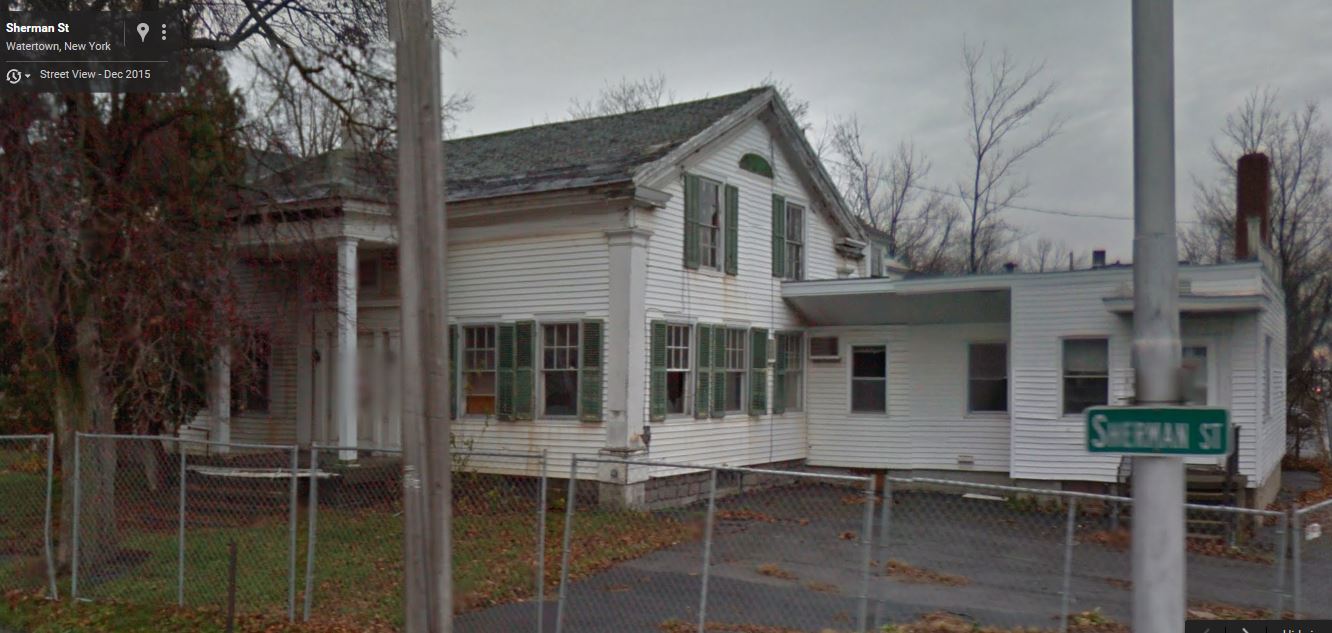
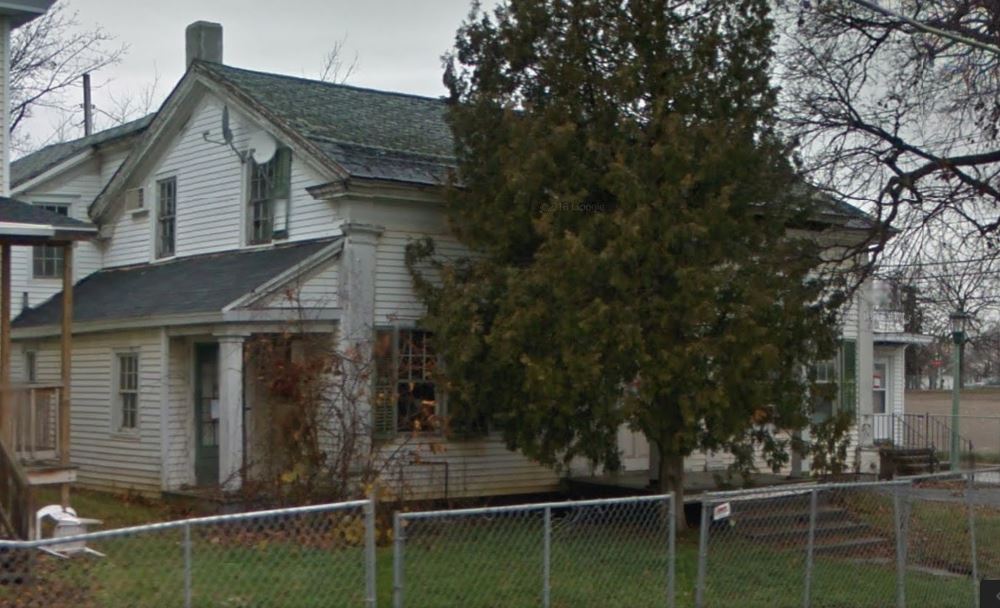
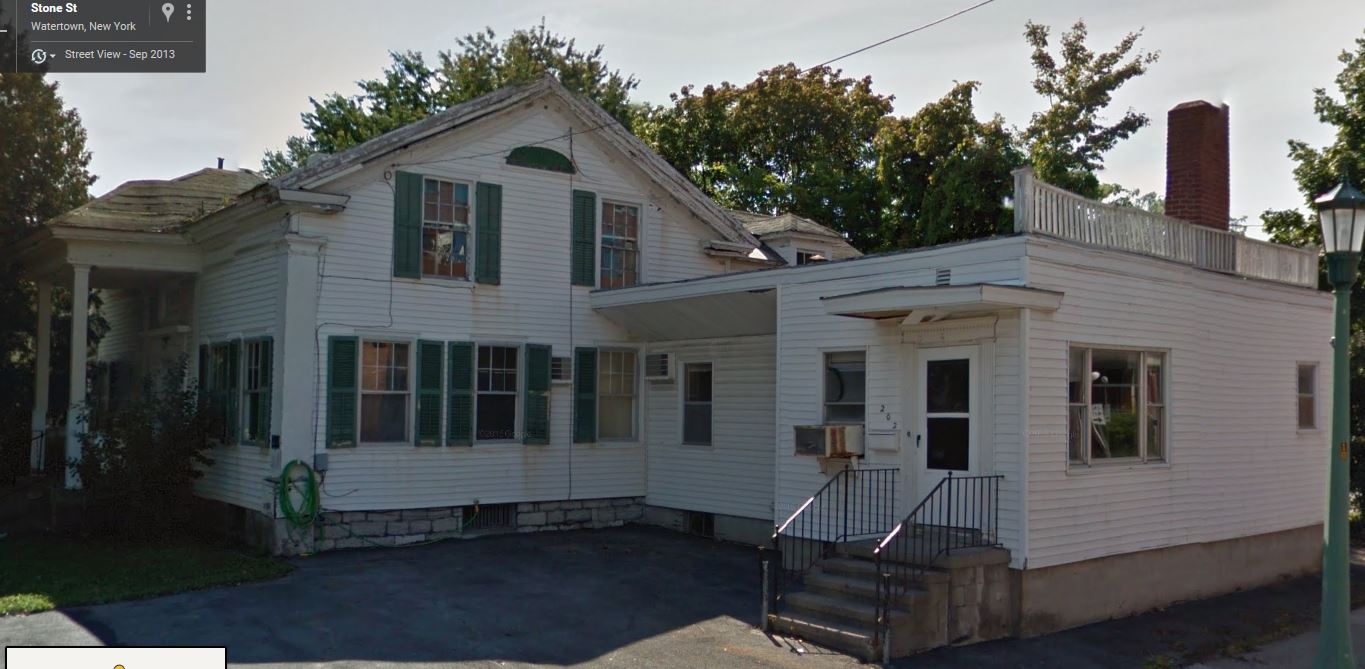
Thousands of people have observed the immaculately white house of wooden construction and gleaming facade at the southwest corner of Sherman and Stone Streets. They have admired its quaint colonial architecture, its low elevation, the beautiful doorway, the attractive balustrade above the front eaves, the pillared portico and the fan shaped gable window. The portico was not originally there, but was constructed as an afterthought a few decades ago. The house, was erected, not in 1838 as family tradition has it, but in 1840 for Stephen Boon Jr, one of the most prominent persons in Watertown's early history. It was first No. 27 and then 31 Stone Street and was one of the first three or four houses on that street. Later, with the addition of the portico, it was altered to front on Trinity Place, now 204 Sherman Street. For the past quarter of a century or more it has been the residence of Mr and Mrs Lucien C Mitchell, Mrs Mitchell having inherited it from her mother, the late Mrs George D (Mary) Thompson, who got it from her mother, Mrs A H Hall, only daughter of Stephen Boon Jr.
Stephen Boon Jr., son of Stephen and Sally Boon, was born July 27 1804 in Manchester township, Vermont. When 14 he walked with Elnathan Matteson, neighbor, through the wilderness from Vermont to Watertown binding himself to work for seven years on Matteson's Coffeen farm for $100 two suits, one pair of shoes and three months' schooling each winter. At the end of that time he taught school a few seasons and April 16 1831 for $800 purchased an acre of land from Elnathan and Lydia Matteson on the west bank of the river in the vicinity of the present Newell Street. In 1832 he married Mary Ann, daughter of Roswell and Innocence Wilcox and had his first residence on the corner of Newell and Lepper Streets.
With his house he had purchased a tannery, which he operated and took
boots, shoes and tea to Canada, trading for goods to sell here. In 1836
he leased the Newell brewery. His first presidential vote was cast for
Andrew Jackson in 1828. The year of the panic, 1837 he took a trip to
Chicago. May 23 1840 he paid $300 to George A and Sarah R Benedict of
Cleveland, OH, and Harriet A and Amelia C Benedict of this city for .36
of an acre of land, site of the gleaming while house on Trinity Place.
For eight years after that he was stockholder and director of the old
Union bank and in 1841 he began building houses here, at one time owning
more than 100 more than anyone else in town. Boon Street was named for
him, Hewitt and other western streets ran through his subdivisions. He
built a school near the present Boon Street school and paid a teacher
for 25 years. He built the Stone City hotel on Court Street in 1837. He
was one of the founders of a Sunday school. In 1846 he was superintendent
of the poor. In 1854 he was appointed state appraiser of bank mortgages.
In 1856 he organized a bank at Quincy, IL, and became its president in
1860-1. Later he returned here and died August 15 1892. Miss Helen Boon,
Mrs Fred B (Charlotte) Pitcher, 208 Sherman Street, and Mrs Edmund G Tucker,
Philadelphia, are grandchildren of Stephen Boon Jr.
These Pictures Taken June 2015:
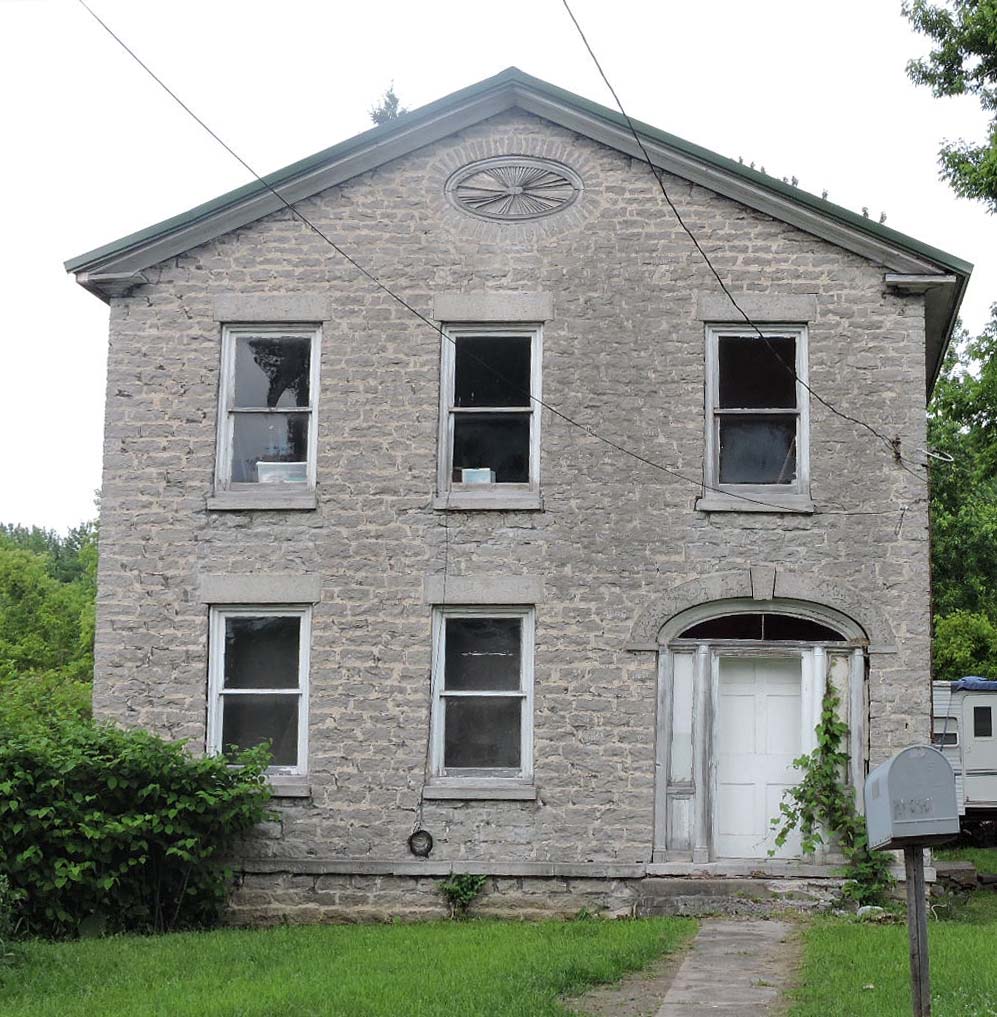
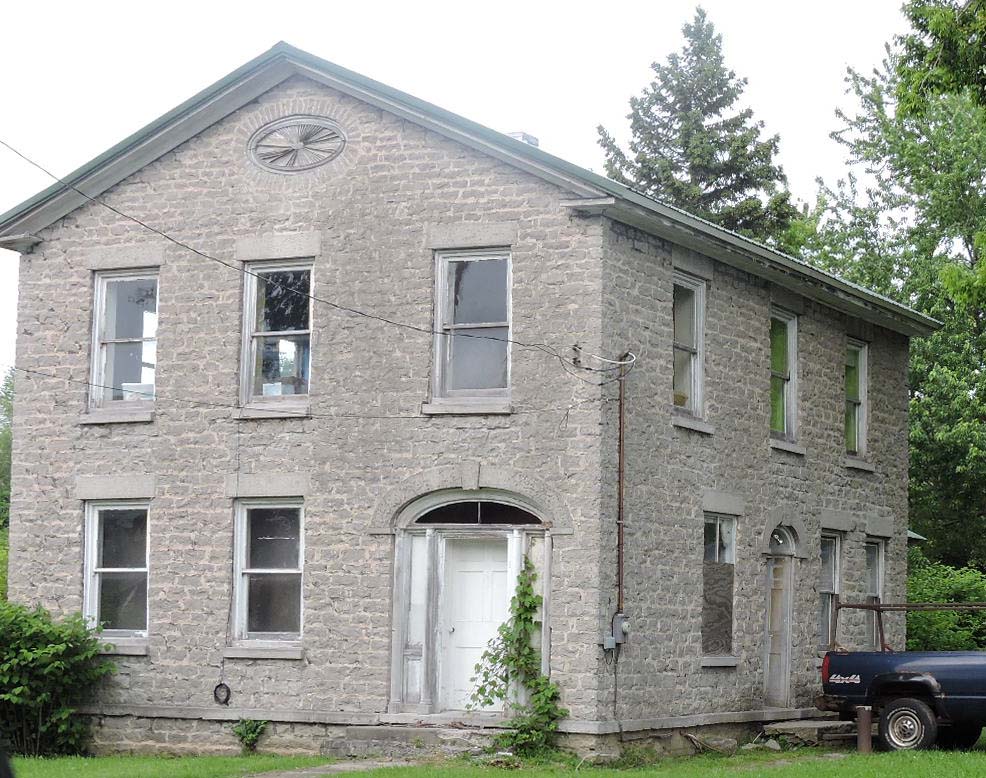
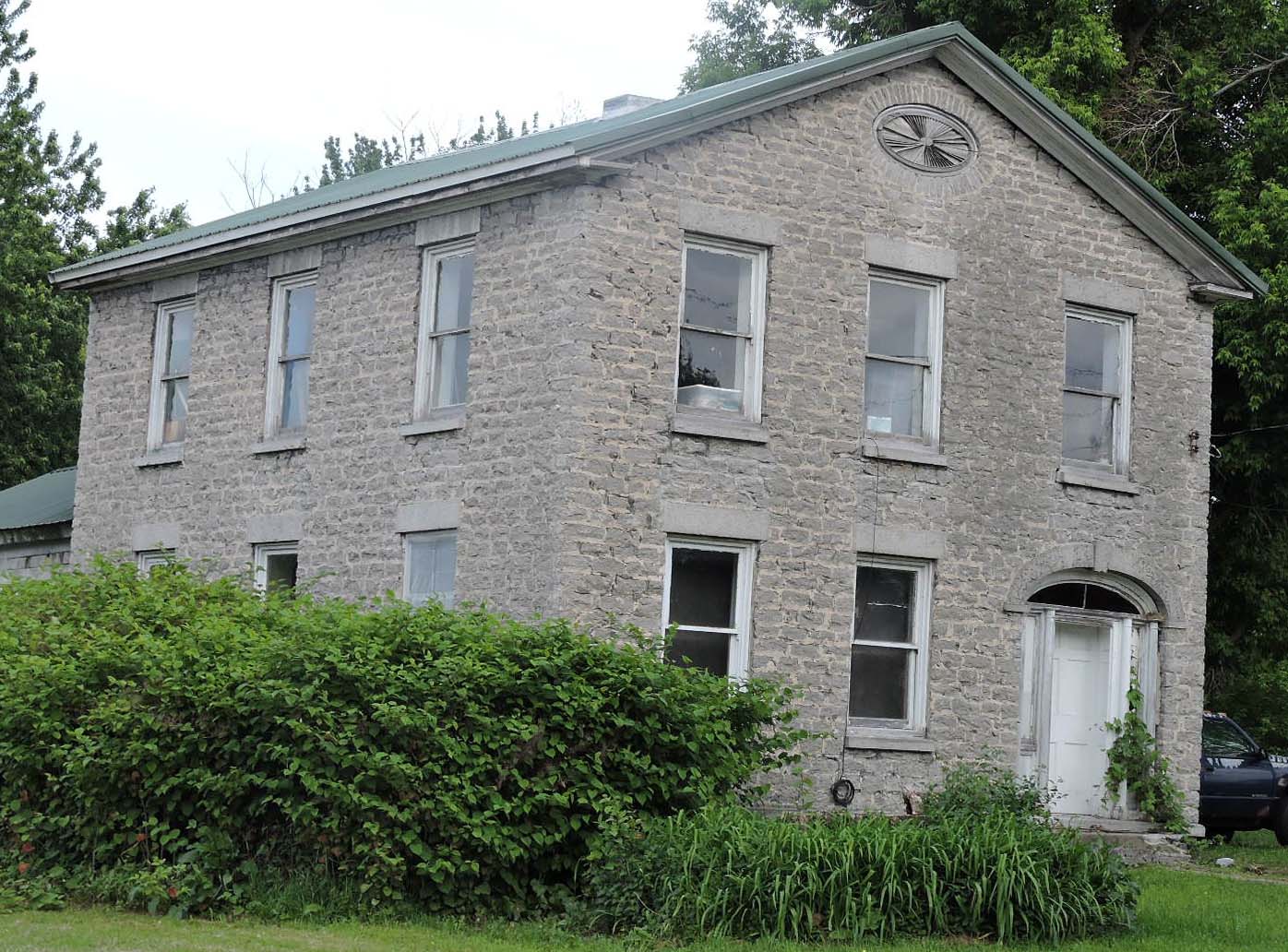
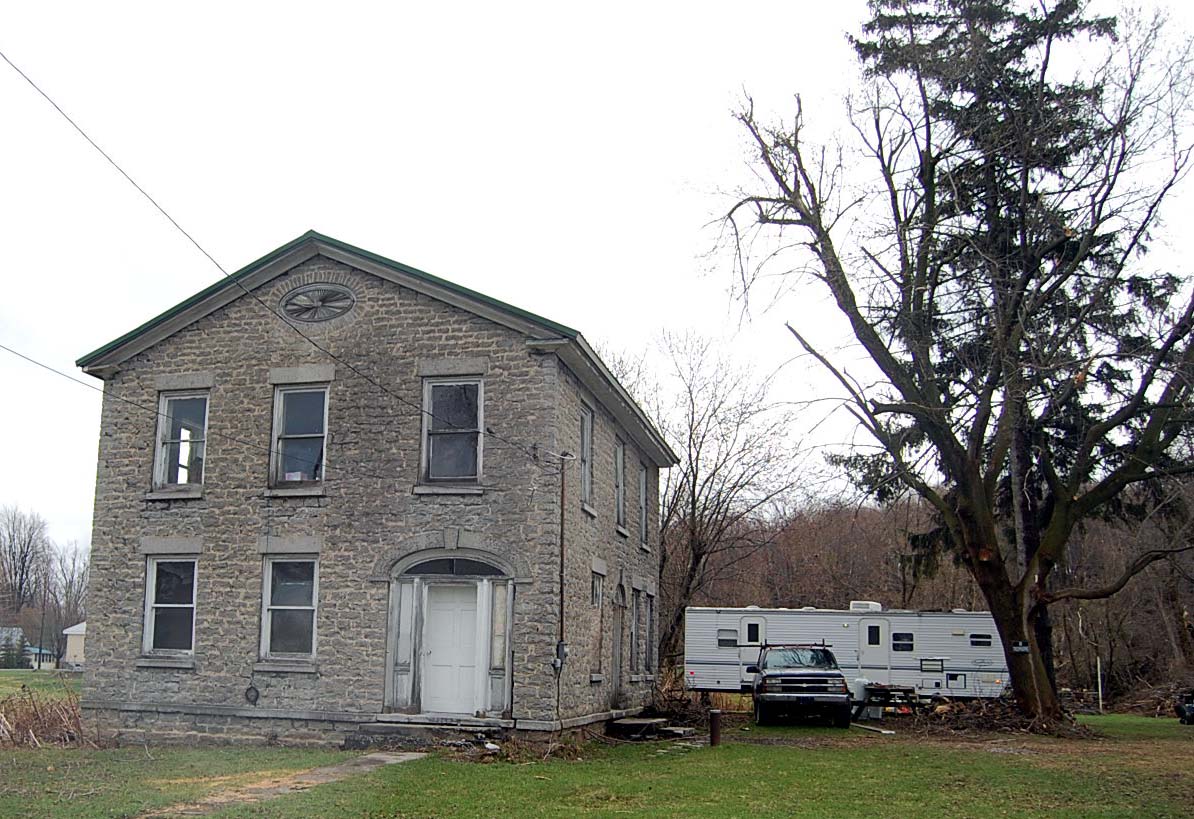
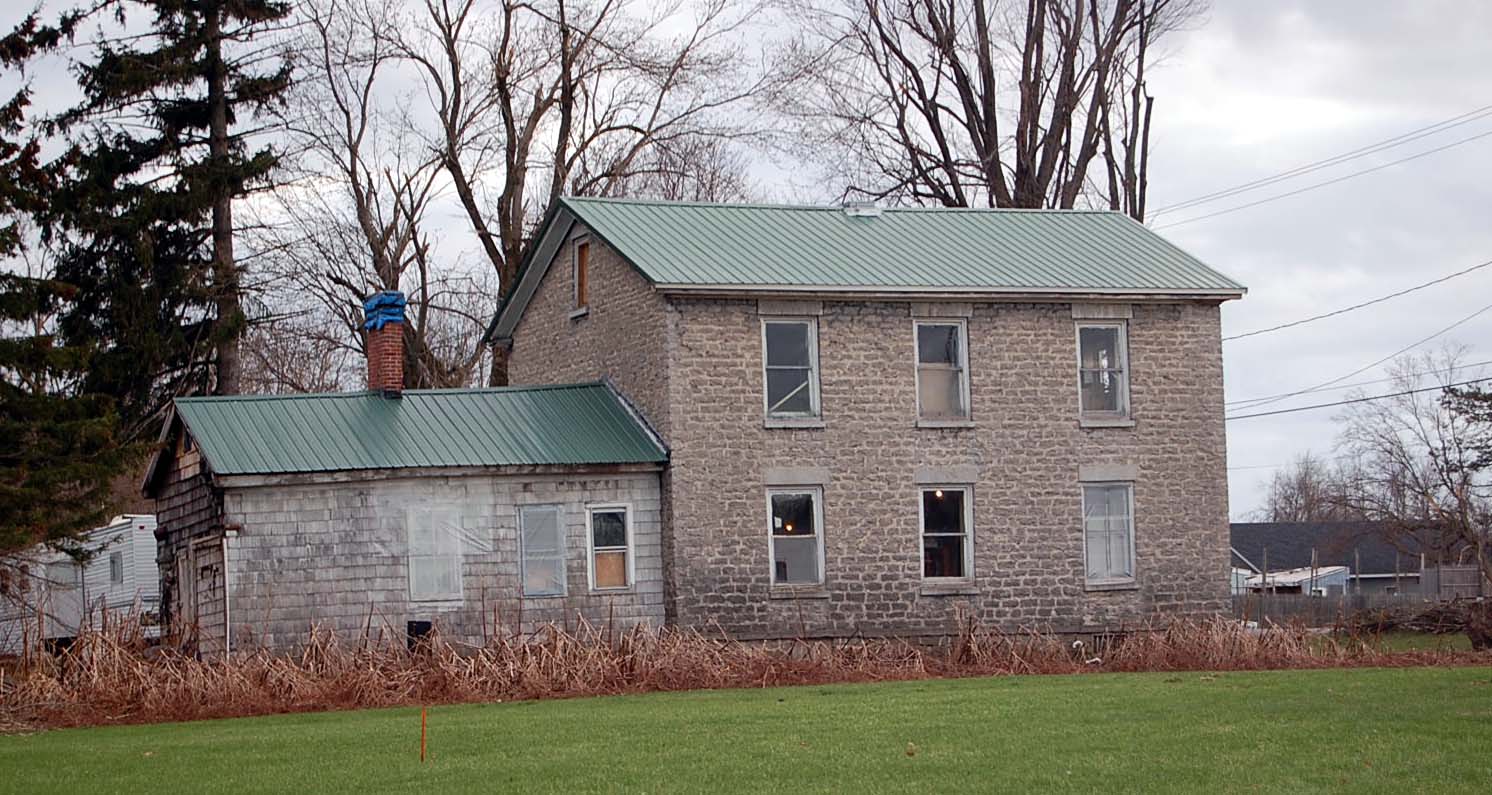
Jesse Smith, for whom the village of Smithville was named, was an interesting Jefferson County pioneer who tarried here about 35 years, amassed a large fortune and moved on to locate in Newark, Ohio, in 1838.
In 1831 he caused to be built in the heart of Smithville the fine stone house, owned and occupied by Fred A and Maybell Green since they purchased it from Reverend Mr Cuthbert C and Virginia Frost, now of Adams, December 1 1941. Jesse Smith, energetic, prosperous and progressive mill owner, distiller, shipbuilder and lumber merchant who, about 1825 collected more than $1,200 daily from his various business enterprises, caused the building to be erected as a storehouse. The architecture is simple Georgian colonial. The front doorway is unusually attractive and the oval louver, horizontally set in the front gable, displays an artistic delicacy of creation which characterizes some other houses in the Smithville-Henderson area, indicating either a common architectural source or an admiration of that type of house-feature by the residents of that section. Just when this building was converted into a residence is not known. In the Civil war period it was owned by John J Green. Title changed a number of times in ensuing years until April 1,1893 when Frank L and Frances Parker of Hounsfield sold it to Miles L Cooper, Judson A Campbell and Robert W Brodie, trustees of the unincorporated Smithville Baptist church and parsonage, which was incorporated January 9 1934.
It became the Smithville Baptist church parsonage and shortly afterward was occupied by Reverend J Foster Wilcox who started his ministerial career in the Smithville and Henderson Baptist parishes in 1894. On January 22 1934 the Baptist Church & Society, Inc., of the town of Henderson sold it to Reverend Mr and Mrs Frost, but for approximately 17 years prior to that it had been used as the village post office. In attempting to make a lawn Reverend Mr Frost discovered a pavement of cobblestones underneath the surface that Jesse Smith had doubtless caused to be laid when the house was constructed.
Unfortunately little has been recorded of the life of Jesse Smith. On
December 1 1804 he was a purchaser of land in the town of Rodman. On February
12 1806 be married Polly Felt and removed to Smithville, where he bought
a sawmill and dam on Stony Creek. He dealt in lumber and potash, built
a gristmill and large distillery shipping his liquors through Sackets
Harbor to Montreal and Quebec. In 1828 he formed the Smith & Merick
partnership with Eldridge G Merick of Clayton sending huge rafts of hewn
timbers to Montreal and Quebec markets from Clayton. In 1832 Smith &
Merick began shipbuilding at Clayton, creating about 70 ships in all,
including most of the steamboats of the old Ontario & St. Lawrence
steamboat Company's line. During the War of 1812 Smith and Colonel Elisha
Camp sold supplies to the army and navy at Sackets Harbor. With Merick
and Azariah Walton he became a founder and director of the Sackets Harbor
Bank April 28 1834. At Newark, OH, he lost his fortune in 1847 removed
to Peru, IN, in 1858 and died there January 7 1867. He was born in Massachusetts
February 25 1784. His father, Captain Ezra Smith served at Lexington

The story of the origin of this stone house is elusive It stands on the
east side of Main Street in the village of LaFargeville and is believed
to have been erected about a century ago. The front entrance with its
pediment casing and recessed doorway is handsomely wrought. Since they
purchased it April 8 1942 from E Gay and Eleanor Brush it has been the
residence of Dr and Mrs Thurston W Haller.
A half century ago it was the home of Russell B and Martha Ann Biddlecom. Mr Biddlecom was one of the outstanding residents of Jefferson County six to nine decades ago. A former acting Whig he helped form the first Jefferson County organization of the Republican party in 1855. In 1858-1860 inclusive he was county clerk. In 1864-5 he was assemblyman from the county's third district. Prior to that he served a year at the front as a captain in the 10th NY Heavy Artillery and early in the war, commissioned a colonel by Gov. Morgan, aided in organizing 16 companies of 2,400 men from Jefferson and Lewis counties. For five years from 1865 to 1869 inclusive he was supervisor of the town of Orleans. In 1870 he was elected a director of the company that built the Theresa & Clayton railroad, was appointed superintendent, secretary and treasurer and October 4 1887 was elected a director of the reorganized First National Bank of Clayton.
Mr Biddlecom was born March 19 1822 at Deerfield, Oneida county, son of Charles and Rhoda Biddlecom. His father died in 1829 and he went to live with a brother. In 1835 he emigrated to the town of Orleans, attended school there and for three months at the Union Academy at Belleville. From 18 to 30 he taught school. For eight years from 1844 he was town school superintendent and from 1849 to 1857 was justice of the peace. September 18 1845 he married Martha Ann Richardson. In 1848 he was founder of the Orleans academy. For many years he was a LaFargeville merchant.
August 29 1888 Mr Biddlecom purchased the stone house from Guvera H and Elen Marshall, who had owned and occupied it since June 14 1855 when they bought it and .6 of an acre of land from Elisha and Adelia Sawyer of Carthage for $800. Mr Marshall was also a prominent resident of LaFargeville and for a time was a director of the First National Bank of Clayton. Apparently Elisha Sawyer purchased the property January 1 1851 from Hiram Dewey, who was another prominent LaFargeville resident, who bought a considerable acreage from John and Louisa LaFarge March 1 1838 and later became one of the incorporators and heavy stockholders in the Agricultural Insurance company.
Russell B Biddlecom resided in this city during the three years he was county clerk and during the last four years of his life had a house at 62 Franklin Street, near Keyes avenue. He died May 10 1894. It is said that the first children to reside in the stone house at LaFargeville are Marcia Jean Haller, 4 and Sally Ann Haller, 1 1/2. Dr Haller is a veterinary, son of Supervisor Frank W Haller of Orleans.
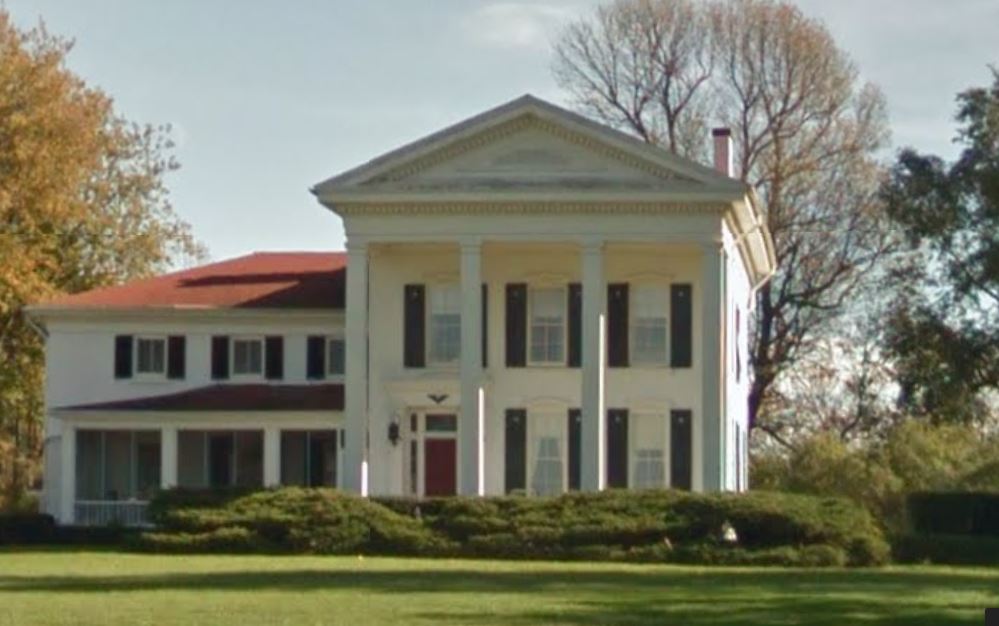
"Beechwood", originally the estate of Henry Crevolin and his
wife, the former Annette Dumastier, of that historical band of Napoleonic
refugees who established themselves in this county after Waterloo, it
is one of the most alluring in the county. Said to have been built about
1840 and rebuilt in 1854 after a devastating fire. Its brick construction,
now painted a gleaming white, follows the colonial pattern. Across the
main front extends a deep, two-stored portico with finely proportioned
pediment supported by four tall, square pillars. The main entrance leads
from the portico into the left side of the body of the mansion.
From a commanding elevation on a site of 10.08 acres at the joining of
the Pleasant Valley and Broadway-Tibbett's Point roads, the mansion gazes
with placid dignity northward across the green St. Lawrence towards Kingston,
Ontario Far back from the main highway, a broad, deep lawn threaded with
a curving drive and studded with magnificent trees rolls down from the
front of the house to the river. Today it is the residence of Colonel
and Mrs Harold Remington, former owners of the LeRay mansion, having been
purchased by Mrs Remington April 19 1942 from Albert J and Emmabelle Phinney
of Santa Monica, Calif. Adjoining the grounds was the farm of Count Pierre
Francois Real, was built the Cup-and-Saucer house as a haven for the great
Napoleon. Nearby were the buildings, the track, etc. of the Cape Vincent
fair.
The mansion contains approximately 16 rooms and has fireplaces in some of the principal ones. The site was originally part of the LeRay holdings and was included in a sale by Vincent LeRay to John Duvillard October 31 1831. John and Martha Duvillard sold it to Theophilus Peugnet, an adherent of Napoleon, December 12 1835 and December 1,1836 it was purchased from Peugnet by Henry Crevolin, prominent Cape Vincent resident and wealthy landowner for many years. A son, Henry Joseph Crevolin who died suddenly March 16 1887 was a prominent merchant and steamship agent at Cape Vincent and in 1884 caused to be erected the St. Lawrence hotel, a fine brick structure on the southeast corner of Broadway and Market Streets. It was not a financial success and was bought by E D Fox in 1887. Its original cost is said to have been upwards of $60,000. Many years ago it was destroyed by fire, but prior to that the name had been changed to the Algonquin.
But concerning "Beechwood,"' the old Crevolin homestead, there
have been a number of changes of title through the decades and it is interesting
to note that for a period of a few years it was owned by the Sisters of
St. Joseph of Watertown for use as a school or convent. The Sisters acquired
it February 4 1887 but July 8 1891 sold it to Cornelia A Fox, a member
of the Crevolin family. Next it was owned by Robert M Boyd Jr. Montclair,
NJ. There are many descendants of the Crevolin family in this city and
in the county at the present time

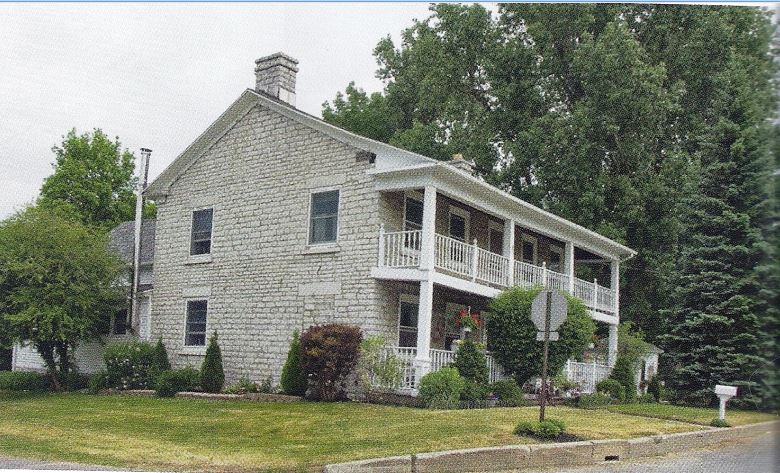
Relic of those early North Country stagecoach days of 123 or 124 years ago Greystone Inn, at the five corners called Clayton center, lies off the beaten trail. Heavily clad with woodbine, dark green in summer and flaming red in early October, it presents a gorgeous spectacle six months of the year. Its walls are of native limestone and a double decked verandah with its second-story spindle rail stretching across the entire front makes it especially attractive.
Almost a century and a quarter old it has catered to the public need a goodly share of its existence. Lying as it does to the eastward of the state highway between Depauville and Clayton, it is about equally distant from both those villages and in the olden days was a favored stop between Clayton, LaFargeville, Theresa and the route onward to Ogdensburg. In those days also its ballroom, now bedrooms, on the second floor was the scene of many an enjoyable ball and dancing party featuring polkas, schottisches, minuets and many of the other old picturesque dances. Mrs Fred (Elma S) Dillenbeck, present owner, has possessed it since the early years of the present century having acquired it from Merritt Lingenfelter, who also had owned it for a long period. Prior to that it had been the property of A I Barney and before that of Preston Ellis. Until the global war upset automobiling, tourists swarmed to the place.
Back in the horse and buggy days, particularly the early days of horse-drawn traffic in this region, Greystone was on the main route between Clayton and Depauville on the way to Watertown and of course enjoyed wide popularity. Many of the pioneer families of Clayton township resided m its vicinity and it was a spot of genuine beauty along the countryside as well as a social center and hostelry for the traveling public. That traveling public a century ago included not a few landowners and land-agents accompanied by prospective buyers from the Mohawk valley and from New England. But aside from them there were not a few personages of distinction from the metropolitan area up to see the sights of this wilderness region.
To Greystone and through Clayton Center also traveled many of the French émigrés who established themselves in the quiet, beautiful solitudes of the region between Clayton village, then French Creek, and Cape Vincent to be beyond the reach and molestation of the powers of the British empire and the anti-Bonapartist regime in France.

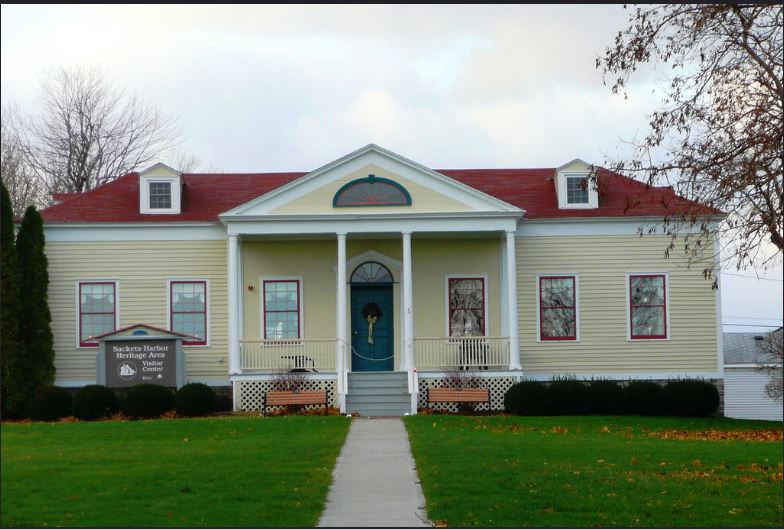
Facing Market or Custom House Square, which is a deep broadening of Main
Street, Sackets Harbor, the Augustus Sacket mansion is perhaps exceeded
in age by only one other house in Jefferson County. It is of low, story-and-a-half,
wood construction erected in 1803 it is claimed, and overlooks the harbor.
It is steeped in colorful history.
Augustus Sacket, lawyer, native of New York City, founder of Sackets Harbor,
first collector of customs at that port, first county judge of Jefferson County, was its first owner and occupant.
It was in 1801 that young Sacket purchased a large tract of land in Hounsfield
and came on to settle it. But he remained in the county but a short time,
removing to Jamaica, Long Island in 1809. By 1812 he had gone to Meadville,
Pennsylvania, to take up a 300,000-acre tract and by 1820 he had acquired a huge
tract in Rutherford county, NC. He died suddenly in Albany April 29 1827
while returning to Sackets Harbor. The outbreak of the War of 1812 on
June 18 of that year found Sailing Master William Vaughn, U S N and his
small, delicate wife occupying the Sacket home. Then early Sunday morning,
July 29 five British ships of war led by the Royal George were spied off
Stony Island heading in to attack. Captain M T Woolsey moored the U S outside
Navy Point with a broadside of nine guns pointed towards the enemy. Meanwhile
he stationed Sailing Master Vaughn farther offshore on the bluff to command
the "Old Sow," lone 32-pounder placed there. But with only 24-pound
balls wrapped with carpet she was able to do little damage. Finally a
British 32 shot came over ploughing a furrow in the lawn in front of the
Sacket mansion. Sergeant Spier grabbed it up, Sailing Master Vaughn ordered
it rammed into the "Sow" and shot it back. It raked the Royal
George from stern to stem killing 14 and maiming 18 British sailors. Then
the British fleet fled back to Kingston. In that two-hour battle Vaughn
is said to have fired the first hostile shot in the war. When peace came,
Vaughn piloted a half dozen steamboats on the lakes many years. He died
December 10 1857 but his little widow lived several years afterward in
the Sacket mansion, the second floor of which, lighted only by dormer
windows, was used for hospitalization in the War of 1812. The mansion
is of plain, simple architecture with a small portico and pediment supported
by small, well-turned pillars.
Originally the Sacket mansion occupied a whole block. It was eventually
sold to Bernard Eveleigh, for whom the Eveleigh hotel was named and was
inherited by his daughter, Mrs Amos Membery Marsh, who died in 1926 aged
85. Her husband, granger and justice of the peace, took a life-use, but
after his death March 11 1931 the property went to Mrs Elizabeth Stratton,
who still owns it.
Neat and attractive in appearance is the old Elijah Horr native limestone mansion of Georgian architecture at Stone Mills. Manor of a 325-acre farm it stands far back from the old LaFargeville-Brownville highway with a deep lawn in front and for the past 30 years has been owned by Dr and Mrs Arthur L Tinkess who purchased the property February 28 1913 from David H and Elizabeth S Schell. When the house was built is not exactly known, but it is believed to have been ejected over a century ago for Elijah Horr, an early and prominent Stone Mills resident, who has a number of descendants in the county today including the Bonney family of this city. Elijah Horr purchased land from John and Louisa LaFarge as early as March 1 1834 and it is likely the mansion was constructed not long after that.
The arched lintel over the main entrance in the middle of the front indicates that the door had fan and side lights, which have since been blocked out with stone at some time to make a narrower doorway.
For the nominal sum of $20 Elijah Horr in 1855 deeded part of his farm
cast of Stone Mill creek to his son, Benjamin Stiles Horr, grandfather
of the Bonneys. At about the same time be conveyed the other portion of
the farm containing the mansion to his other son, Peter Horr, who at one
time resided in this city, and headed the local Masonic lodge and other
Masonic bodies. Eventually he removed to Chicago.
Elon G Brown and Charles Baldwin bought the mansion property March 25
1868 from John Lansing, executor of Peter Horr's estate and exactly two
years later Mr Brown sold his interest to Mr Baldwin, who, with his
wife Mary conveyed it May 1 1873 to James L Collins. From the Collins
ownership it went to the Schells. This Collins ownership is significant
from the fact that J B Collins, an antecedent of James L, was a partner
of Peter Pratt, which firm in 1820 built the stone grist mill that caused
the hamlet of Stone Mills to be originally known as Collins Mills. In
1837 a settler named, DeRahm laid out an acre of land upon which the large
stone church was erected the same year and the stone schoolhouse the following
year. The Horr farm is near that acre and across the road from the Horr
mansion is the old stone store conducted by John Irwin for the past 60
or more years.
Stone Mills lies in the south central part of the historic Penet Square
and is in the town of Orleans. The first settler was Roderick Frasier
in 1806 and the second one was Peter Pratt in 1807. At that time that
area was filled with Squatters, who came from the Mohawk valley to clear
the land, sell square timber and potash
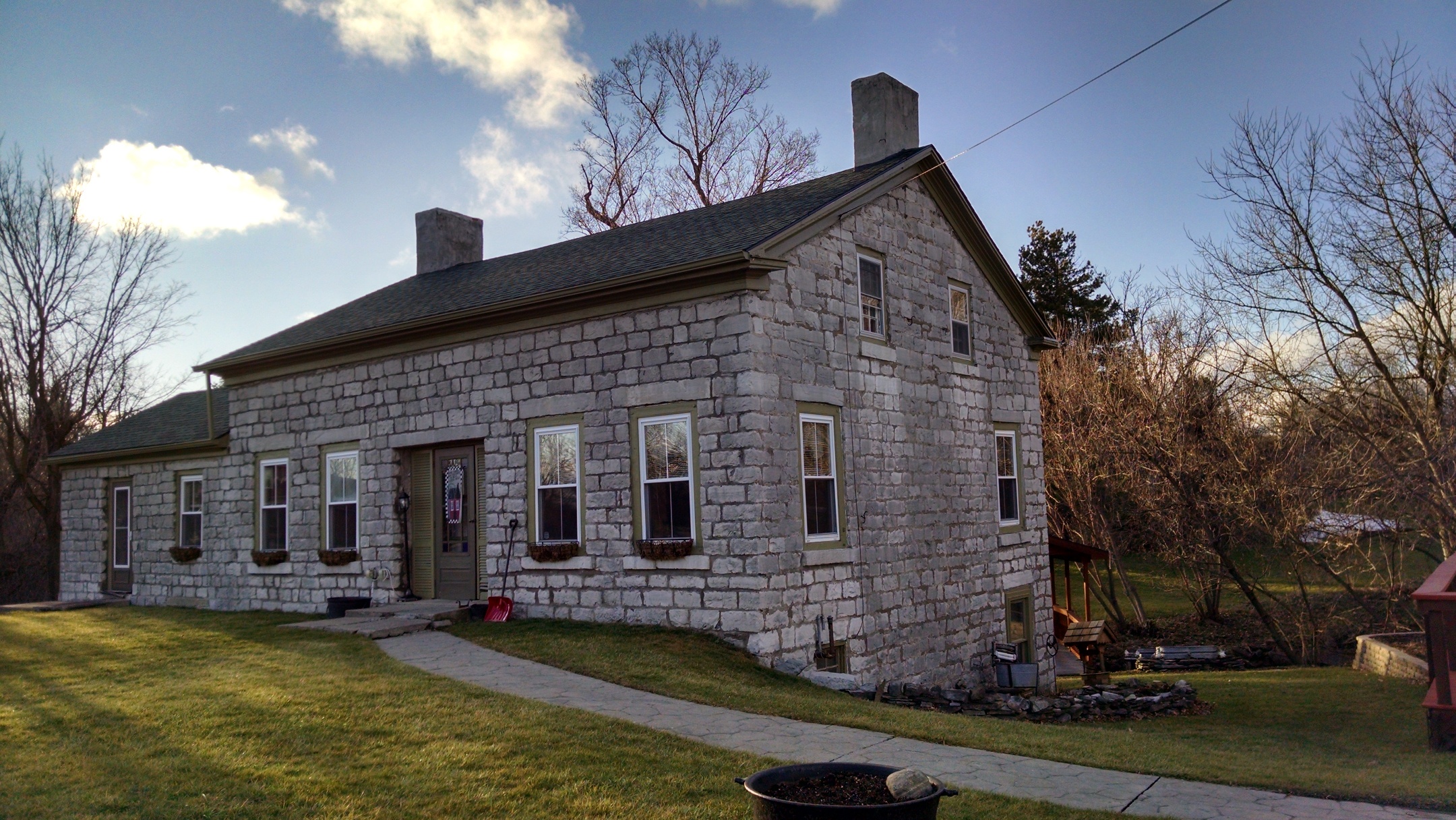
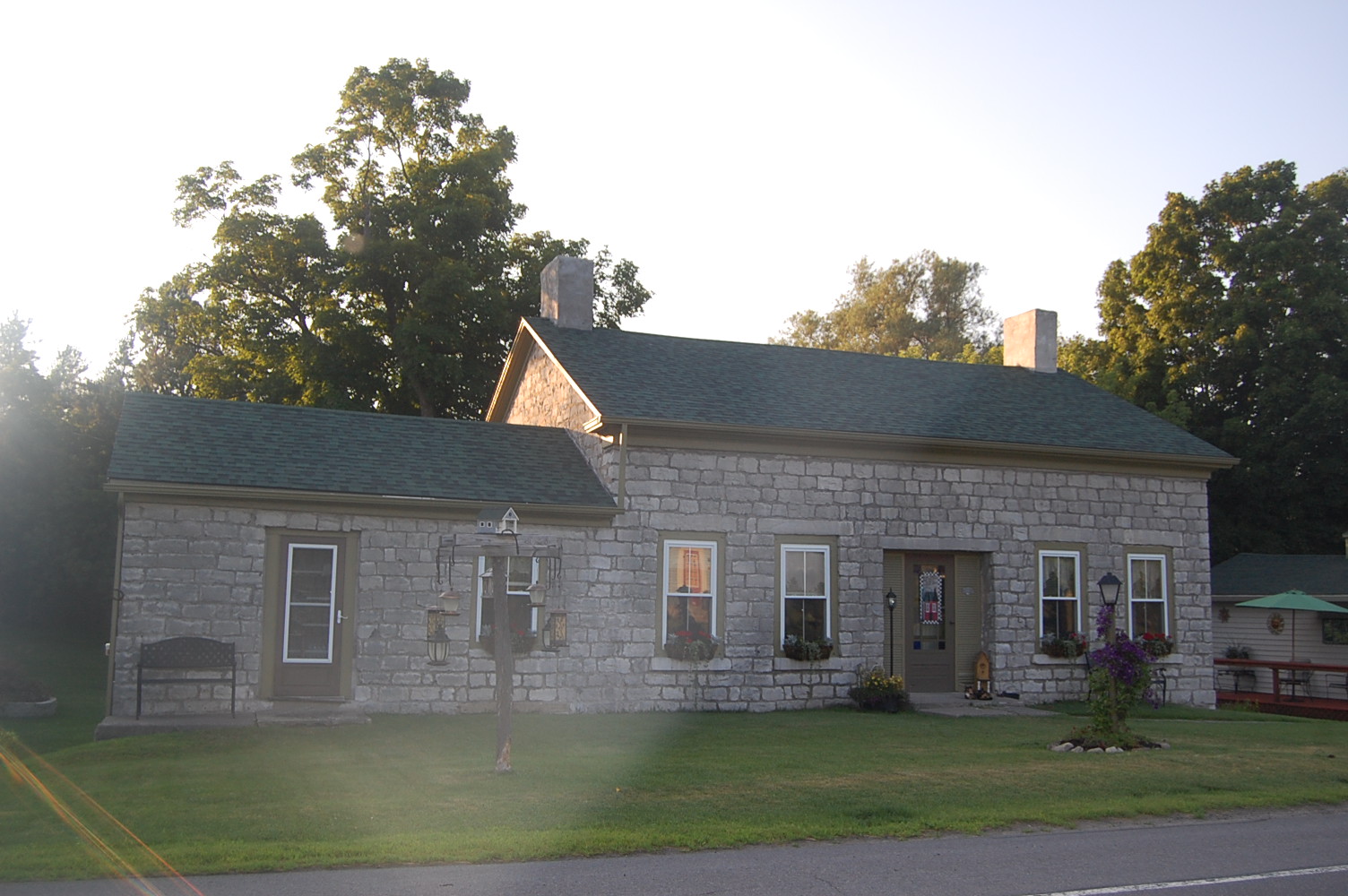
Pamelia Four Corners is one of the quaintest hamlets in the North Country.
It is located at the intersection of the old Sackets Harbor-Plattsburgh
military road and the highway that runs from Evans Mills to Watertown-Clayton
state route. This old military road was started in 1819 as the result
of President James Monroe's inspection of northern New York in 1817. This
end of the road was constructed by Madison Barracks soldiers.
Pamelia Four Corners is six miles from Watertown and is the scene of a
fine old stone tavern that is now the grange hall, a stone store and many
most attractive stone houses. The whole Pamelia township is under laid
with vast limestone deposits, much of it the hard, flinty, Birdseye type,
which frequently crop out on the surface. Original settlers of the Pamelia
Four Corners area built their homes of log in the early years of the 19th
century, but about 1830 those log buildings began to be superseded by
more pretentious ones of stone, which was so abundant that their construction
was almost as cheap as wood.
On the northwesterly side of the military road only a few rods towards
Brownville from the stone store stands a low stone house of most simple
and captivating design. For the past several years it has been owned by
James T Savage. The year of its construction is unknown, but it is believed
to have been in the 1830s.
It is known to some as the Harger house and is near the old medicinal
spring. The Hargers were one of the prominent families of Pamelia Four
Corners. Abraham M Harger erected the stone hotel there and in 1837 seven
years after the establishment of a post office, he was the postmaster.
At one time he conducted an extensive meat packing business where the
old stone store is and in 1850 he was the supervisor of Pamelia. Another
Harger was Wilson H Harger, who died in March 1846 and his brother, Charles
G Harger, who is said to have owned the house shown above, was one of
Watertown's bankers shortly after the Civil War, having established the
banking house of Charles C Harger & Son at 5 Court Street in 1866.
This bank suspended at the end of about ten years. At Pamelia Four Corners
Charles G Harger had been a successful merchant. After finishing his banking
career he bought a farm about seven miles from Theresa and resided upon
it twelve years before retiring to Theresa village, where he died January
29 1901 at the age of 91. Today the Harger house at Pamelia Four Corners
seems as stout and true as ever from an exterior aspect and its rectangular
front doorway continues in its original beauty and with its sidelights
but no transom window. The limestone walls are of lasting material and
careful construction.
On the old military highway a few miles toward Watertown from Evans Mills
is the limestone house of Arthur Bowman. Its design is plain but exceedingly
attractive and located on the south side of the road it is back of a regularly-spaced
row of old maples, arranged like soldiers on dress parade.
In autumn, when the leaves are at the full height of their color, these
maples are crowned in beautiful canary yellow and the fallen ones on the
lawn beneath are woven into a brilliant carpet of the same color. Together
the tree-crowns and the leaf-carpet reflect a warm, inviting glow upon
the staunch gray walls of the solid old house. This house is approximately
a century old, but neither the name of the builder nor the date of construction
is known to the present owner. It is large and commodious. Originally
it had in use two fireplaces served by stone chimneys. The front doorway
is plain and rectangular without ornamentation, but the door is attractive.
With the house is a 100-acre farm, all of which was willed to Mr Bowman
by his father, Simon P Bowman, prominent town of LeRay farmer, who died
October 8 1910 at the age of 66 years one month and nine days. His wife
was the former Miss Mary E Timmerman and his father was Elias Bowman,
one of the early LeRay settlers.
Elias Bowman died March 13 1882 in his 69th year. Several Bowmans have
been and are still residents of that section of the county. That area
lies in the county's rich limestone belt, which has yielded much fine
building stone for the houses and buildings of the region. Unquestionably
the stone for the Bowman house was quarried nearby and it is of fine quality,
of good color. The craftsmen, who laid it up were masters of their trade
and the result is a building that will last a century or two more under
the same good care that it has thus far had, for it has been maintained
clean in appearance and kept in fine repair.
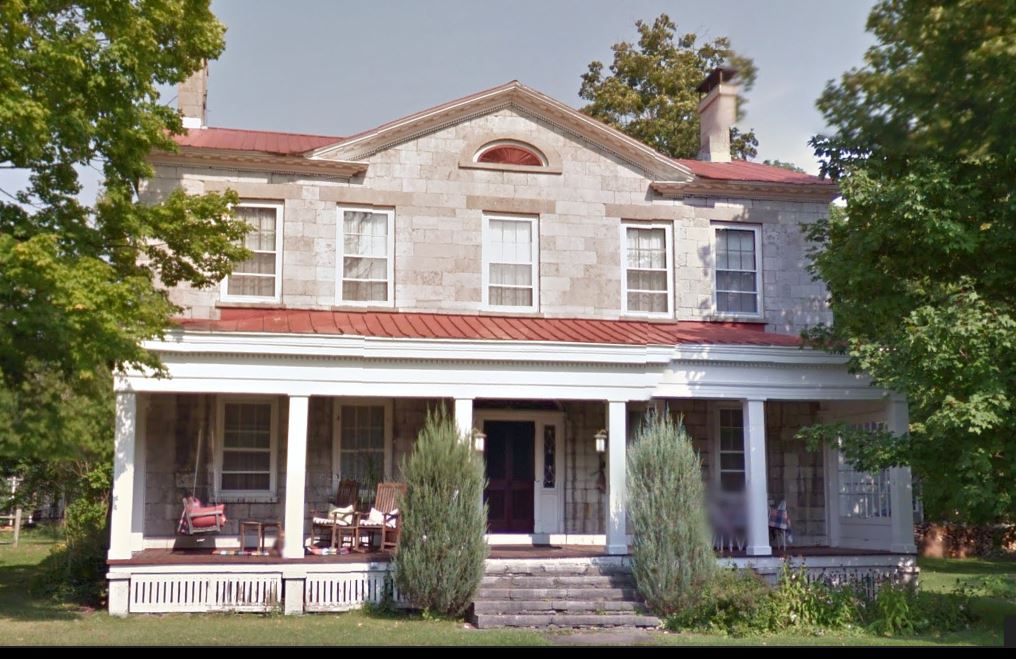
George Stephens Reed's Georgian residence built in 1821 on Park place, Lowville, for Isaac W Bostwick, noted north country lawyer and land agent, is one of the finest and best-kept of historic upstate mansions. Skilled English master masons, who had constructed beautiful Constable Hall at Constableville, fashioned it from Boonville limestone quarried at Talcottville, whence also came the stone for Constable Hall Native of Watertown, CT, Isaac W Bostwick studied law in Oneida county, was admitted in 1801 moved to Turin in 1804 and to Lowville in 1806. Land agent for Nicholas Low, Richard Harrison and Hezekiah B Pierrepont, he sold most of the land in the towns of Lowville, Harrisburg, Denmark, Martinsburg, Watertown and Adams. Married to Hannah, daughter of Captain Isaac Perry of Lowville, he became Lowville's surrogate, president of the Lewis County Bank and the Bank of Lowville trustee and president of Lowville academy, was a member of the Presbyterian church and died January 2 1857.
In 1821 shortly after his mansion was completed, Rachel, an 18-year-old
servant, attempted to fire the house and a huge charred beam in the cellar
is yet evidence of the fact. Arson was then a capital offense and Rachel
was first in Lewis county to be tried for a capital crime. Micah Sterling
of Watertown and Russell Parish of Lowville defended her. A defective
indictment saved her life, but this Negro girl died in prison. Bostwick
willed the mansion to his widow, who left it to Lowville academy for a
girls' seminary and it was so used about two years, but relatives attacked
the will and the ensuing trial was one of the most famed in Lewis county
annals. The property was sold at public auction to Ansel Foster, great
uncle of the present owner. Mr Reed's father, Attorney Timothy Miller
Reed, bought it of Mr Foster 57 years ago and George S Reed has resided
there since.
The mansion has 25 rooms, four beautiful fireplaces and originally included
a bake-oven. The front door and doorway is one of the most beautiful in
the state. Original leaded-glass fan and sidelights border three sides
of the door. The huge, original iron lock with big bronze key is still
on the inside of the door. On the outside is a beautiful polished silver
knocker. George Stephens Reed is a graduate of Hamilton college, studied
law, was admitted about 40 years ago, was confidential clerk to Supreme
Court Justice Edgar S K Merrell 1918-1924 has been United States commissioner
for Lewis county, is trustee of the Lowville Library association, trustee
of the New York State Power Authority since August 1934, past president
of the Bar Federation of the Fifth Judicial District, trustee of St. Lawrence
university since May and is a prominent Democrat. His wife is the former
Miss Mildred E Wright and their children Aviation Cadet George B Reed,
William Reed, student of Princeton; Amy Reed, student at Wellesley, and
Miss Cynthia Reed are the only children, who have been born in the old
house
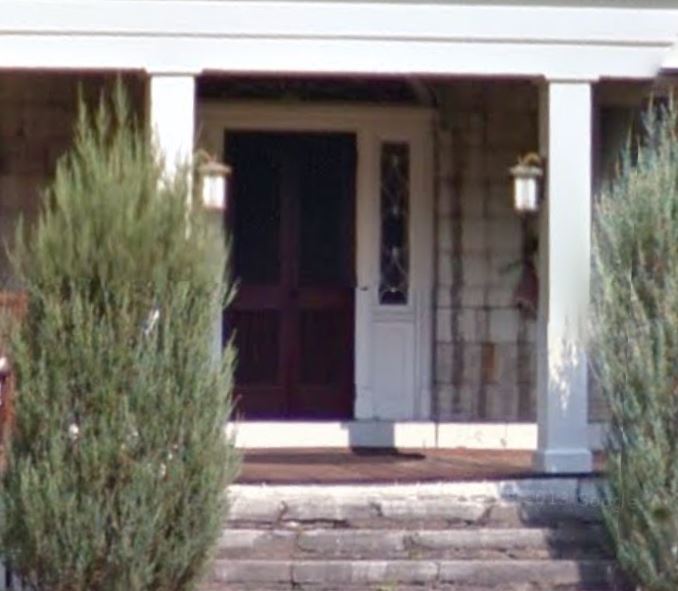
No more beautiful example of an attractive Colonial doorway is to be found than that, which graces Lowville's old Bostwick mansion now owned by Attorney George S Reed, member of the board of trustees of the New York State Power Authority. The facade of the house was shown last Saturday. A close-up of the door, stone steps , and part of the verandah is given today to illustrate the beauty and purity of architectural detail.
The door is of simply-designed six-panel type. Upon t is a handsomely-created polished silver knocker. Over the entire doorway is the original leaded glass fanlight, created in a graceful elliptic. The sidelights on either side are also of the original leaded glass, in artistic geometrical patterns. The original twelve-paned windows, six to each sash, are also in the house. It is interesting to note that names have been written with a diamond on the sidelight at the right of the door and that one of these names is G DeFeriet from New Orleans, is listed as one of the students of Lowville academy in 1826 five years after the Bostwick mansion was built, and was of Mdm DeFeriet's family. Mme. Jenika DeFeriet said to have been a lady in waiting to Queen Marie Antoinette of France, came to this country with the LeRays in 1816.
Mdm. DeFeriet had a beautiful pillared mansion overlooking Black River at what is now the village of DeFeriet. The town of Lowville was formed March 14,1800 from the town of Mexico, Oswego county. The first town meeting was held at the house of Silas Stow, agent for Nicholas Low, proprietor of the township. At that first meeting Captain Isaac Perry, Rhode Island native and Revolutionary veteran, who arrived in Lowville in June 1799 was elected one of the highway commissioners. He was the father of Hannah Perry, who became the wife of Isaac Welton Bostwick, September 29,1812 owner of Mr Reed's present home.
Two St. Regis Indian cabins stood on the site of the Bostwick mansion,
one of the cabin occupants having been known as Captain "Joe."
But today's concern is with the front entrance to the Bostwick mansion.
Twelve-sided, white Doric pillars support the entablature of the long
portico that spreads across the entire front of the house. The architrave
appears to be three tiers of clapboards, but is in reality one thick timber
so cut as to give the clapboard appearance. The dentils of the cornice
display the workmanship of accurate craftsmen. Architects of note have
declared this mansion one of the finest in the North Country.
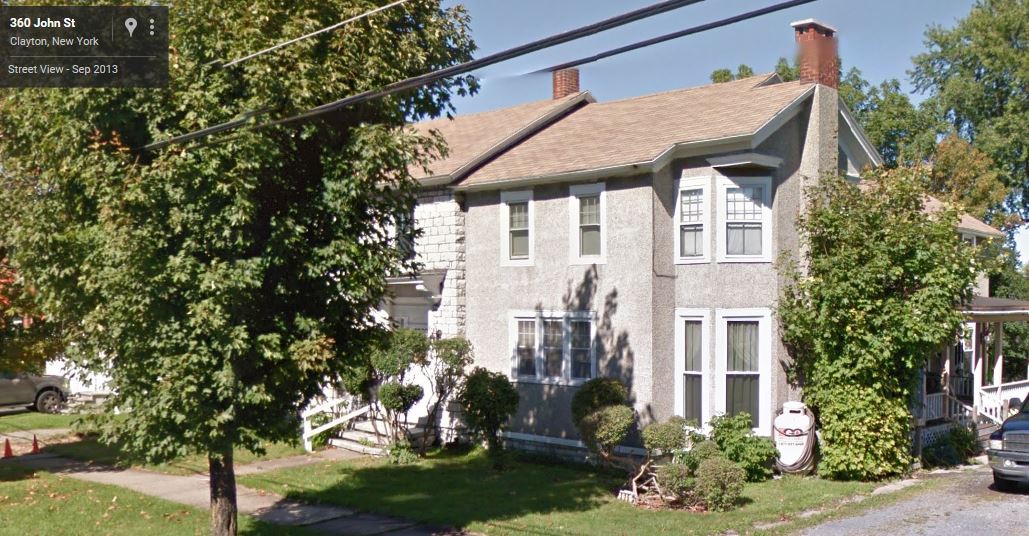
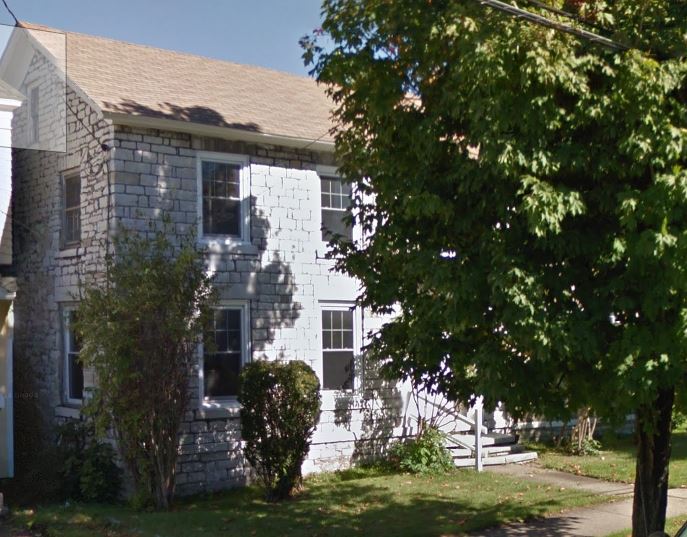
Abiathar Joy Jr, son of Major Abiathar Joy, hero of the Revolutionary
war and the War of 1812 had the main or limestone portion of this house
constructed for him on John Street, village of Cornelia (now Clayton),
almost a century ago. Now owned jointly by Miss Eleanor Peck and her brother,
Brig. General DeWitt C Peck, U S M C, it is known as No. 325 John Street.
Miss Peck has recently written a number of historical feature articles
for The Times. Her brother, Brig. General Peck, who has played an important
role in the American forces during the present war, was colonel in command
of the Shanghai, China area in 1940.
Miss Peck and Brig. General Peck are children of the late Captain Frank H
Peck, city, former district attorney. Their brother is Lott M Peck of
this city and their mother was the former Miss Margaret Hubbard, daughter
of the late James T Hubbard, for many years owner of the historic Hubbard
hotel, Clayton.
Some time after the death of Captain Frank H Peck his widow was married
to Dr William MacCauley Powell, noted physician, author and editor and
former professor of the University of Pennsylvania medical college who
died December 13 1931. Nearly six years prior to that Mrs Powell bought
the mansion on January 29 1926 from A A Barnhart Sr, and wife. She modified
the original house, adding the stucco wing. Before the Powell purchase
owners had included Mary J Barker, Daniel C Porter who had come to Clayton
in 1829, Edward Burchell and Hial Cook.
The mansion was probably built immediately after Abiathar Joy Jr paid
Eldridge G Merick $100 August 5 1844 for the main part of the site. March
9 1850 Joy bought an addition to the lot from Truman S Angel. April 12
1859 Mr Joy sold the property to Hial Cook for $1,225 and moved to Beaver
Dam, Wis. Mr Joy's father, Major Joy, was born at Rehoboth, Massachusetts in 1762
and saw considerable service in the Revolution in 1781. After Rehoboth,
he resided at Brattleboro, Vermont, and then at Russia, Herkimer county before
coming to the town of Clayton early in the 19th century, probably after
his service in the War of 1812. He died July 3 1852 at the age of 90 and
is buried at Clayton Center by the side of his wife, the former Miss Elizabeth
Burt, who died November 3 1848 at the age of 83.
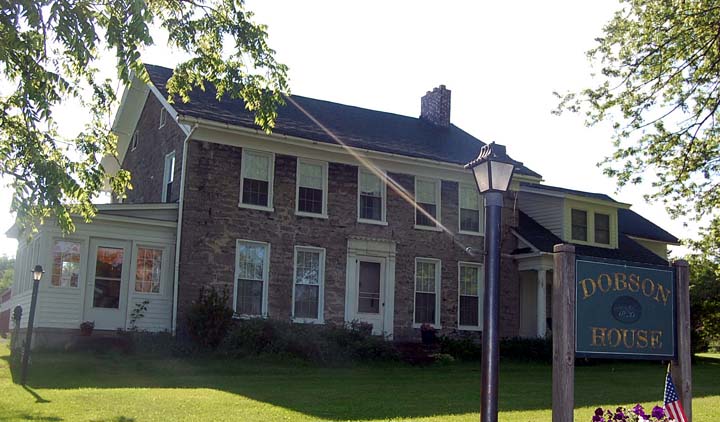
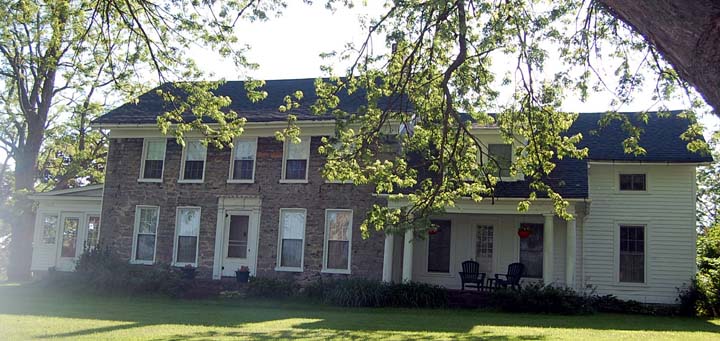
The following pictures come from the Internet in 2023 house listed for sale by Trulia, 6 bedrooms, 4 baths, 23 acre:
Photos that are on the wall:
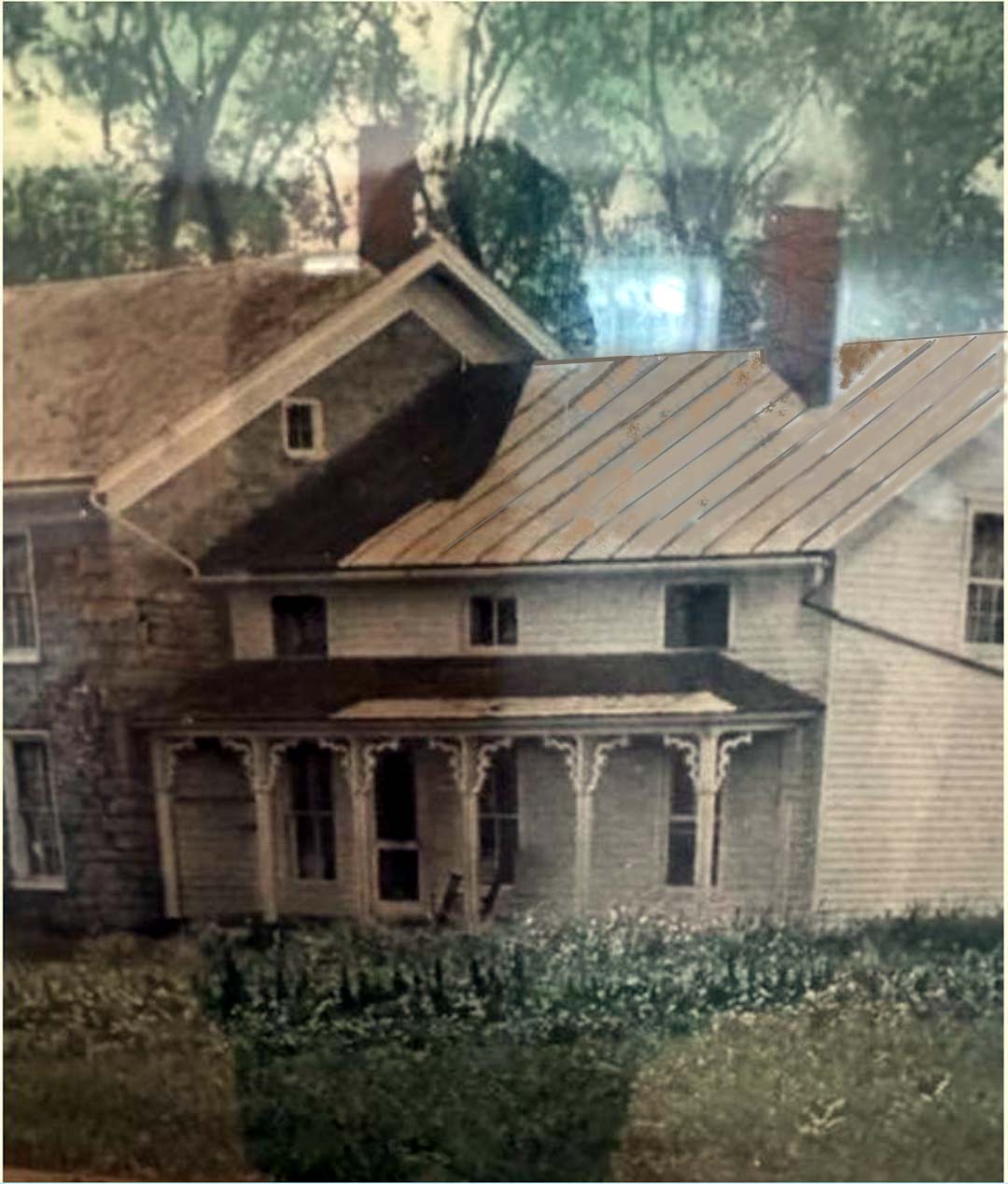
Approximately a century and a quarter ago Thomas Dobson Jr, native of Abergavenny, Monmouthshire, England, built the body of this native limestone house about a mile west of Henderson village on the road to Oswego. Since October 9 1911 it and the 215 acres of land that now goes with it, has been owned and occupied by Fred L Jones. Mr Jones, expert appraiser and architect, who was graduated from Cornell in 1899 was for many years connected with the American Appraisal Company, and for two years from April 1 1924 to April 1 1926 was chief assessor for the city of Watertown.
Thomas Dobson Jr, who first came to Utica from Bridgeport Connecticut,
by ox-team transferred to Redfield, Oswego county about 1811. His wife
was Fanny Whittier, cousin of the famous American poet, John Greenleaf
Whittier. In Redfield their son, John, was born in 1812 and in 1813 they
removed to the town of Henderson, locating on the state road where Mr
Dobson purchased over a hundred acres of land from William Henderson,
proprietor of the town. This purchase was made April 12 1816 and the farm
also bordered on Stony creek.
First Mr Dobson built a log cabin, but after a few years he replaced it
with the main part of the attractive stone house now owned by Mr Jones.
A son, Thomas Dobson, married Julia Ann Alden and they had a daughter,
Mary Elizabeth, who married Melvin G Weaver in 1882.
It was from Mrs Weaver, resident of Sault Ste. Marie, Michigan, sole heir
of the original owner, that the property was bought by Mr Jones in 1911.
Not far from the back of the mansion, near Stony creek bridge, landed
the balloon, "Atlantic" in the evening of July 2 1859 terminating
the record-breaking flight of that historic aircraft in a treetop. The
tree was on the farm owned by T O Whitney and shortly after the landing
of the balloon the countryside turned out to aid the balloonists, who
had set out in the craft the previous evening at St. Louis, Missouri,
with John La Mountain, noted aeronautical expert, Prof. John Wise of Lancaster,
Pennsylvania, William Hyde editor of the St. Louis Republican and O P
Gager, Boston crockery manufacturer, en route to New York City.
Later the torn balloon was reduced about one-third in size and used by
La Mountain and John A Haddock, an editor of The New York Reformer of
Watertown in the flight which started from this city and ended in the
great wilderness fastnesses of Canada's far north.
321 General Smith Drive
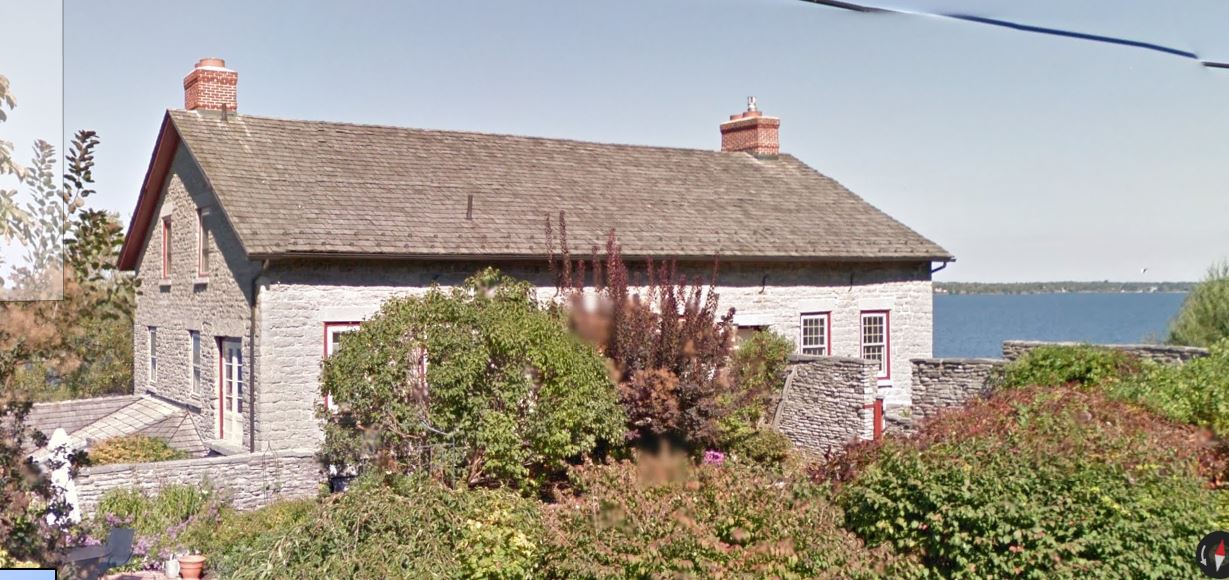
"Mill House," residence of Supreme Court Justice and Mrs Henry
J Kimball at Sackets Harbor, has an unusual and colorful history. Located
not far west of the Madison Barracks military reservation it borders on
both Ogden Street and the waters of Lake Ontario. Built upwards of 100
years ago its construction is of limestone believed to have been hauled
either from Chaumont or Brownville.
Tradition has it that the building, two stories high on the street side
and three stories on the waterfront, was erected for Colonel Edwin Guthrie,
brother of Dr Samuel Guthrie, who resided a short distance away at Jewettsville
and discovered chloroform. According to the tradition the Guthrie distillery
was in the basement and his residence on the two upper floors. Later the
property was owned by Colonel Elisha Camp, one of the heavy landowners and
promoters of Sackets Harbor, the Thousand islands and Jefferson County.
Walter B Camp as executor of Colonel Camp sold it to Sloat & Greenleaf,
of this city, lumber manufacturers, April 21 1882. Although the top was
long ago taken off by ice and water there can still be seen under the
surface the pier extending about 60 feet out into the lake where picturesque
old sailing ships docked with their cargoes of grain for the Guthrie distillery
and later with lumber for Sloat & Greenleaf's mill, steam-operated.
It is said that early in its history large gold letters on the lakeside
of the building announced "E Guthrie & Co. Distillery."
After the Sloat & Greenleaf ownership the old mill was owned by the
late Mr and Mrs David M Anderson of this city and October 3 1916 they
sold it to Charles Frederick Naegele, outstanding American artist, who
was at that time redecorating the interior of the Roswell P Flower Memorial
library in this city. Desiring to use it as a studio Mr Naegele made up
alterations except the installation of new floors.
October 17 1923 he sold it to Chard Powers Smith, poet-novelist, author
of "Artillery of Time," "Ladies' Day," etc., for $2,000.
Mr Smith expended about $30,000 more to make it suitable for his residence,
installing in the huge library, furnished with Medieval furniture, a handsomely
designed 11th century fireplace, which he had purchased in Italy. Above
the library is the main reception hall 42 x 38 feet, which extends two
stories in height and is equipped with another mammoth fireplace, which
Mr Smith acquired in Europe. A formal garden and court were laid out
in front of the building and enclosed by a high stone wall as part of
the Smith design. The interior was fashioned after Lord Byron's castle
of Chillon.
But Mr Smith used the property only a few years and May 11 1938 sold it
to Mrs Elizabeth Anderson Wise, who purchased it to protect her own residence
on the opposite side of Ogden Street. September 4 1941 Justice and Mrs
Kimball bought the house inclusive of all of the expensive installations
made by Mr Smith and found it necessary to make few changes or improvements.
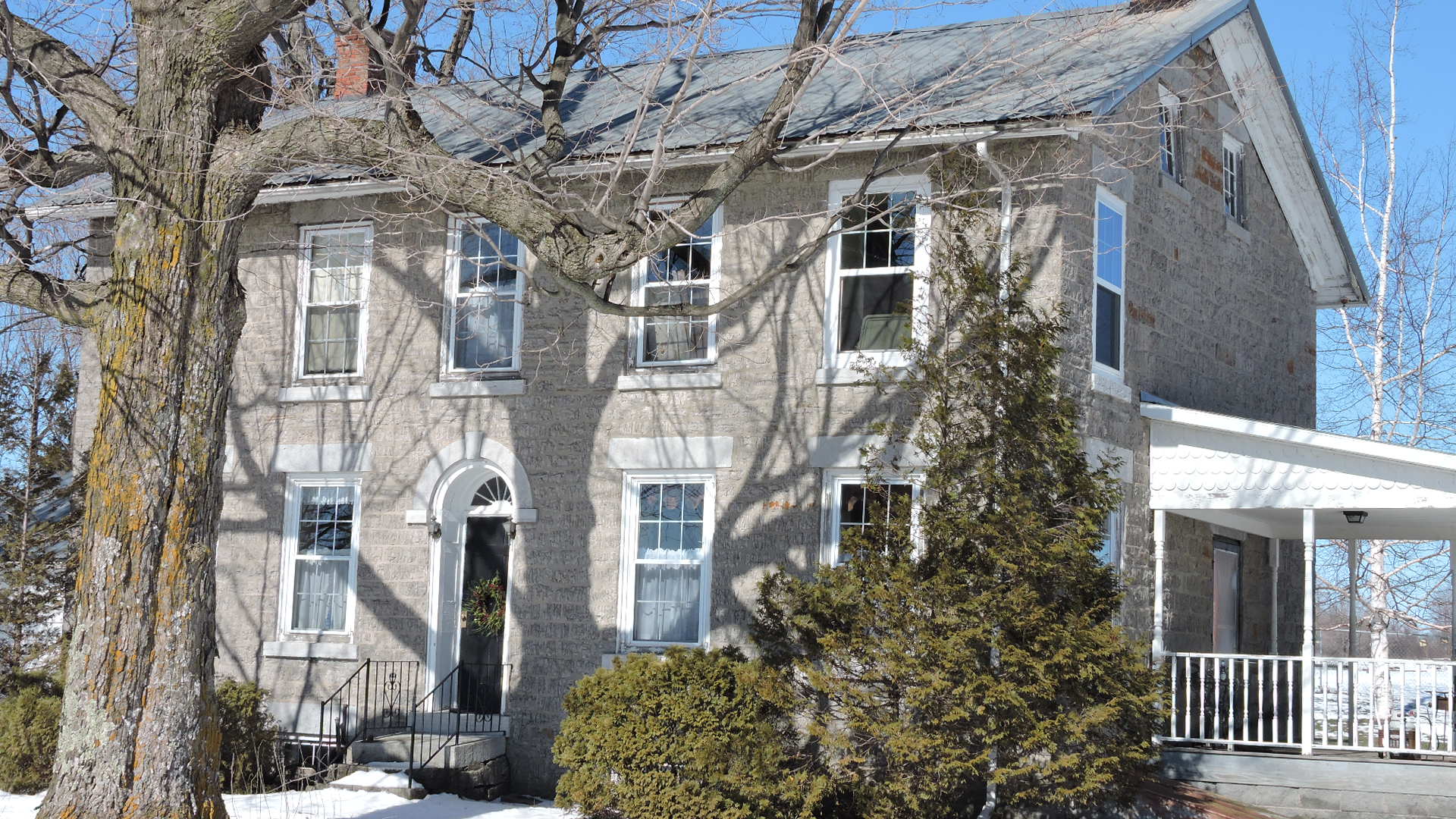
Nestled into the hillside on the left or westerly hand of the Rutland
Hollow road or "Lovers' Lane," as it is frequently termed, is
the old Carpenter homestead, better known, perhaps, as the Fulton place.
It is something over 100 years old, quaint and simple in type with its
narrow, semicircular topped front doorway. There are other native limestone
houses of similar architecture featuring similar doorways in the county,
which leads to the opinion that they had, perhaps, the same designers
or builders.
Since November 30 1940 with its 63.78 acres of land the property has been
owned and occupied by Mr and Mrs Bernard Radigan. They purchased it
from John McKeown, who had owned it from May 6 1903 when he bought it
from Herbert J Howland.
James Ellis Fulton, prominent early Rutland farmer, acquired this Carpenter
homestead early in 1838 but died June 20 of that year. However, it remained
in the Fulton family from that time until 1901. From him it passed to
his son and daughter, Richard and Eleanor.
This James Ellis Fulton was born May 7 1775 in Colerain, Massachusetts, son
of James and Hannah Ellis Fulton. In 1806 he settled upon a 120-acre farm
in the town of Champion, building there a log house. In the War of 1812
both he and a brother, Caleb Fulton fought at the Battle of Sackets Harbor.
James Ellis Fulton married Miss Sarah Choate in 1799 six years before
removing from Colerain to this county. Mrs Fulton died April 11 1851
aged 74. Richard Fulton, son, one of the inheritors of the farm, died
January 17 1871 aged 64.
Jesse Fulton, son of James Ellis and Sarah Choate Fulton, was born March 5 1812 and also became a prominent Rutland farmer, buying and residing on a farm to the southward of that of his father on the Rutland Hollow road. He accumulated some wealth, fought in the Civil War, was one of the founders of the Republican party in this county but supported Grover Cleveland in his first campaign for the presidency. Mr Fulton died March 12 1889 at the home of his daughter, Mrs George B (Ida Eudora) Haddock on upper State Street, city. A sister, Lucretia, of Mr Fulton's father, married Abel Carpenter, who bought a farm from Asaph Carpenter on the Rutland Hollow road February 6 1928.
Main entrance doors and doorways are expressive of the character of houses and houses are often expressive of the character of their occupants. This is particularly true where the occupants are responsible for the type of house in which they live. Windows are little less important house features than doors.
The doorway shown today is that of the old Carpenter homestead, now owned
by Mr and Mrs Bernard Radigan on the Rutland Hollow road and presented
on this page last Saturday. Its simple beauty is in complete harmony with
the rest of this old native limestone house which was constructed over
a century ago and owned by James Ellis Fulton and his descendants from
1838 to 1901.
This doorway is narrow which makes the semicircular arch, set off by
a small keystone, seems high. The character of construction of the doorway
is plain but sufficient as to ornamentation. The single-width door, apparently
the original one, must have been especially attractive before two of the
upper panels were removed to make way for panes of glass installed purely
for utilitarian purposes.
The well weathered door is set to the inside of the thick stone walls both for beauty and as protection against the weather to which it is exposed due to the lack of a protecting portico.
It is unlike the broader doors, which have sidelights and fanlights to
enhance them but notwithstanding that lack of elaboration it seems to
suffer nothing in attractiveness. The doorway of the Carpenter homestead
opens out to a low step. When the original six-paned sash of the windows
existed this house must have been unusually beautiful. Large, single paned
sash of modern make have replaced the ones installed more than a century
ago.
The informal landscaping of shrubbery and flowers in front of the house at the present time is enhancing and the outlook of the old mansion into the "hollow" or valley is pleasing. For long years the Carpenter homestead has attracted the attention of the thousands of pleasure drivers and others who have paused by and doubtless it will continue to do so for many years to come for it is a sturdy structure like all of those old houses, which were built in early years of another century.
One of Watertown's most imposing mansions is that of the late Senator
James F Starbuck at 253 Clinton Street. Since its purchase April 16 1931
from Mrs Mary S Goodale, city, daughter of Senator Starbuck, it has been
the home of Mr and Mrs Robert G Horr, Mr Horr being vice president of
the Brownville Board company.
Of wooden construction, the large house with two-story portico supported by tall, fluted columns, smacks of the Southern Colonial in type and was constructed for Senator Starbuck nearly 75 years ago by Clement Colburn, a local contractor, who took an "extended trip" to Syracuse and Utica to view their mansions and gather ideas. On March 21 1859 Senator Starbuck, prominent Democrat, friend of Silas Wright, Samuel J Tilden, Martin Van Buren, Stephen A Douglass, Franklin Pierce, General George B McClellan and Horatio Seymour, paid Alexander Campbell $4,000 for a lot and small white house and on the south side of Clinton Street. Five days before he bought an adjoining lot from Sawens & Anderson for $1,250. The little house was torn down to make room for the big one with its dozen or more large rooms, its two fireplaces, one with white marble mantle and the other of black marble, its long drawing room and huge attic leading to a broad cupola. Prior to that Mr Starbuck, one of Watertown's leading lawyers, member of the firm of Starbuck & Sawyer, had resided in a house on a high embankment on low State Street, where Mrs Goodale was born.
James F Starbuck was descended from an old Nantucket Quaker family. He studied law with Lansing & Sherman, was admitted to practice in 1843 was prominent in North Country Democratic politics, was secretary of the state constitutional convention of 1846 during the governorship of Silas Wright, at which Samuel J Tilden was also a delegate, supported Martin Van Buren for president in 1848 Franklin Pierce in 1852 James Buchanan in 1856 Stephen A Douglass in 1860 George B McClellan in 1864 and Horatio Seymour 1872. In 1861 he aided in recruiting troops for the Union army, he had been master in chancery in 1845-6 and district attorney of Jefferson County for three years from January 1 1851 and defeated Anson Harder, Redwood, Republican, by 308 votes in 1875 for state senator of the 18th district. There he served one term of two years. His Democratic friend Samuel J Tilden was governor at the time and one of Senator Starbuck's great speeches in the senate was made January 24-5 1877 on "The Great Conspiracy!" charging military interference in elections.
Senator Starbuck was twice married. His first wife, Sarah Burchard, mother of Mrs Goodale, died in 1857. In 1861 he married Roxania, widow of Judge Joseph Boyer and they entertained many prominent personages in the big house. Senator Starbuck died December 11 1880. His widow continued to reside in the mansion and after her Henry W Boyer, her son, for several years manager of the New York Air Brake Company, inherited the property. He died January 9 1931 willing it to his stepsister, Mrs Goodale, who resides next door.
Two miles from LaFargeville and towards Stone Mills is the limestone mansion of John N Rottiers, an historic figure in the early development of Jefferson County, who died from a mowing machine accident July 24 1873. For more than a century the property has been held by the same family. Dr Eugene Paul Harman, prominent Brooklyn physician and grandson of John N Rottiers, is the present owner of the 260-acre farm. Until his death November 6 1939 a brother, John N Harman, former Brooklyn Times editor-publisher, founder of the daily On-the-St. Lawrence, Clayton, and former Kings county sheriff, owned part of this farm.
John N Rottiers, scholar, linguist, engineer, was born of French parentage in Brussels, Belgium about 1798. His male ancestors were mainly military men and he was a staunch admirer of Napoleon, of whom he had a small painting, for which he had been offered a considerable sum, but which he steadfastly refused to sell.
In October 1825 Mr Rottiers was appointed agent of the Antwerp Company, owner of vast North Country lands, and was instructed to prosecute certain claims against James De LeRay. The Erie canal then blasted the prospects of both company and LeRay. Rottiers sold a large tract of land to John LaFarge, but the transaction was upset by chancery court. However, LaFarge has acquired extensive holdings in this county and when he abandoned residence in his fine mansion near LaFargeville to establish in New York City, he chose Rottiers, who had done much surveying for him, as agent.
About 1841 John N Rottiers married petite, dark-eyed, Ruth A Cotter, daughter of John and Lucy Wilson Cotter, Watertown. To her large, plump, good-humored sister, Betsy, John and Louisa LaFarge had sold 128.95 acres of Orleans land for $1 on May 14 1833. On May 1 1841 Betsey conveyed this property to Ruth A Cotter "for and in consideration of the natural love and affection which she, the said Betsey hath and beareth unto the said Ruth A, her sister, and also for divers others good causes and considerations." January 15 1842 John N Rottiers bought an adjoining tract of 25 acres for $1,200.
Tall, fine looking, frank, positive, he became an important figure in the county, playing a part in Union army recruiting and in the litigation over the bounding of Orleans for the railroad extension to Clayton. He was an expert chess player, apiarist and dairyman, his farm being a model and his front lawn filled with bee hives. In 1842-3 he was Orleans assessor, and supervisor in 1848-9. In 1850 he took census and gave much aid to Historian Franklin H Hough. His son, Victor B was second lieutenant in the 10th NY Heavy Artillery. His daughter Wilhelmina Elizabeth Francesca married Civil War Veteran Henry A Harman of Oswego in 1867. After Mr Harman's death Mrs Harman and her two sons resided in Watertown. She died June 27 1930 and 130.66 acres of the farm went from her to her son John N Harman. The other 128.95 acres with house, of which she had a life use, went to her other son, Dr E Paul Harman, to whom it was willed by his grandmother Rottiers in 1908. December 18 1940 he acquired his deceased brother's portion.
343158 County Rte 126 Carthage NY
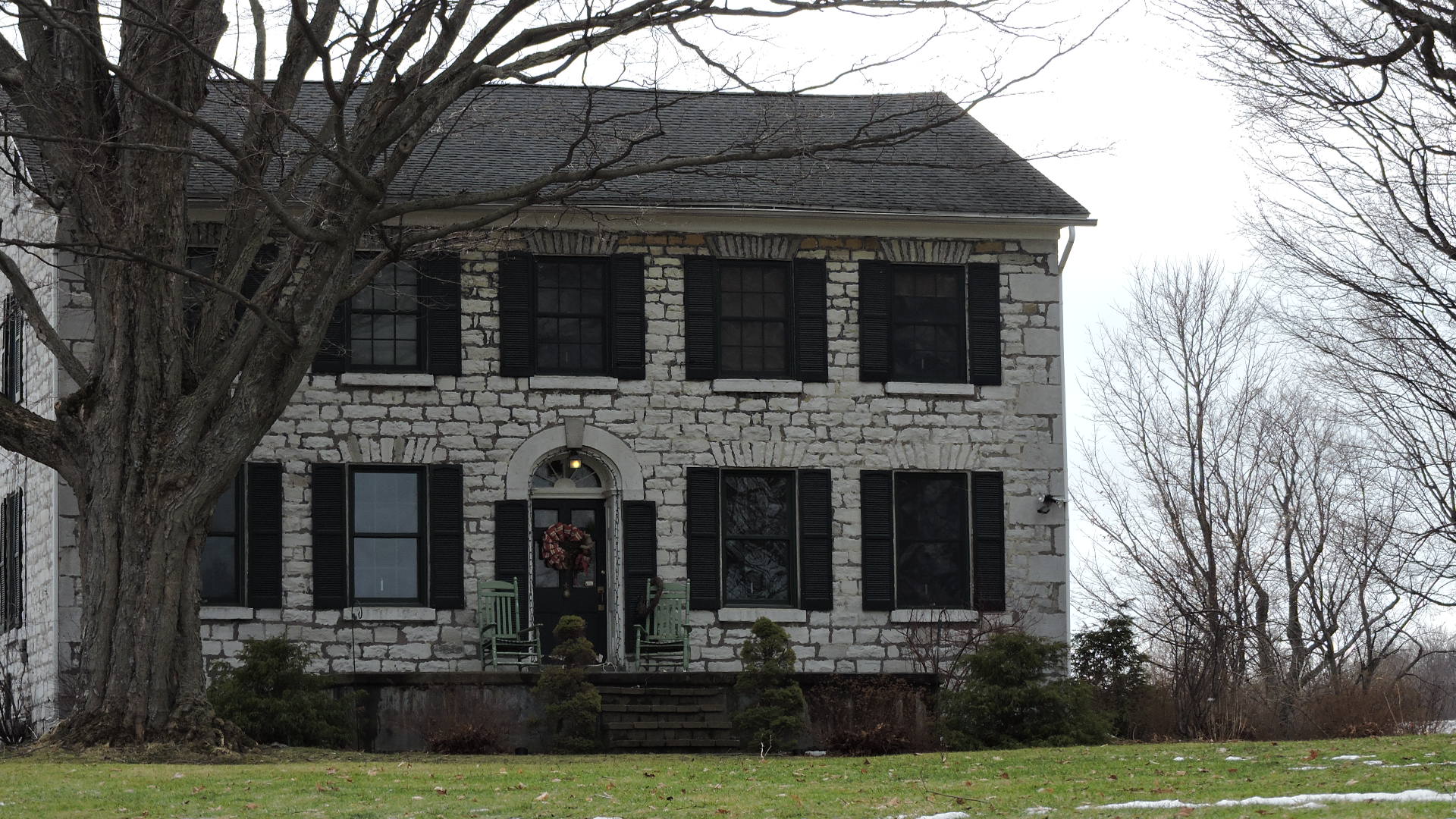
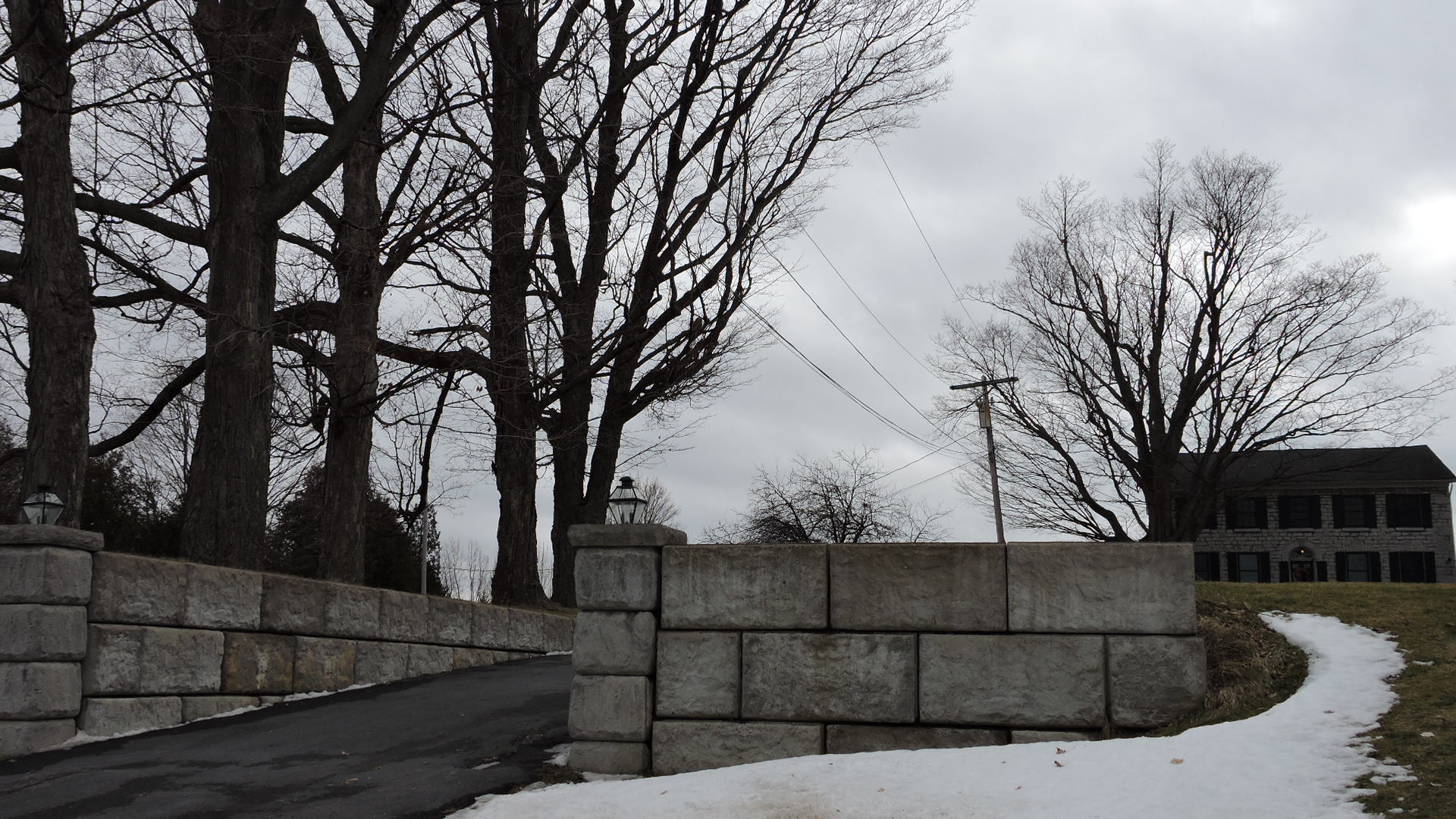
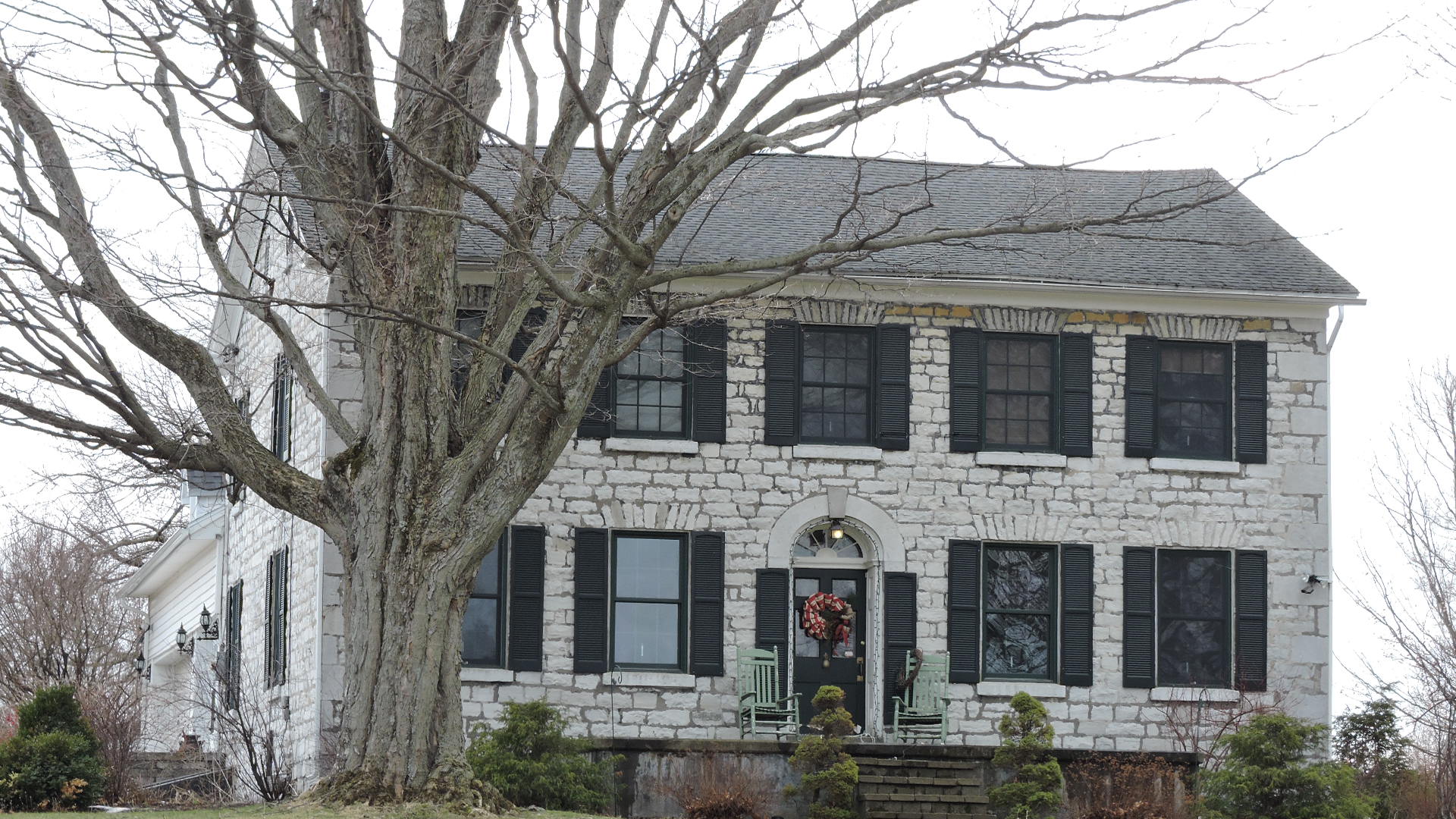
A beautiful old native limestone house of Georgian architecture at the rear of a fine grove of large maple stands well back from the south side of the Watertown-West Carthage road a short distance towards the latter place from Champion village. A magnificent vista across the Black River valley to Carthage is open to the occupants of this mansion, said to have been built for William Dorwin of 1823.
Dorwin, descended from New England stock, was the uncle of Luther J Dorwin, noted Watertown lawyer and authority on water rights law. Eventually the house and farm came into the possession of William Pierce Freeman, a grandnephew of William Dorwin, and in consequence it became more commonly known as the Freeman place. For the past dozen years or more it has been owned and operated by Pickert Brothers, Edwin and Paul, extensive dairymen and milk dealers.
There is the tradition that the mansion excited the envy of Noadiah Hubbard, Jefferson County's earliest settler, resulting in Hubbard building his mansion at Champion village in 1831 two feet wider. William Pierce Freeman, born December 30 1833 died December 16 1908 in Champion township, was one of Jefferson County's most interesting figures. His father was Silas Freeman of Champion and his mother, Nancy Colton of Gouverneur.
In 1856 William Pierce Freeman entered Yale as a sophomore and was graduated in 1859 with Burton N Harrison, private secretary to Jefferson Davis. Freeman majored in mathematics and political economy, studied law in the office of John Clark of this city, but enlisted in the 10th NY Heavy Artillery at the outbreak of the Civil War, rising to a first lieutenancy. He is reputed to have acquired the Dorwin farm in 1878 operating 336 acres, there establishing numerous labor-saving devices including several windmills for grinding feed and various other purposes. William P Freeman, devout Congregationalist, purported to be a Republican politically. He possessed unusual literary ability, which he employed in writing newspaper communications and long speeches advocating Prohibition and the establishment of free textbooks. Recently there was found in the attic of the old mansion large sheafs of proof-sheets of his Prohibition speeches and numerous newspaper clippings of his communications on the same subject. He was a vigorous opponent of the "textbook trust." Also in the attic were several books on ordnance and military tactics, for during his Civil war service he was on detached duty a part of the time as artillery instructor in three of the forts about Washington, DC He married Miss Leila M Miller in Albany June 28 1893 and had one son, William Roland Freeman.
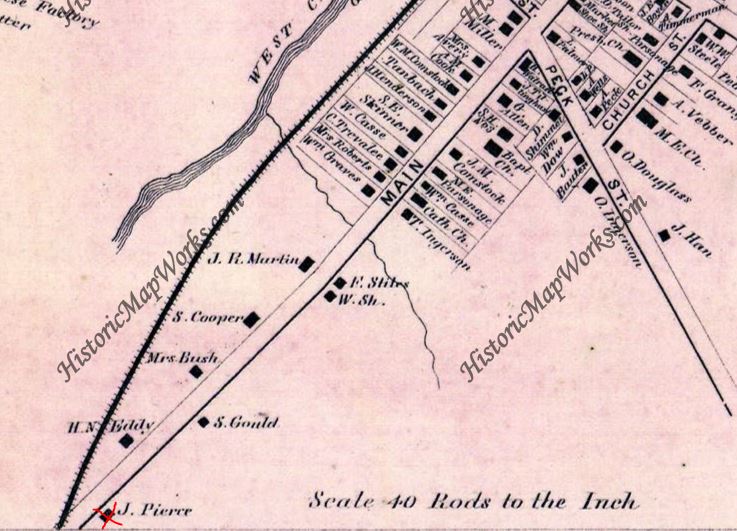
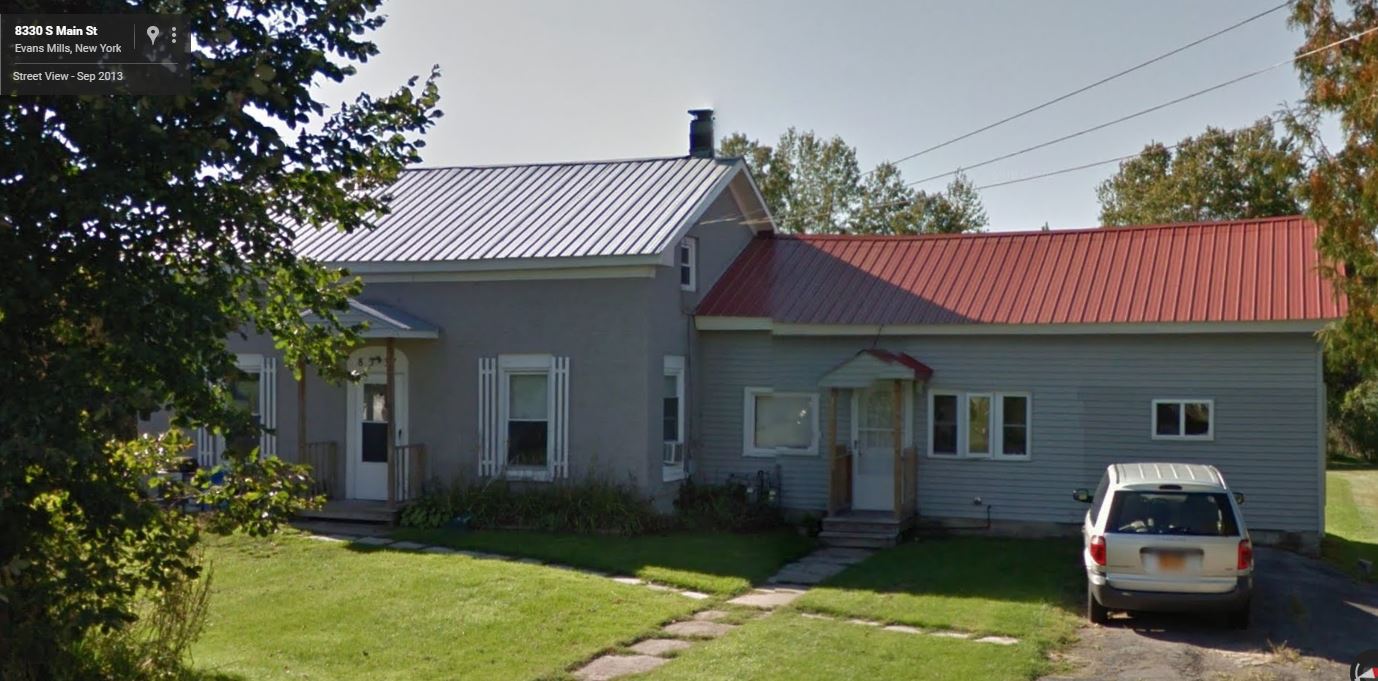
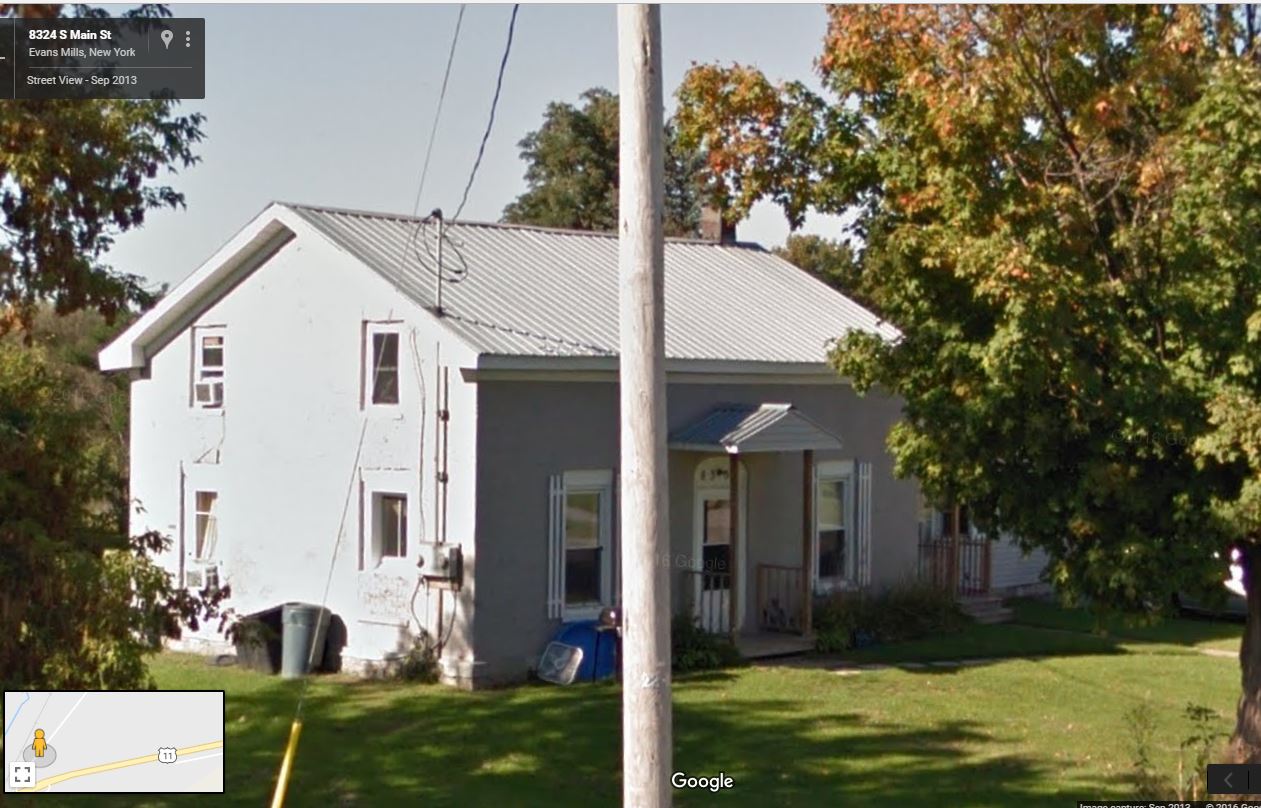
To the right of the railroad tracks on the western out skirts of Evans
Mills as one rides into that village on the train may be seen the old
Joseph Pierce mansion. It stands by itself on high ground in a most attractive
setting and the house itself has been carefully preserved in most of its
original beauty. It is excellently constructed of the best of native limestone,
so abundant in the town of LeRay, and for a long period of years was owned
in the Pierce family, Joseph Pierce having been one of the settlers of
LeRay township about 1807. Mrs Bessie Sheley Simonet, widow of Charles
E Simonet, has possessed and occupied the property with its upwards of
50 acres of land, approximately 25 years. To her it came from her mother,
Mrs Carrie Lawton Sheley, to whom it was sold May 17 1919 by Mrs Betsey
S Kinney.
Mrs Kinney has been twice married, her first husband having been Colonel
Chauncey Wilkie, a Union veteran, for whom the GAR post at Evans Mills
is named, and who died in Washington, DC, of yellow fever after the Civil
war. He is buried in the national cemetery at Arlington. The property
is said to have come to the Wilkie family from the Pierces and on September
6 1897 it was deeded by Marion W Pierce and Betsey S Kinney to Howard
C Wilkie, but apparently reverted from him back to Mrs Kinney some time
before its transfer to Mrs Simonet.
The records show that Joseph Pierce purchased the farm from Jacob and
Clarissa McNeil June 9 1834 and that McNeil bought it from James D LeRay
de Chaumont November 1, 1815 for $361.87. That transfer covered 56.37
acres and the price would indicate there was no house on it at that time.
Mrs Simonet understands that the house was erected in 1826 about two years after prosperity had returned following the depression of 1819. If her information is correct the mansion was probably constructed for McNeil and was on the site when Pierce acquired it. The record of transfer from McNeil to Pierce gives the consideration as the nominal $1 and therefore carries no hint whether or not there were buildings on the land.
In any event the mansion, though low in height, is one of the most attractive in the county. It contains approximately ten rooms, finished off artistically in the manner of lasting simplicity. There are two original fireplaces in it.
Next easterly towards Madison Barracks from the historic Colonel Elisha Camp mansion on the south side of Ogden Street Sackets Harbor is the elaborate brick residence of Mrs Elizabeth Anderson Wise. Mrs Wise acquired the property November 10 1930 from her mother, the late Mrs David M (Ida L) Anderson of this city. Mrs Wise caused the old mansion to be extensively rebuilt and added to with the result that the present appearance is much altered from the original.
The lot, which has 150 feet frontage on Ogden Street and 250 feet on William Street was part of the holdings of Colonel Elisha Camp, brother-in-law of Judge Augustus Sacket founder of Sackets Harbor. Colonel Camp, artillery officer in the War of 1812 industrialist, owner of extensive Jefferson County lands including many of the Thousand Islands, was one of this county's most outstanding early figures and promoters.
August 30 1866 Colonel Camp conveyed this site at the corner of Ogden and William Streets to Mrs Phebe Augusta Denison for the nominal consideration of $1. It is village tradition that Leonard Denison, husband of' Phebe built thereon the brick house, which now forms the bulk of the main portion of Mrs Wise's mansion. On June 10 of the next summer Mr and Mrs Denison deeded the property to their son and daughter, George W and Olivia C Dension. Later ownership included that in 1891 of Edwin C Knowlton, an engineer at Madison Barracks, who sold it in 1900 to Mrs Nellie Powell Koehler and after possessing it 15 years Mrs Koehler sold it September 20 1915 to Mrs Anderson. After that for upwards of a year it was the residence of the late John F Moffett
Leonard Denison, builder of the house, was a prominent Sackets Harbor resident for many years, much of which time he was in business there. He came to Sackets from Stonington, Connecticut, in 1812. Some time after the village was incorporated August 15 1814 Mr Denison became one of the customs collectors of the port. When Athol Lodge, No. 308 F & AM, was instituted in 1818 Leonard Denison became one of its notable members and on February 6 1820 when Sackets Harbor Chapter No 68 RAM started with Commodore Melanethon T Woolsey as high priest, Mr Denison was chosen the first treasurer.
Mr Denison was born in 1791 and lived to an advanced age.
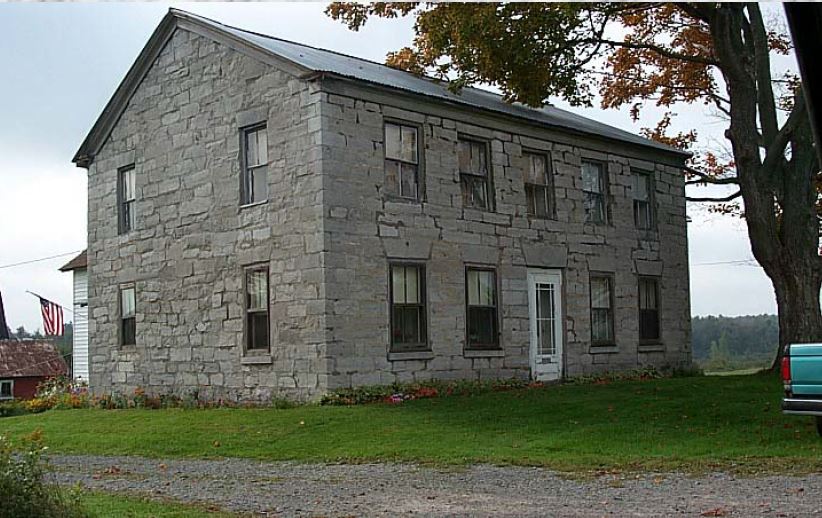
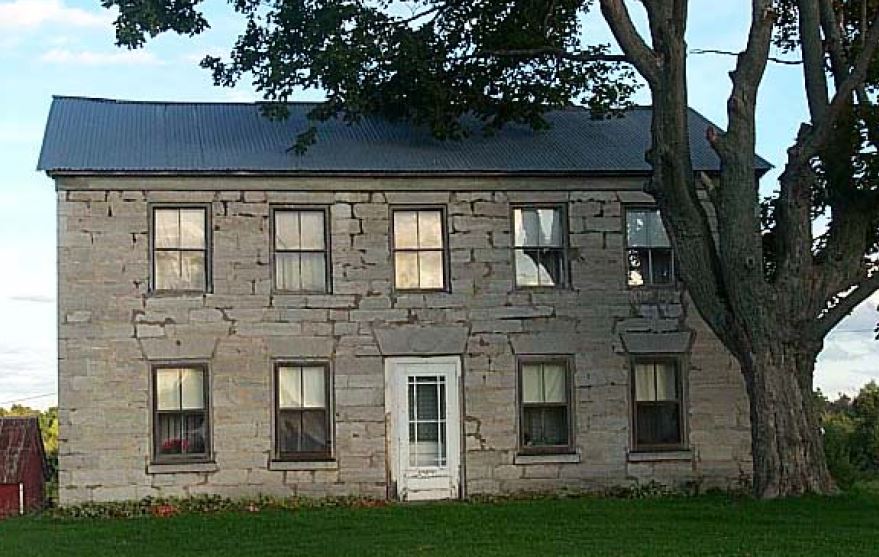
Possibly the oldest stone house in the town of Pamelia is that built
by Simeon Woodruff in 1821 of the fine native limestone in which the township
abounds. Father of the inventor of the sleeping car and of the artist,
who painted the portraits of many of the county's earliest notable residents,
which collection now hangs in the gallery of the Jefferson County Historical
society, Simeon Woodruff was one of Jefferson County's most historic figures.
The initials "S W" and the dale "1812" may still be
seen in the lintel of the front entrance.
The house is located on the south side of the old military highway between Scovil's and Pamelia Four Corners and at the junction of the Perch Lake road. Since October 1 1930 this house with 203 acres of land has been owned by Henry H Ganter, city. Prior to that back to March 1 1899 it was the property of his father, Anthony Ganter. Simeon Woodruff left the place and came to this city to reside in 1843.
Later the property was owned by Henry Brown of Brownville and still later
by Alexander Brown. In 1797 Simeon Woodruff married Rosanna Adams of Simsbury,
CT, and in October , 1799 with his brother Benjamin came up to explore
the Black River country. Again on March 5 1800 he arrived in Watertown
by oxteam with his family from Litchfield, CT, starting "Woodruff
Settlement" on the eastern outskirts of this community.
There his son Felix was the first male child born in the county. And there in the Woodruff home in 1804 was formed the first Methodist class.
In 1817 Simeon and his family removed to that part of Brownville, which
became the township of Pamelia April 12 1819 and at the first town meeting,
March 7 1820 he was given three town offices, assessor, highway commissioner
and overseer of the poor. When The Pamelia Farmers' Scientific Library
was organized April 1 1822 he was chosen one of its first trustees.
His first Pamelia home was of logs, which he replaced in 1821 with the more pretentious stone mansion now owned by Mr Ganter, and among his family of twelve children to live in this house were Theodore Tuttle Woodruff and Jonah Woodruff, both inventors of sleeping cars, and Charles P Woodruff, for many years owner and operator of a brick yard near Huntingtonville.
Theodore Tuttle Woodruff invented the sleeping car made by the Central Transportation company, which later sold out to the Pullman company after a million dollar litigation against the latter. Jonah, the portrait painter, also invented a sleeping car and became president of the Palace Car Company of Philadelphia, Pennsylvania
Simeon Woodruff died in Watertown September 5 1853 aged 80 and is buried in Brookside cemetery. His widow died June 15 1876 at the home of her daughter, Mrs John (Mary) Clark, Vineland, NJ, aged 99 years, one month, six days, and is also buried in Brookside.
Hart Massey Jr, son of Hart Massey, one of the three original pioneers of Watertown, established his farm home on the south side of Coffeen Street just west of the outskirts of this community about a 115 years ago. Since then hundreds of thousands of people traveling over the old military road from the city through Brownville to Sackets Harbor have admired the stone house that once belonged to young Massey.
Today the property and its 114.6 acres of land is owned by Elmer D and Pauline C Houghton, who purchased it from Harold F and Mina S Galloway February 19 1942 and is known as 1275 Coffeen Street. Its connection with one of Watertown's-first families makes it of especial historic interest. Hart Massey Jr, purchased his first parcel of 36 acres in the farm June 7 1826 from James Parker of the town of Watertown for $650. On January 24 1828 young Massey paid his father $400 for an adjoining parcel of 18 acres, upon which stood his house and barn. After that he bought other parcels and on October 27 1856 sold the farm consisting of the present content of 114.6 acres to Ira T Curtis for $5,370. Curtis retained it only a short time and disposed of it to Alanson Skinner, prominent Brownville iron founder for $7,000 and eleven days later Skinner disposed of the property to his daughter, Mrs Mary Skinner Rice, September 17 1859 for the same price he had paid for it.
Mary Skinner Rice was the wife of Reverend Luther Rice, prominent Universalist
divine, who was born at Wethersfield, Vt, November 2 1820 graduated from
Lebanon academy at Lebanon, New Hampshire, and married her at Brownville in 1845.
During about 45 years of ministry he preached at Springfield, Vt, Quincy,
Massachusetts, Ellisburg, Henderson and several other places.
For 60 years the farm remained in the Rice family and was operated as
a farm. Reverend Mr and Mrs Rice had six sons and one daughter.
One of the grandsons, Luther Rice, Brownville, is a well known nurse. Mrs Rice's father served eight terms as a trustee of Brownville village and was supervisor from Brownville in 1839, 1840, 1843 and 1846. The Rice estate sold the farm to Mr and Mrs Harold F Galloway April 9 1919 and for 23 years they resided there and operated the farm, across the road from which is located the Jefferson County sanitarium. Mr Galloway, prominent Jefferson County farmer, was for several years president of The North Country Farm Loan Association, a unit of the Federal Land Bank of Springfield, Massachusetts.
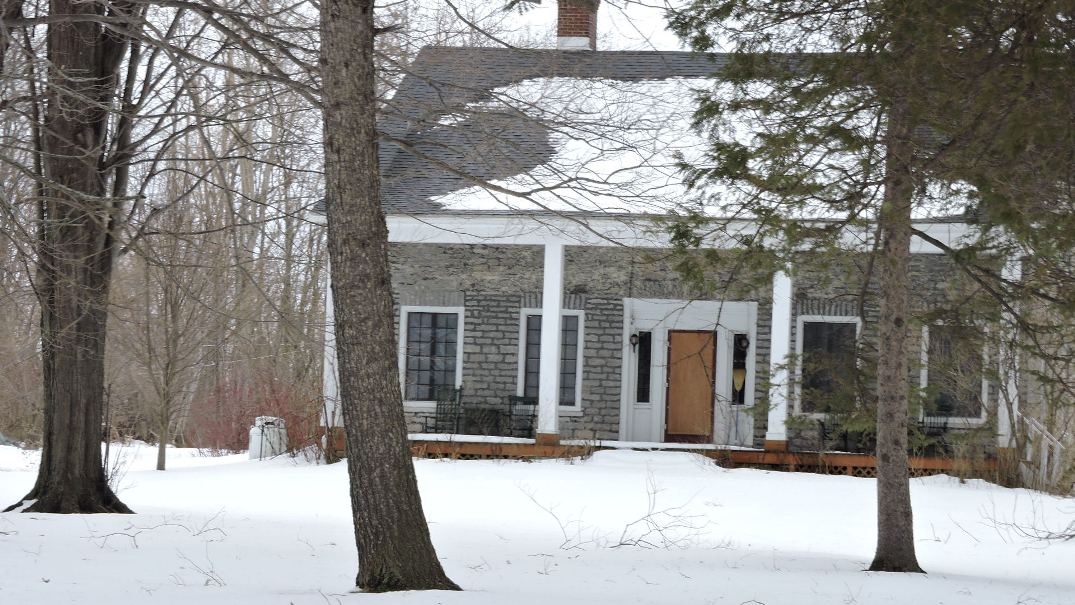
Because the site was once part of the 1,000-acre farm of Count Pierre Francois Real, builder of the romantic Cup-and-Saucer house and Cape Vincent Napoleonic refugee who served as Napoleon's prefect of police during the 100 days, the summer home of Attorney and Mrs Byrd Douglas Wise below the village of Cape Vincent on the Tibbett's Point road is one of the most historic in the county.
Just when his beautiful old limestone house with its low, broad roof, was built there is no record, but it is believed to have been well over 100 years. Since January 1 1926 when it was purchased from former board of supervisors' chairman and Mrs John R Kilborn, the title has been held by Mrs Edith Grandin Wise, wife of Byrd D Wise, prominent New York attorney and grandson of former Virginia Governor Henry A Wise. Count Real, native of Chaton near Paris, historiographer under the Directory, later of the Council of State came to Cape Vincent in 1816 at the age of 59. Before 1818 he had built the Cup-and-Saucer house as a rendezvous for Napoleon. Along the Tibbett's Point road between the Pleasant Valley road and Wilson's Bay and back to Kent's creek be had the bulk of his 1,000-acre farm.
In Paris in 1831 Count Real died and in 1833 his daughter, Mme. Eulalie Francoise, widow of Jean Chrysostome Douzon de Lacuee, later wife of Leonor Francois Fresnel of Paris, obtained United States permission to sell Real's 610 remaining acres in Cape Vincent township. April 10 1837 she disposed of this property to Hyacinthe, Theophile Aime Adolphe and Louis Desire Peugnet brothers and distinguished officers of Napoleon's army, who came to this country after the Emperor's downfall and set up a school in New York, where the later Confederate General Beauregard received from Louis his first instruction in military tactics.
On March 15 1851 Hyacinthe and his wife, Evaline of New York and Theophile of Cape Vincent, sold their two thirds interest to their brother Louis, who, with his wife, Theresa, disposed of a farm out of the former Real holdings to Bernard McKinley March 31 1875. This became known as the McKinley farm and on March 7 1913 was bought by John R Kilborn from Frederick M Boyer as referee. Mr Kilborn sold off the stone house and capacious grounds, now used by Mr and Mrs Wise as a summer home, in 1926 and the rest he operates under the name, Riverside Farm Dairy. The Peugnets were picturesque figures at Cape Vincent and Hyacinthe once owned the "Stone House," now the beautiful summer home of Mr and Mrs John L Johnston of New York City.
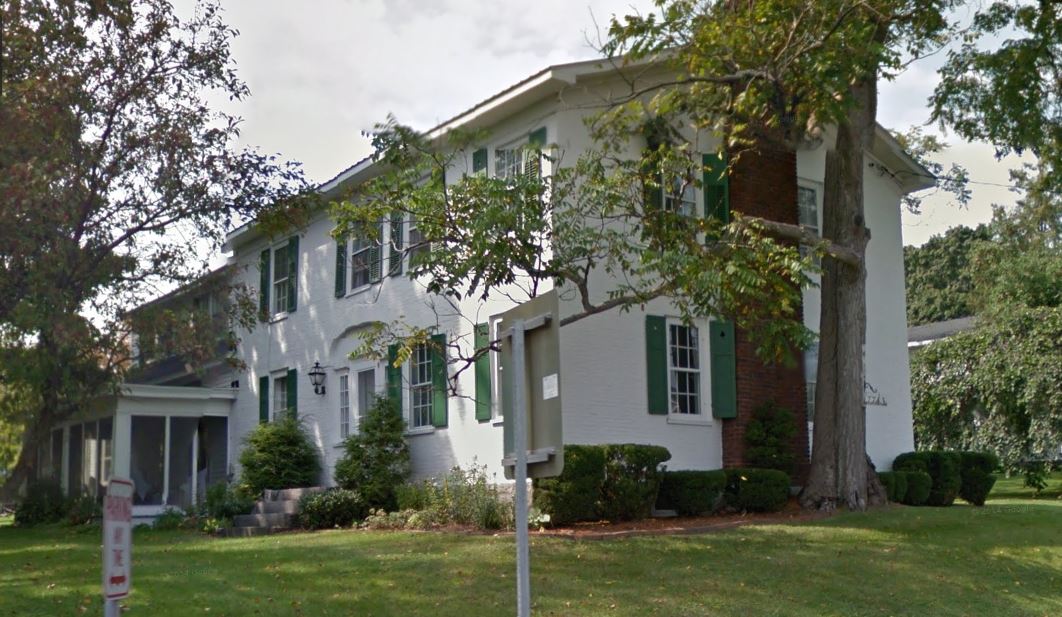
Ira Stephens, born at Westfield, Massachusetts, November 29 1777 son of Rufus Stephens, settled at Lowville in 1801. In 1807 he built a beautiful brick tavern of Georgian type on the south side of North State Street just beyond where Lowville's State Street divides into two branches at the Presbyterian church. This tavern, now the residence of his granddaughter, Mrs Harvey F (Anna Reed) Farrington and her husband, Harvey F Farrington, is embellished with historic richness.
From a century and a quarter ago it was a favorite stop of stagecoaches
over the muddy road between Utica, Watertown and Sackets Harbor. There
is a tradition in the Stephens-Reed family that Joseph Bonaparte, brother
of Napoleon, also had stopped there with his party en route from Bordentown,
N J, to his upstate home at Natural Bridge and hunting lodge at Lake Bonaparte.
For a time the first Masonic lodge in Lowville held its meetings in the
upstairs room that Mrs Farrington now uses as her bedroom. This was Jefferson
Lodge, No. 64 organized at Martinsburg in the winter of 1806-7 with Chillus
Doty as master, and shortly after removed to Lowville, later to return
to Martinsburg for its meetings.
Ira Stephens was a brother of Ehud Stephens, first to take a contract from Silas Stow for land in Lowville June 2 1797 and father of Harriet, first white child to be born in Lowville. Ira Stephens, farmer and tavern-keeper died June 21 1852 and his son, George Washington Stephens succeeded to the ownership of the property. Ira Stephens served in the War of 1812.
George Washington Stephens, instrumental in establishing the fair grounds at Lowville, member of the Lowville board of trustees in 1860 married Cynthia Brown, whose parents came early by ox-team from Cheshire, Massachusetts. Amy, daughter of George Washington and Cynthia Brown Stephens, married Timothy Miller Reed, prominent Lowville lawyer, and became the mother of Mrs Farrington and Attorney George Stephens Reed, member of the New York state power authority.
Possessions of the house passed from George Washington Stephens to his daughter and both Mrs Farrington and her brother were born in it. Eventually ownership of the place moved from Mrs Reed to her daughter, Mrs Farrington, with whom it now rests, and about 20 years ago the house was remodeled by Mr Farrington, who added a screen-porch at the rear, a beautiful brass eagleknocker to the main door and numerous conveniences and improvements. A few years ago the Daughters of New England Women selected this house as the outstanding colonial in northern New York.
Mrs Farrington is a past matron of the grand chapter, Order of the Eastern Star of New York State; past president of the Northern Federation of Women's Clubs; past regent of the Lowville chapter of the DAR; past president of General Walter Martin chapter, Daughters of 1812; past president of the Isaac Clinton Society and of the Children of the American Revolution. Mr Farrington, long prominent in the cheese industry, has for some time had charge of the bulk cheese sales for Kraft-Phenix, has been vice president of the Miller-Richardson company, and operates a large farm at Lowville with a herd of 40 pure-bred Holsteins.
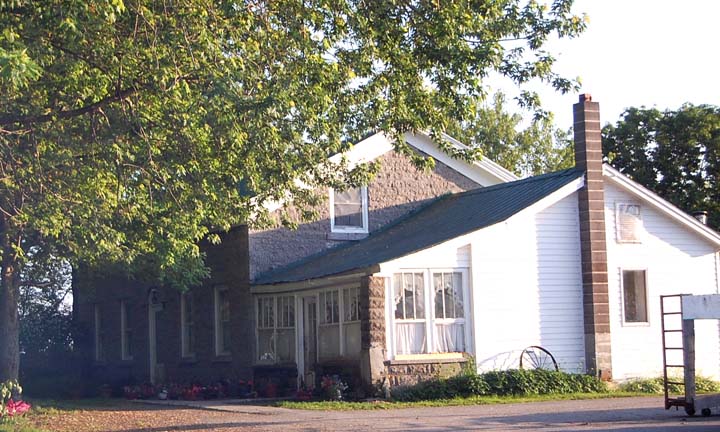
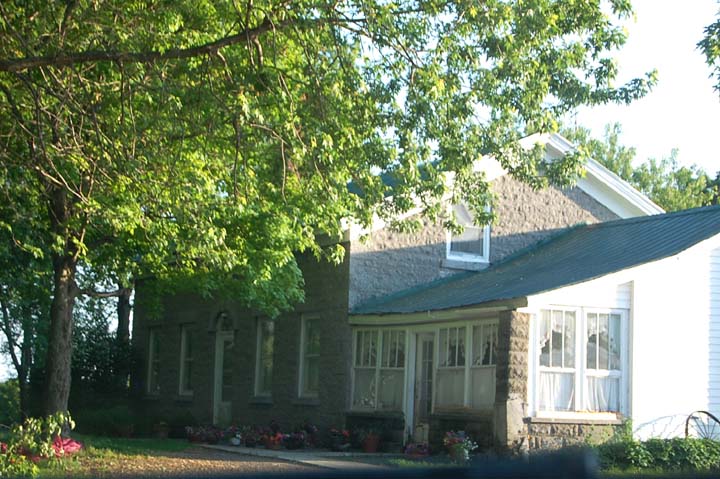
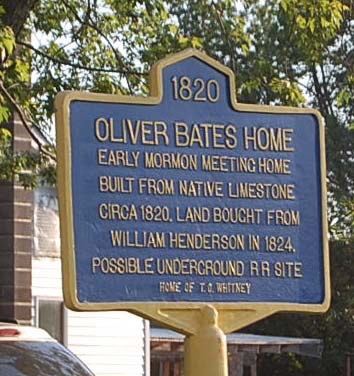
(This is at Rhode's Greenhouse location now - 2015 )
At Alexander's Corners a few miles out the old state road westerly from Henderson Harbor is the farm home of Dr and Mrs Hugh D Laird. The low limestone house of colonial cottage type, attractive in its simplicity, is well over a century old, but the date of its construction is indefinite, although it is believed to have been built about the time of the Thomas Dobson house now owned by Mr and Mrs Fred L Jones a short distance nearer Henderson Harbor on the same road.
It is said to have been erected by a Bates, probably Cyrus Bates, who bought 66.33 acres of land there from William and Sarah Henderson of Hyde Park December 29,1824 for $27.
May 1 1845 Truman O Whitney and Eaton Alexander, great-great grandfather of Mrs Laird purchased 140 acres in the same locality from the heirs of Cyrus Bates and this adjoined the 44.41 acres bought by Eaton Alexander October 13 1838 from Elle H and Mahalia Joiner. This latter piece was at the intersection of roads near the Cyrus Bates and the Amasa Whitney dwellings, September 5 1846 Eaton Alexander sold 141 acres in that locality to Truman O Whitney for $1,125. Mrs Laird declares that the Bates family joined the Mormons and went to Utah. Truman Whitney and his wife, who was a sister of Mrs Laird's great grandmother, occupied her present home after Bates.
Following the Whitney occupancy of the house came that of Eaton Alexander. Then it was owned by Mrs Mattie Greene, Belleville, and then ownership passed to the Lairds. As a boy, Eaton Alexander is reputed to have helped cut the stone and draw it by ox-teams for the house. He was born in 1808 son of Robert Alexander, who was born at Hinsdale, New Hampshire, in 1778 and came to Henderson in 1802.
Robert Alexander was a son of Jonathan Alexander. Eaton Alexander died in 1896 and is buried in Evergreen cemetery, Henderson, as is his wife, Dolly, who died in 1900 and their son Epenetus, who died in 1908 leaving as one of his sons, Eaton T Alexander, who died in 1919 grandfather of Mrs Laird.
The stone walls of the house are two feet thick and extend ten feet below the ground making the house as solid as a rock today. The interior woodwork is of native woods, sturdily fashioned, and while the original style has been retained, modern conveniences have been installed. County records-show that Eaton and Dorothy Alexander on January 20 1876 sold 390 acres of land on the old state road to their daughter-in-law, Mrs Epenetus (Helen S Barrett) Alexander for $23,000.
For upwards of half a century Robert H Latham has owned this sturdy limestone house and 265 acres of farm land in the heart of Deer River's business section. It is on the road from Carthage to Denmark and faces the old Cataract road from Copenhagen. Tradition has it that the house was built about 1825. At that time the property was owned by Richard Myers, one of the founders and first industrialists of this settlement, which was known as Myers Mills and French's Mills before it became Deer River.
Deer River was one of the first settlements in the town of Denmark, owned by Harrison, Hoffman, Henderson and Low and was subdivided in 1798-9 under the direction of Abel French, first land agent for the owners. French became an Oneida county assemblyman in 1799 and in 1810 was an assemblyman from Albany county.
French appropriated for himself some of the choicest land at Deer River and the present Latham farm was part of his holdings. On February 5 1825 he sold this property to Richard Myers who with Amon Wilson built a large stone grist mill the following year. Later that mill was owned by Johnson & Rogers, Leonard S Standring, Munger & Woolworth, Wood, Rogers & Co., and by J T Standring and H S Hendee.
After an ownership of ten years, Myers sold the present Latham property to his partner Ammon Wilson October 4 1833 and the next January 28 Wilson disposed of it to John Gilbert, who sold it April 26 1834 to Daniel Potter. Potter immediately transferred it to Abner Johnson, who kept it until November 17 1853 when he conveyed it to Lucien Johnson, who at a later date sold it to Leonard S Standring, a Lowville harnessmaker, who came to Deer River to engage in milling, merchandising and farming. He eventually transferred the property to John T Standring a Civil war captain and outstanding Deer River citizen, who operated a large cheese factory, grist and flouring mills, his products becoming noted for their excellence.
He was caught by the panic of '73 deeded his property to the Utica Savings Bank June 12 1872 and on February 28 1880 assigned his properties to Gilbert B Johnson. The outcome of Standring's financial troubles was the appointment of T Miller Reed, Lowville, receiver and sheriff's sale of the mansion property to Milton Wiggins March 12 1881. Mr Wiggins was the father of J Clark Wiggins, well known Great Bend resident. About seven years later Mr Latham purchased the property. The stone for the mansion was obtained from the property of the Bedells across the road. The rooms of the house are commodious and on the first floor were two fireplaces and a bake oven. Like the Jesse Blodgett tavern at Denmark and some of the other stone buildings of that section small limestone blocks characterize the exterior walls. The mansion has been somewhat modernized as to windows.
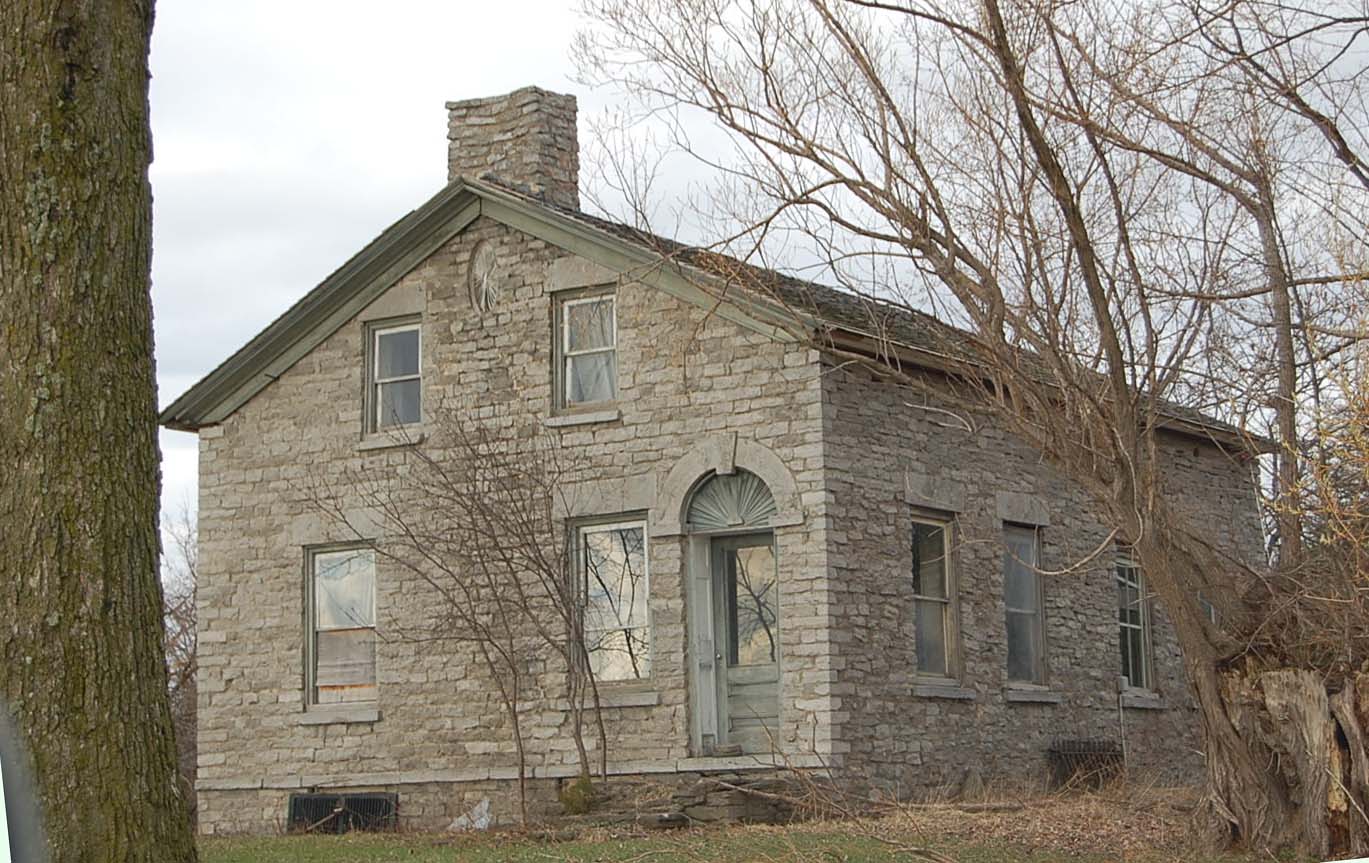
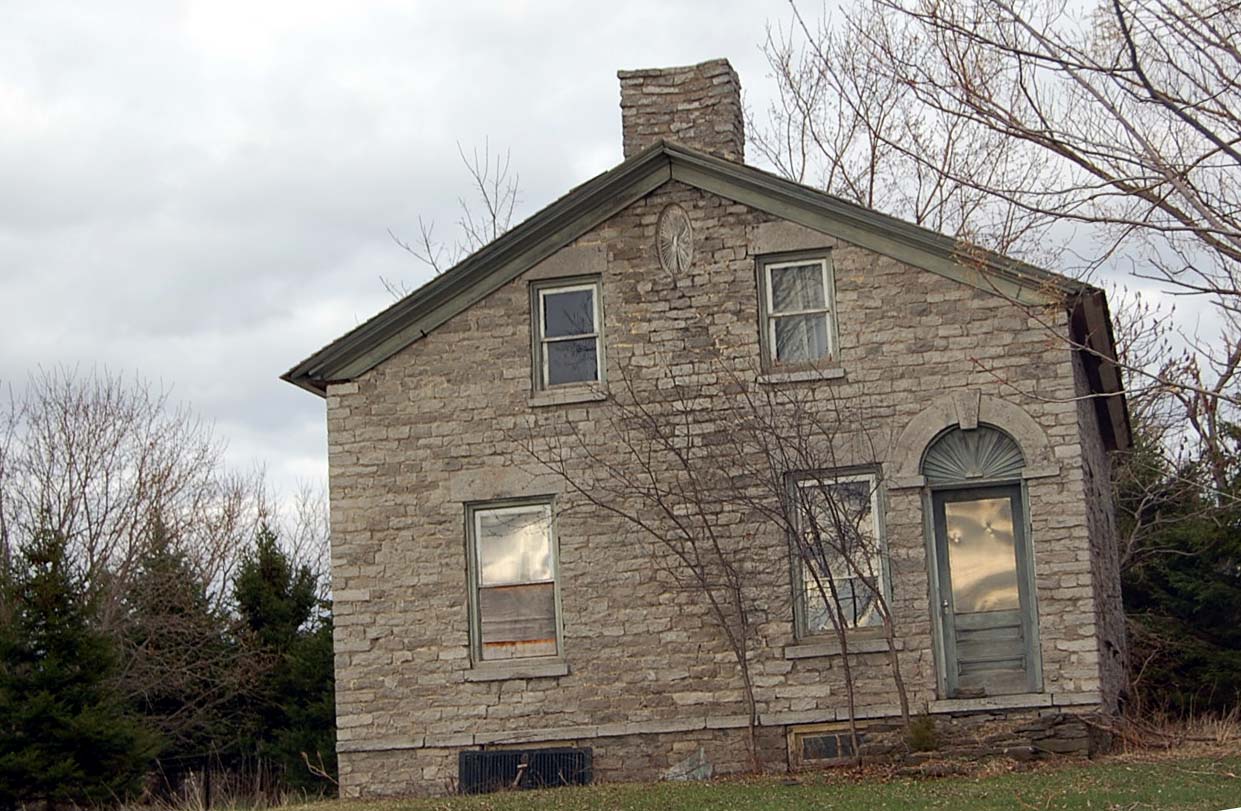
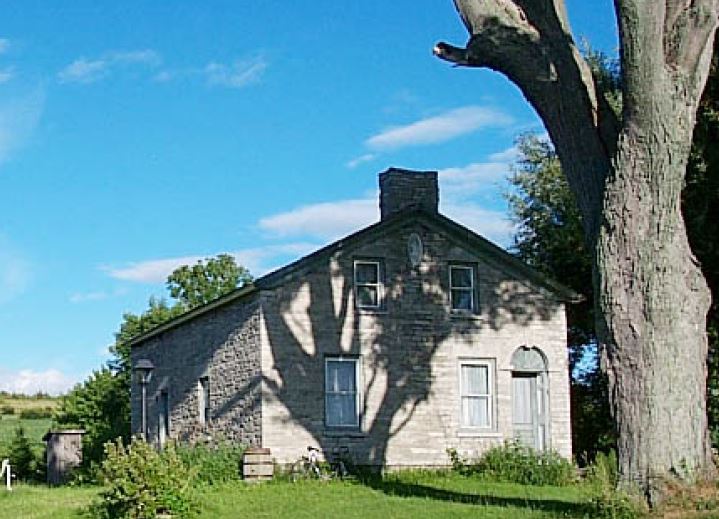
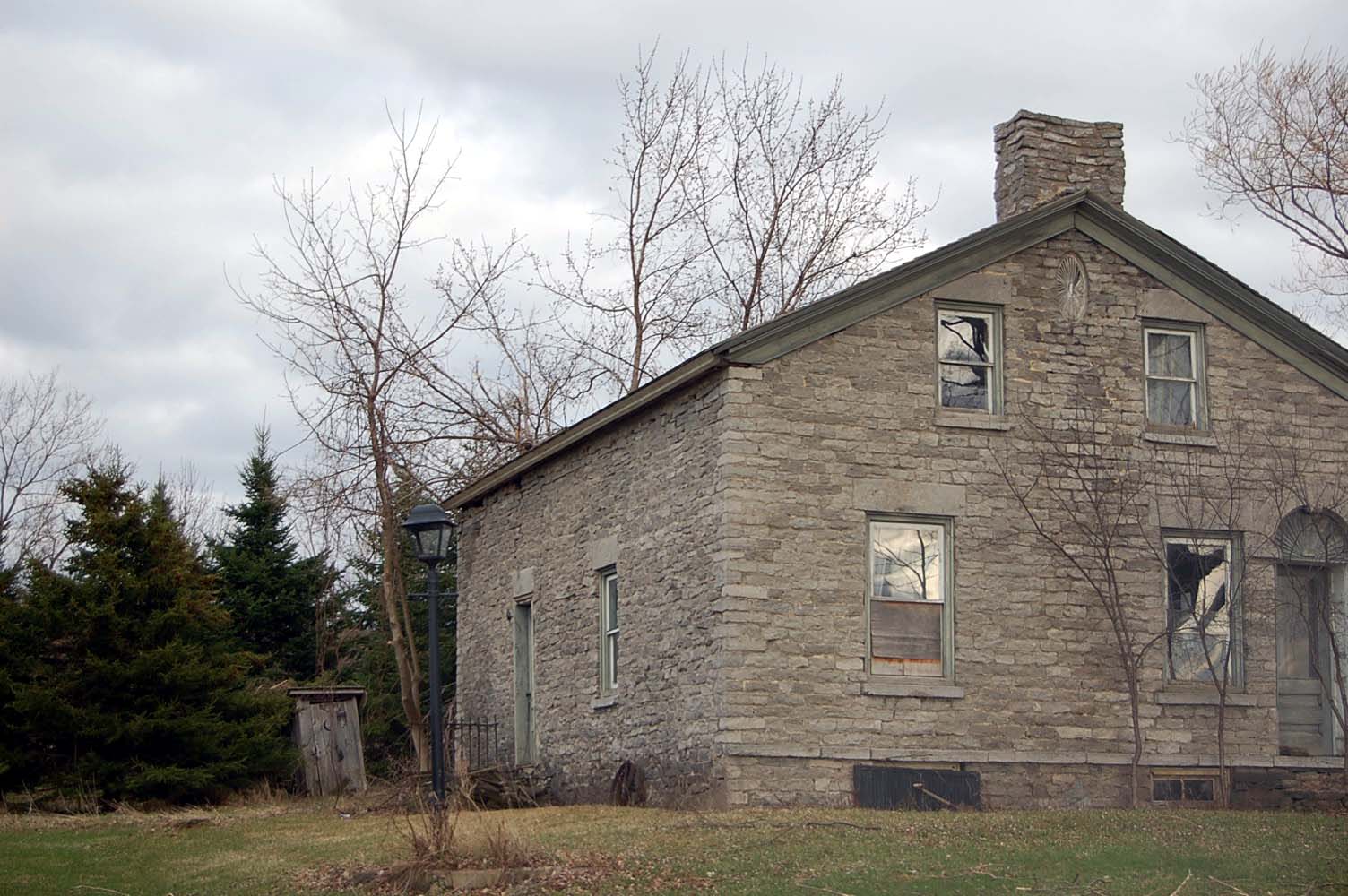
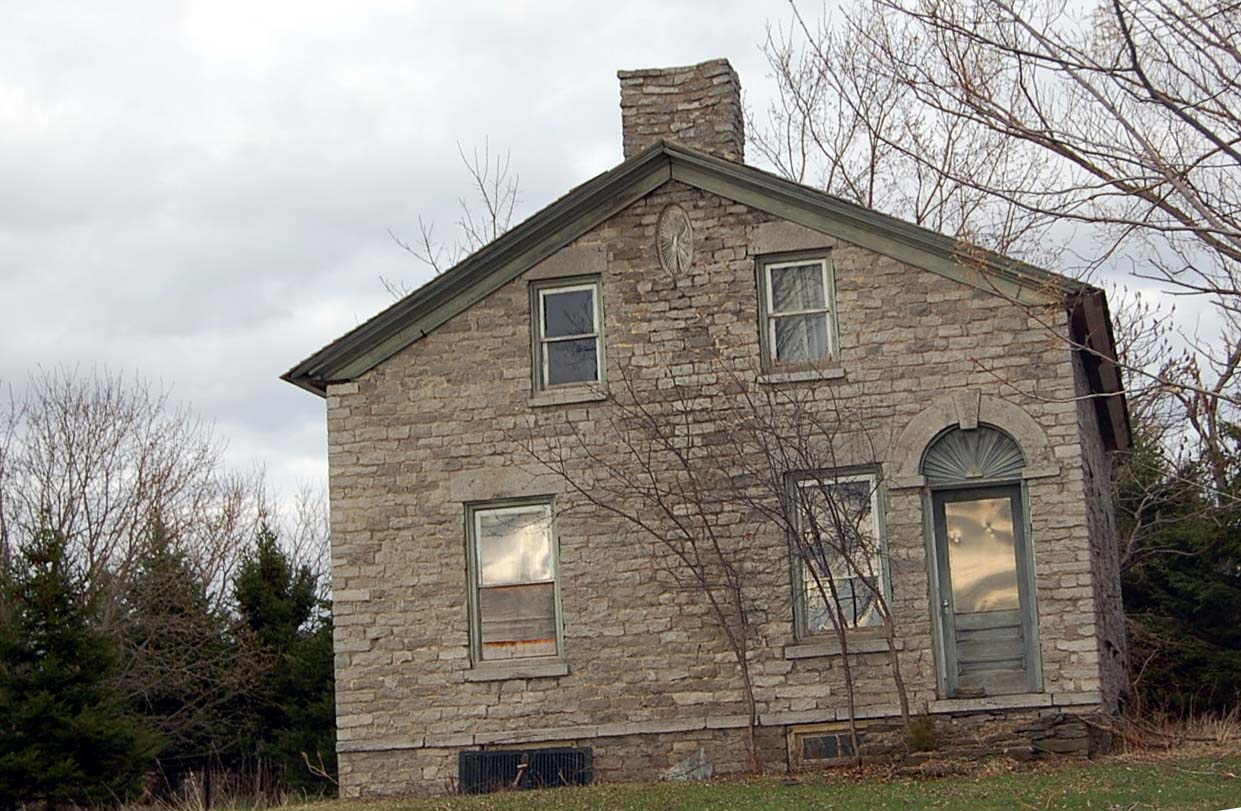
Simple architecture and highly attractive setting make for unusual charm
of the little stone house located on the outskirts of Smithville towards
Roberts Corners. It is on the town of Adams side of the highway which
straddles the boundary between the towns of Adams and Henderson. There
is no definite data as to the builder or date of construction, but it
is believed to have been built about a century and a quarter ago by Austin
Robbins, a New England millwright and wagonmaker who settled near Smithville
in 1807. Since November 18 1931 the house and nearly 407 acres of farm
land that goes with it has been owned and occupied by Howard R Clark and
wife, Mrs Dorothy K Clark.
There is one construction detail in particular which shows a similarity to some of the other houses in the Henderson area. It is the little oval or elliptical ventilating window in the front gable. While it is smaller and of a different elliptic than the one in the Burnham house at Henderson, it may have had the same designer.
Austin Robbins, who owned and resided in the house for many years was born in Marlboro, Massachusetts, September 23 1786. At Smithville he pursued the occupation of farmer and wagonmaker and died in 1867 having accumulated up to that time about 250 acres of land.
One of Austin Robbins' children was Appleton W Robbins, who resided on a neighboring farm. Albert A Robbins, one of the children of Appleton W Robbins was the father of Glenn S Robbins and between 1912 and 1914 Glenn S Robbins began the acquisition of adjoining farmlands, which resulted in building up of a large agricultural development of 406.66 acres inclusive of the old home. However, on September 20 1928 Glenn L Robbins and wife, Mrs Mertie J Robbins by Attorney William K Mott as referee transferred the property to the Pennsylvania Joint Stock Land Bank of Philadelphia, Pennsylvania, and in turn sold it to Mr and Mrs Clark three years later.
The stone house, with its broad stone chimneys, has been maintained in excellent repair and the front steps has been ornamented by wrought ironwork, which artistically sets it off. The original windows and the front door have been kept in excellent condition and the large willow tree at the front of the house greatly adds to the beauty of the place. The house itself stands upon an elevation and the view from the Smithville side and rear, back across the Stony creek valley constitutes a most pleasant vista.
Mill Street
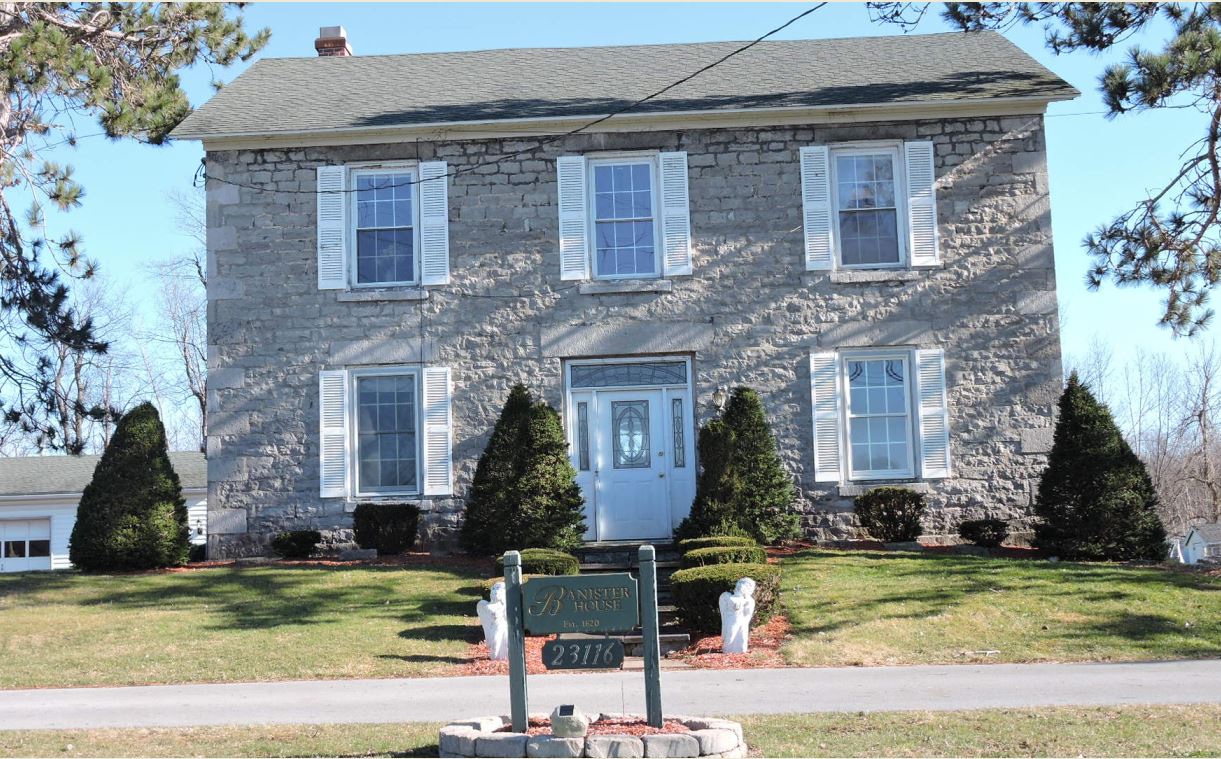
Osmund Banister, one of the early residents of the town of Pamelia, who settled there after the War of 1812 and before 1819 bought 110.9 acres of land from James D LeRay de Chaumont March 13 1820 for $1,220. It was located not far outside of the northern limits of this city on the road to Sanford's Corners close to a crossroad that connects with Pearl Street
In that spring of 1820 the first town meeting was held and Mr Banister was elected one of the school commissioners. Later with ox-teams limestone was drawn from the Henry P Smith farm across the creek and carefully cut for the walls of his substantial and comfortable stone house which he caused to be erected for his home. Osmund Banister lived in the house with its large fireplace and baking oven in the basement until his death June 23 1862. Connected with the property in those days was a cheese factory. Besides his wife, Charlotte, Osmund Banister was survived by his children: Morris, Gouverneur, Giles, Charles W, Mercia, Eliza, wife of Justus White, all of Pamelia and Wayne of Watertown. Gouverneur Banister became the owner of the house and from him it went to his son, Albert, who in turn willed it to his two sons, Morris G Banister, contractor-carpenter, 619 Arsenal Street, and Albert J Banister, Evans Mills. March 2 1912 Albert J sold his interest to his brother Morris G, who October 15 of that year conveyed the property to Orville V Howard.
Mr Howard kept it until September 9 1929 when he disposed of it to George
P Ashbocker, who died September 27 1923 leaving it to his son, George
L Ashbocker, his only heir. The latter sold 41.95 acres of the land together
with the house to William L Ottmuller of this city on March 1 1924. There
Mr Ottmuller established greenhouses and engaged in the business of florist
and gardener which he has since continued. For 20 years he has owned the
old house which for almost a century was retained by the Banister family.
It is on a much-traveled motor route to the north and has attracted the attention of thousands and hundreds of thousands of people in the nearly 125 years of its existence. The architecture is plain, simple Georgian without ornamentation, but the house is staunchly built and as sound today as when it was erected. The original broad stone chimney that led from the old fireplace was removed some time ago and replaced by a much smaller brick one.
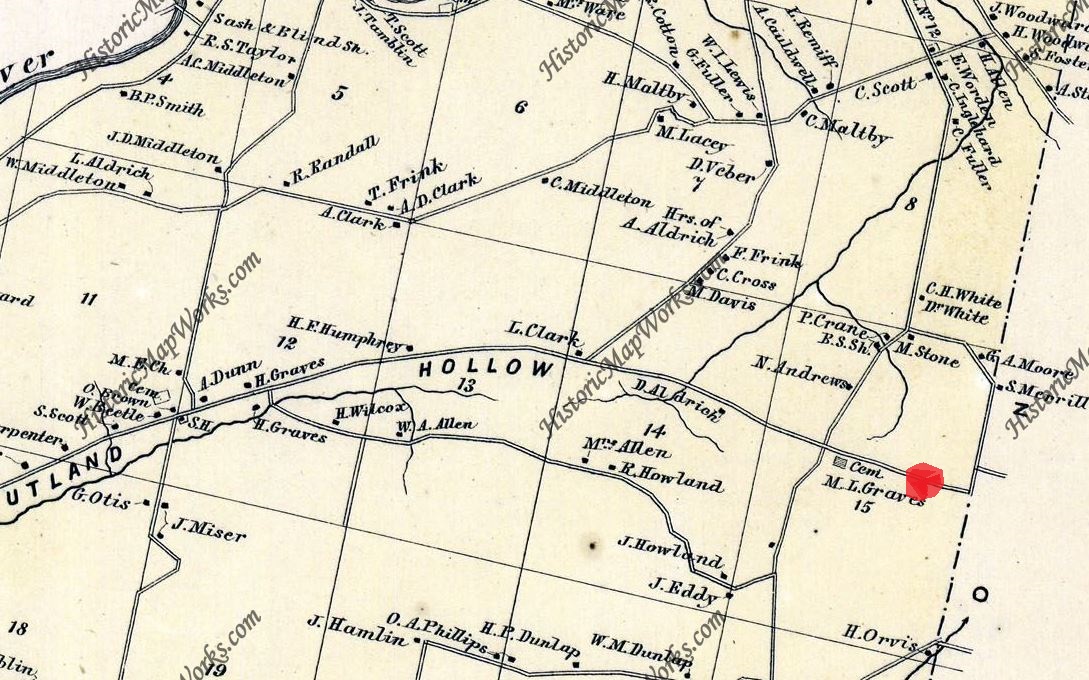
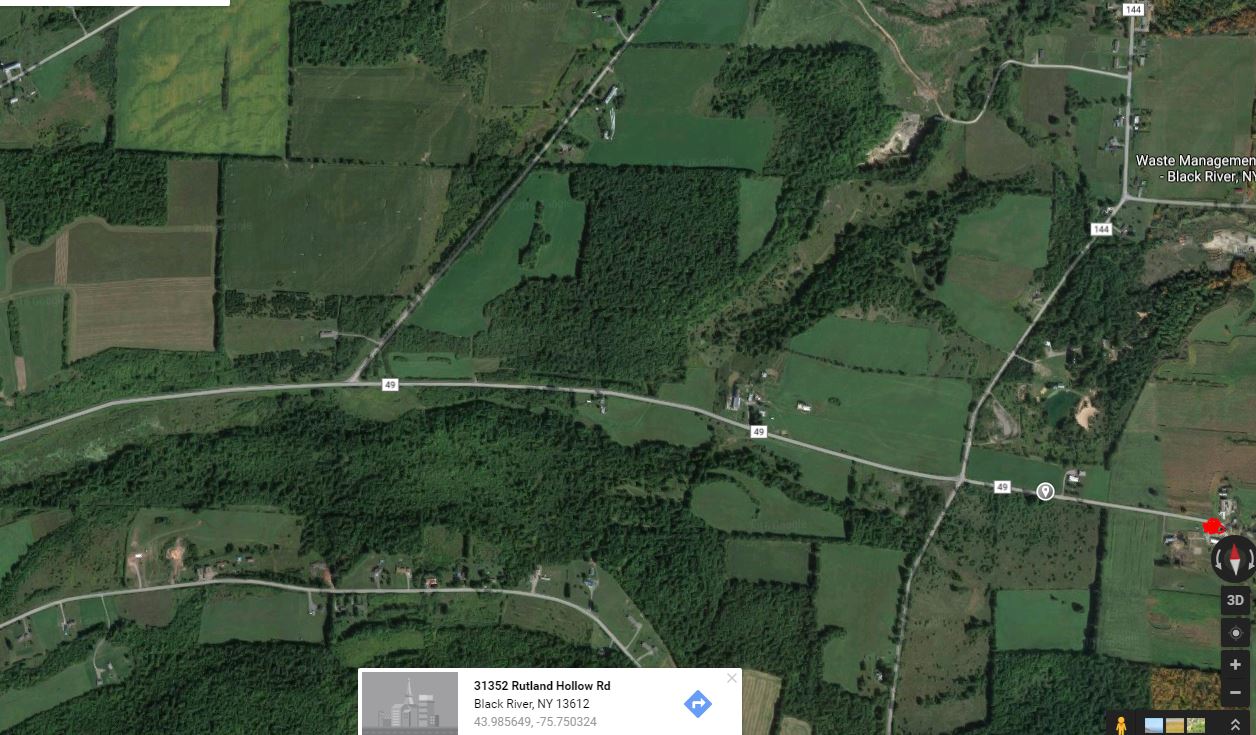
Jonathan Graves Jr was the son of Jonathan and Elizabeth Lisk Graves of Shelburn, Massachusetts, who migrated to the town of Vienna, Oneida county. In 1801 Jonathan Graves Jr, and John Cotes were among the first settlers of the town of Rutland. March 24 of that year Graves was married to Coates' sister, Mrs Nancy Grannis, widow. In 1820 according to the date carved over the door Graves built the stone house of the English cottage type at the far end of the Rutland Hollow road almost to the Champion line. Shortly afterward the library of the Young Men's Literary association was established at his house and near it one of the early schools of the district was erected. Graves was a Universalist and an ardent Democrat. His wife was a Baptist. He died April 13 1849 and his wife on October 2 1866. Their children were Nancy M, Martin L, Elijah and Hannah T. Martin Lisk Graves, the elder son, was born August 14 1811 and remained on the farm with his parents. Elijah became prominent as a teacher in northern New York.
Like his father, Martin Lisk Graves was a Jeffersonian Democrat and cast his first vote for Andrew Jackson in 1832. March 19 1840 he married Matilda E, daughter of Nathan and Polly Jones Wood, born March 1 1821 in Fairfield, Herkimer county. Children of Martin and Matilda were Mrs Edward F (M Adeline) Johnson and Louisa E Graves.
By various acquisitions between February 22 1813 and March 8 1867 Jonathan Graves Jr and Martin Lisk Graves built the farm up to 198.68 acres. A substantial wooden addition was erected at the rear of the stone house and both exist today in excellent preservation. Jonathan Graves Jr was one of the original members of the Jefferson County Agricultural society, of which Martin Lisk Graves also became a member. At 21 Martin Lisk Graves was inspector of schools and later was school commissioner. For three years 1851-2-3 he was supervisor. In 1845 he was loan commissioner of the county and continued until the fund was consolidated with the U S Deposit fund in 1850.
In 1883 Gov. Grover Cleveland appointed him commissioner of that fund and he held the position until his death March 22 1890. Frequently he was a delegate to Democratic town, county and district conventions and many times refused nominations for office.
In 1874 the Farmers' Alliance party nominated his and the Democratic party endorsed him for congress in the 22nd district of Jefferson, Lewis and Herkimer counties.
George A Bagley, city, Republican, defeated him 14,391 to 13,255 in the district. The Jefferson Leather Manufacturing company, Felts Mills, made him president to close the business, but M L Graves & Company continued the tannery till his death. Mr Graves also dealt extensively in livestock. He willed his farm jointly to his widow and daughter, Louisa. April 28 1913 Louisa E Graves sold the farm to William E Wood reserving right to use the south half of the stone part, halls, stairs and cellarway. October 25 1912 Wood sold his interest to Edward L Shannon and February 1 1922 she also deeded her rights to Shannon, the present owner.
W Main St
Colonel Newton B Lord, Civil War veteran and South American railbuilder,
member of one of Jefferson County's first and most important families
of industrialists, one time owned and occupied this most attractive and
tall pillared mansion on the south side of Basin Street, Brownville. Since
the death of her father, James M Waite, 98 on February 26 1942 the property
has been owned and occupied by Mrs Reginald O (Sara Waite) Tulloch.
Prior to that Mr Waite, distinguished veteran of the Civil War, had owned the property from September 9 1918 having purchased it from Miss Ida A Lord.
Like many of the other old mansions of the north country the date of construction is unknown. There is a family tradition that it was built by Colonel William Lord, father of Colonel Newton B Lord and manufacturer of the first iron plough, in this section, if not in the entire country. There are no evidences of fireplaces in it, leading to the belief that it was erected after stoves had come into common use. The construction of the house and its 13 rooms is of the finest workmanship. The interior woodwork is beautifully mitred and joined and a graceful arch connects one of the large living rooms with the dining room. Originally the grounds extended back to the river bank.
Colonel William Lord, born at Woodstock, Vermont, in June 1792 came to Brownville in 1809 to keep books for his uncle, William H Lord, keeper of the Brownville hotel. Responding to the call to arms Colonel William worked to save Sackets Harbor from the British and organized the first rifle regiment in the county, becoming its colonel. With Henry Caswell he established a furnace, foundry and machine shop at Brownville in 1820. There he made ploughs, stoves and other articles of iron. Eventually the business was carried on by his sons, especially Newton and Newton and Gilderoy. William Lord, whose wife was the former Miss Charlotte Thomas of Mather's Mills, was one of the most able promoters of the Watertown & Rome railroad and became one of the first directors of that company.
His son, Colonel Newton B Lord, was born at Brownville January 1,1832 and became a foundryman and machinist. He was married to Miss Cornelia A Stone of Milwaukee, helped organize and eventually became colonel of the 35th NY. Vol. Inf., early Civil War regiment, and later organized and became colonel of the 20th NY. Cavalry. After the war he became a prominent railroad builder in Chili, where he died July 14 1890.
A portion of his house site was sold June 15 1843 by Thomas L How, Brownville realty owner, to Milton M Ballard. September 15 1846 Ballard's heirs sold it to Henry Lord, who disposed of it to Newton B Lord March 26 1857. September 26 1864 they disposed of it to Daniel Parker, who sold it December 1 1871 to Albert E Lord, long Brownville postmaster and general store proprietor. From him it passed to his daughter, Miss Ida A Lord, who sold it to Mr Waite in 1918.
116 W Main
Colonel William Lord, manufacturer of the first iron plough in Jefferson County, veteran of the War of 1812 commander of the county's first rifle
regiment, was the original owner of this house. It is of brick construction
and symmetrical design, the date of its building having been about 1828.
A peculiarity of its architecture is the lack of an entrance in the main
front. At the sides of the mansion are evenly balancing wings.
The old mansion is on the south side of Basin Street, Brownville, just across ancient Storehouse alley from the mansion shown last week, that of Colonel Newton B Lord, a son of Colonel William Lord. Colonel William Lord, intimate friend of General John Adams Dix, governor of this state in 1873-4 played a leading role in the industrial development of this county and was one of a family of mechanical geniuses. His immigrant ancestor was Thomas Lord, a smith who sailed from London, England, April 19 1635 in the ship Elizabeth and Ann. The family trail through ensuing generations led out of Massachusetts into Connecticut up to Vermont and over into New York.
Born at Woodstock, Vermont, in 1791 Colonel William Lord came to Brownville in 1809. He married Charlotte Thomas of Mather's Mills, established a furnace, foundry and machine shop with Henry Caswell in 1820 and made the first iron plough, in the county, now in the Smithsonian Institute. In 1830 in partnership with Alanson Skinner under the name of Lord & Skinner he erected a stone furnace building where ploughs, stoves, etc., were manufactured and in 1837 the partnership of Lord, Skinner & Goulding was making a satinet power loom from patterns of George Goulding, founder of the Bagley & Sewall company.
At Brownville's first village election May 5 1828 Colonel Lord was chosen
as assessor. In 1833 he was president of the village and in 1841 supervisor.
August 31 1860 he was one of the incorporators of the Brownville Literary
& Educational Association and the following December 30 was a leading
incorporator of its successor the Brownville Literary association.
Colonel Lord died April 9 1879 aged 87 years, nine months and 23 days. A special train bore 150 prominent Watertownians to his funeral April 12. That same year in the old stone furnace of Lord & Skinner was established by Orville Haight and Lane Brothers Brownville's first paper mill. It was a strawboard mill. A few years later it became part of the plant of the Outterson Paper company, then passed to the Harmon Paper company and finally to the Philemon Creek Paper company. August 27 1886 Judge Ross C Scott as referee sold the Colonel William Lord mansion to Mrs James (Fayette C) Morrison and Mrs Reuben (Pamela B) Bosworth, daughters of Colonel Lord.
For many years Mrs Bosworth and her husband. Prof. Bosworth, noted teacher, scientist, astronomer, resided there. Eventually the Harmon Paper company acquired the house. Then it went to the Philemon Creek Paper company, which transferred it to the Northern New York Trust company March 19 1934 and May 10 1937 the Trust company sold it to Mrs Jane C Devendorf, daughter-in-law of Mr and Mrs Perl W Devendorf and it has since been the residence of the Devendorf family.
The Judah H Ainsworth Farm House Near Cape Vincent
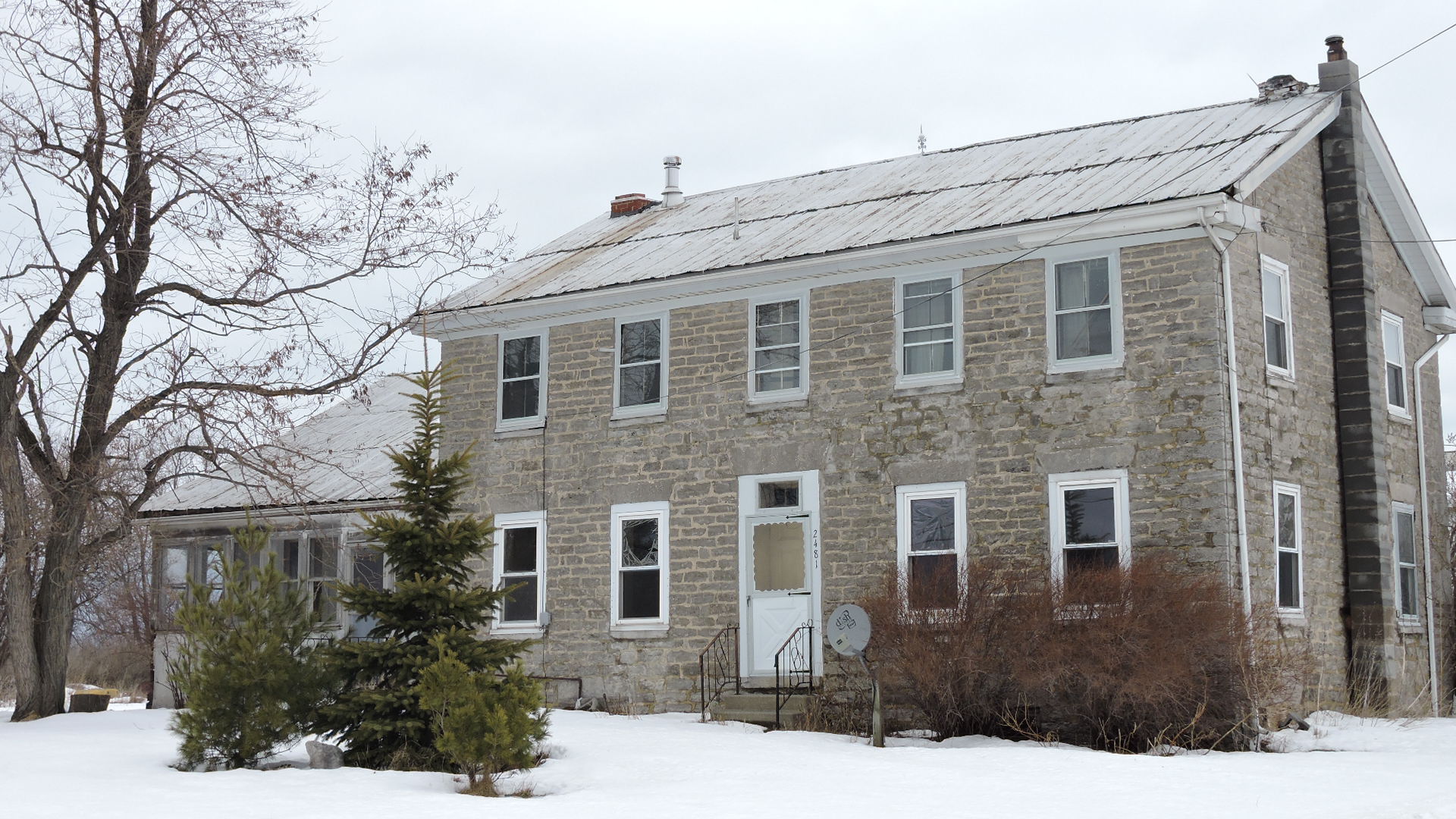
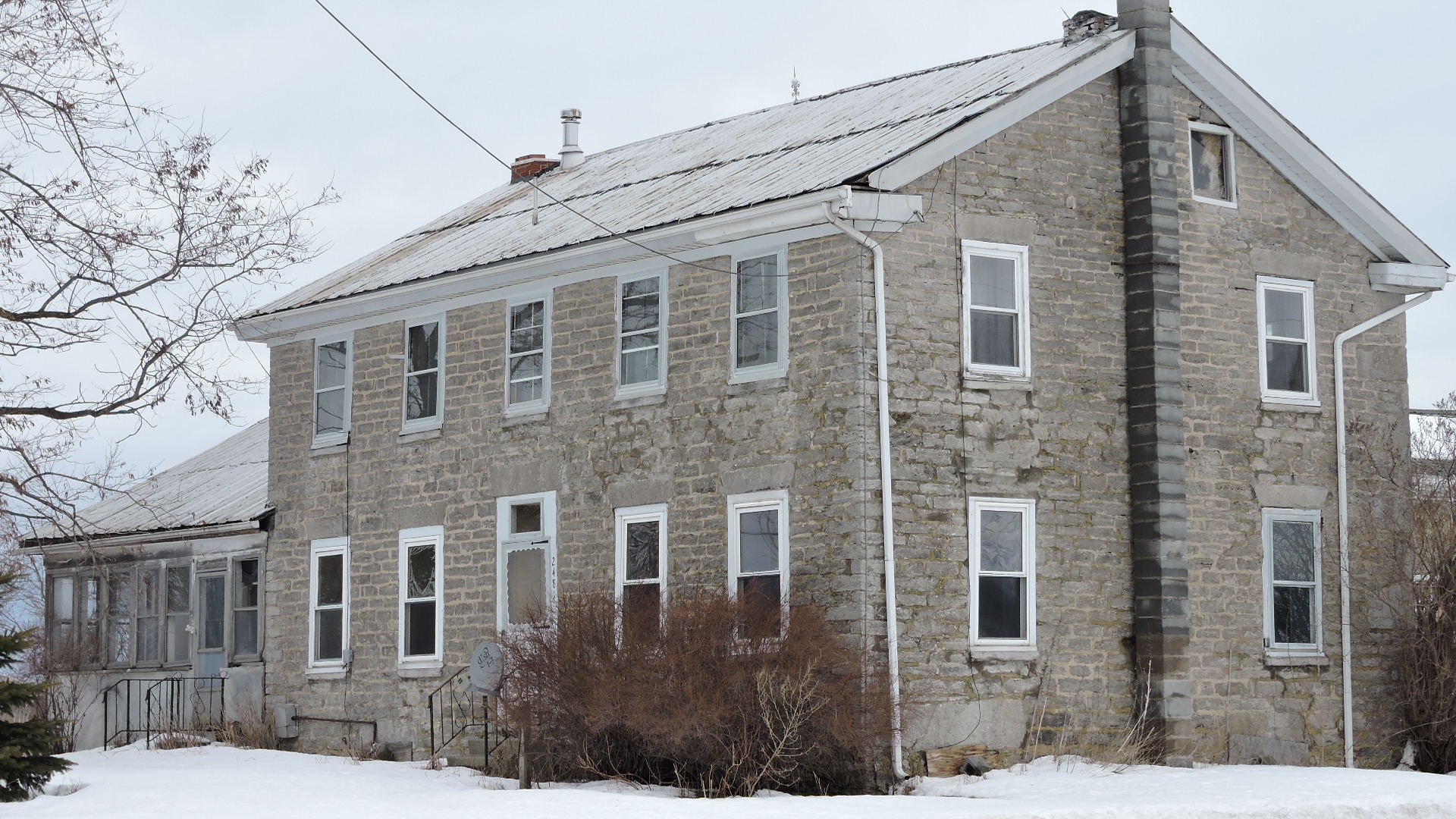
An example of architectural solidity and simplicity in native limestone is the old Judah H Ainsworth farm house that sits close to the easterly side of the Watertown-side of the Watertown-Cape Vincent state highway about a mile and a half outside Cape Vincent village. For the past 11 years it and its 110 acres have been owned by Mrs Karl H Borland, Cape Vincent, who inherited it from her mother, Mrs Henry W (Fanny M Ainsworth) Marks.
Among the earliest and most outstanding settlers, of that section of the town of Lyme,which is the now town of Cape Vincent, were the Kelseys, the Ainsworths and the Borlands. Their lands were not far from each other on a line extending from the Judah Ainsworth place at right angles with the Watertown-Cape Vincent road towards Wilson's Bay. There were Eber Kelsey, the builder, who came in 1809 to act as agent for Vincent LeRay; Willard Ainsworth, the Vermonter, who came in 1819 and later served nine years as supervisor, and James T Borland who came from Montgomery county in 1815 and had extensive holdings.
The latter's son, James T Borland Jr, married Hannah Sophia Kelsey, granddaughter of Eber Kelsey, and their son Dwight M Borland was the father of Karl H Borland, whose wife is the daughter of the late Henry W Marks, Cape Vincent lumber merchant. Mr Marks married Fannie M Ainsworth, daughter of Judah H Ainsworth, who was a brother of Willard Ainsworth Jr, and of Henry Ainsworth, sons of the senior Willard Ainsworth, the supervisor and one, time deputy collector of customs. Henry Ainsworth married Helen Maria Kelsey, sister of Hannah Sophia Kelsey Borland, thereby completing the tri-family relationship circle.
The history of Mrs Karl Borland's farm, of course, goes back to Vincent LeRay, and the record shows that it was built up of two parcels, one of about 41 acres sold by LeRay October 27 1830 to Josiah Pryor Sr, for $327.60 and the other of about 100 acres sold by LeRay to Richard M Jones February 11 1833 for $950. At the end of five years Isaac Jones bought the latter, kept it twelve years and disposed of it to Richard W Ainsworth for $3,000 this price indicating that there must have been a house on it then.
In 1833 Josiah Pryor Sr, sold the 41 acre tract to William Estes, who retained it five years and disposed of it to Calvin Wright for $500. Wright sold it to John W Little October 1 1849 and a month later Little sold it to Richard W Ainsworth. The latter on May 6 1856 then a resident of McLean county. He sold both parcels as one farm to Judah H and Willard Ainsworth Jr for $6,750 and on January 13 1860 Willard Ainsworth Jr disposed of his interest to his brother Judah for $3,000. From Judah the property passed to his daughters, Mrs Helen M Lamson and Mrs Fannie M Marks and on August 31 1899 Mrs Lamson sold her half interest to Mrs Marks for $2,702.60.
The farm is now tenanted by Frank J Bourcy.
Walts' Farm House In The Town of LeRay
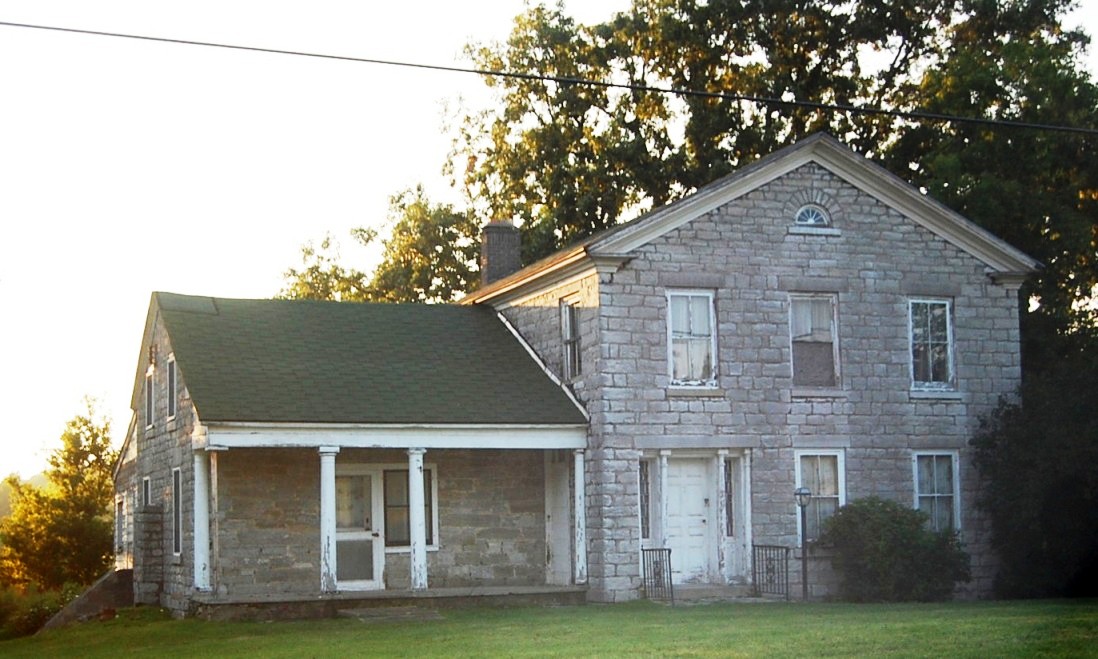
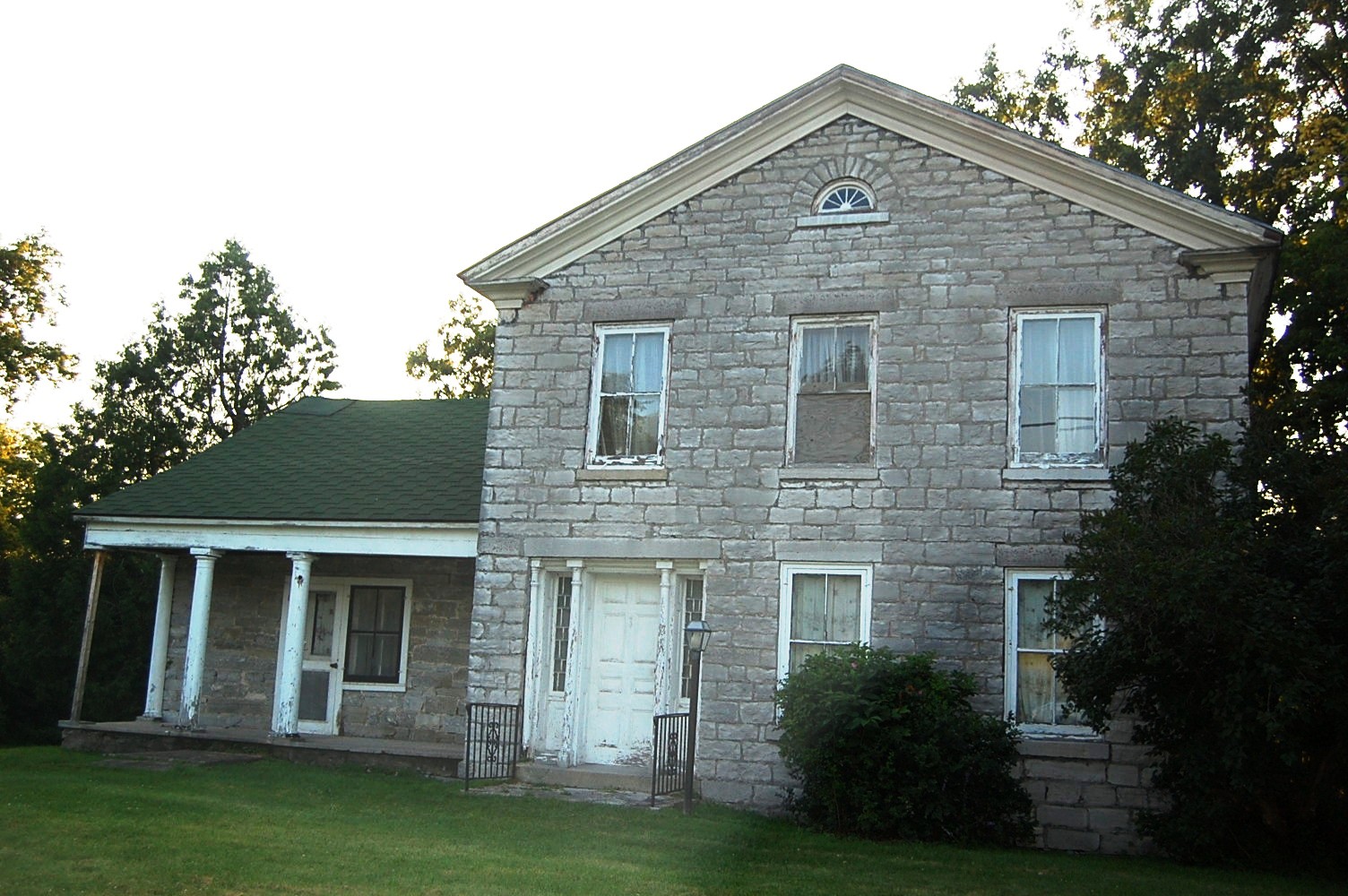
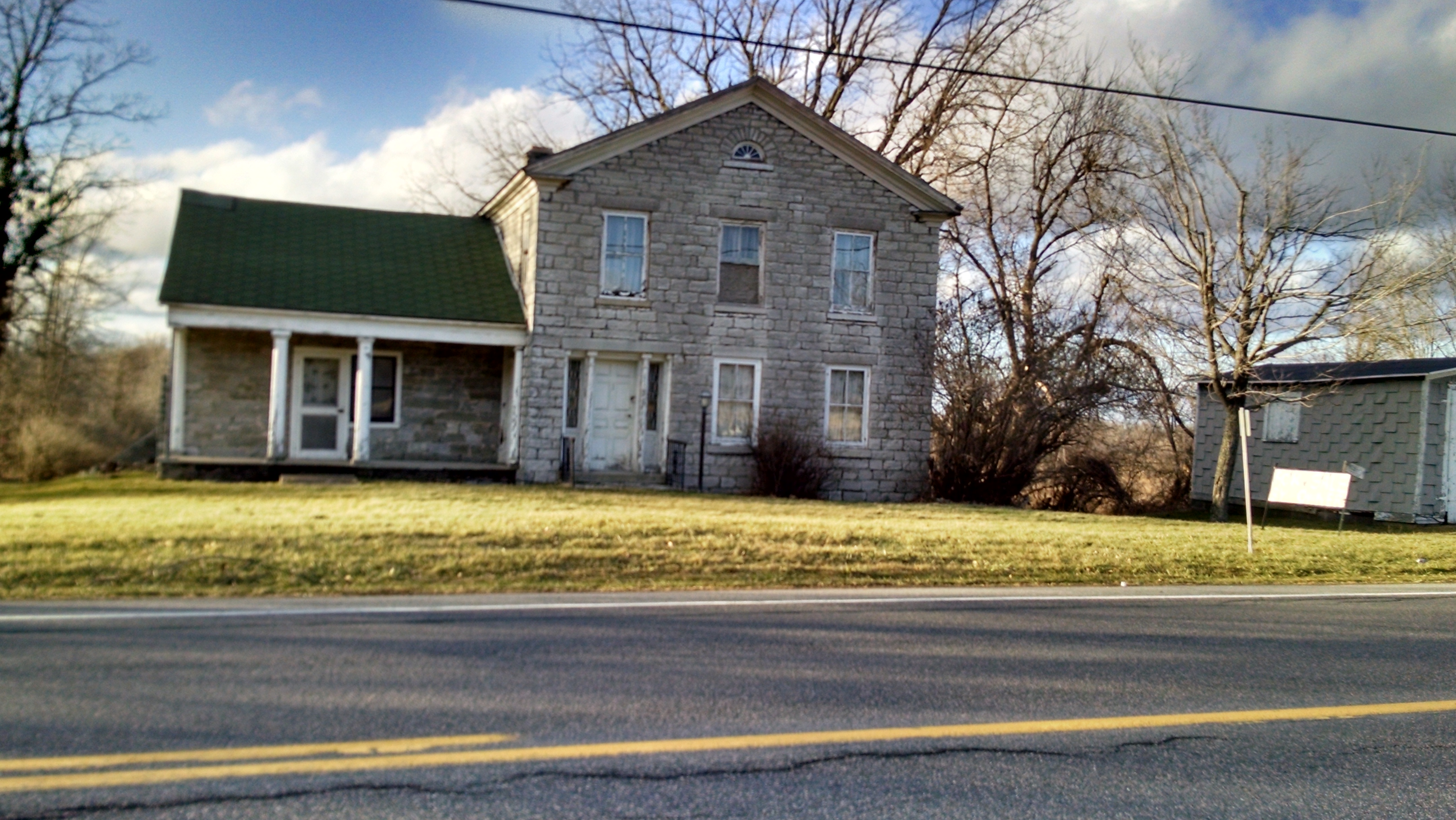
According to the realtor write up: this incredible 1825 stone house which has been formally occupied by noted North Country Author, Frederick "Fred" Exley. Much of Exley's acclaimed novel, "A Fan's Notes", was written here. Other noteworthy works include "Pages From A Cold Island" & "Last Notes From Home". Over 5 acres accompanies the home"
Says OFF MARKETsold in 2017.
One of the oldest of the farm houses (29917 NYS Rt 37, Evans Mills) in the town of LeRay is that owned by Miss Genevieve Walts of Passaic, N J on the old Military road leading from Pamelia Four Corners to Evans Mills. It is of native limestone construction and follows the Georgian manner of architecture so prevalent among the old stone houses of Jefferson County. Its appearance both exteriorly and interiorly is unusually cozy and homey and its location is in one of the most quiet and peaceful parts of the county. In those months of the year from May 1 to late October its setting is idyllic. It is of the side-hall type and its frontdoor or main entrance is most attractive, the original door having been kept with its flanking sidelights, but no transom window above. The little semicircular attic window, gracefully designed, instantly calls the attention of the eye and the trees in the front yard lend to the beauty of the property.
The house is said to have been constructed some time in the 1820s and it is placed in an area of the county, which produced many member of that family of Waltses, which included the late City Treasurer Frank Walts and the late County Judge Charles H Walts.
A half century and longer ago this property was known as the Strong place. Today there are not many who know much of the vital history of this farm, but several decades ago it was owned by the late Pitt W Strong. Pitt W Strong was a prosperous farmer and cattle dealer of the town of LeRay, who at one time resided in Brockville, Ontario On June 11 1894 he deeded the house with its 86.39 acres of land to Barzell W Strong, who followed in his footsteps as a farmer and cattle dealer and who was reputed to be one of the best dressed men in the rural section of the county.
When Barzell Strong died he willed this house and farm to Samantha Strong, his wife and after a few years she married Charles Dillenbeck removing to Eldorado, Kan. There she resided on June 24 1916 when she conveyed the property to Adelbert Walts. On September 3 1918 Mr Walts deeded a half interest to his daughter, Miss Genevieve Walts, stating in the conveyance that whichever died first, his interest in the property would go to the other. Mr Walts died January 30 1943 aged 83 years. Born September 19 1859 son of the late Mr and Mrs Robert Walts of the town of LeRay, he passed most of his life in his native town.
E W Merry House Near Evans Mills
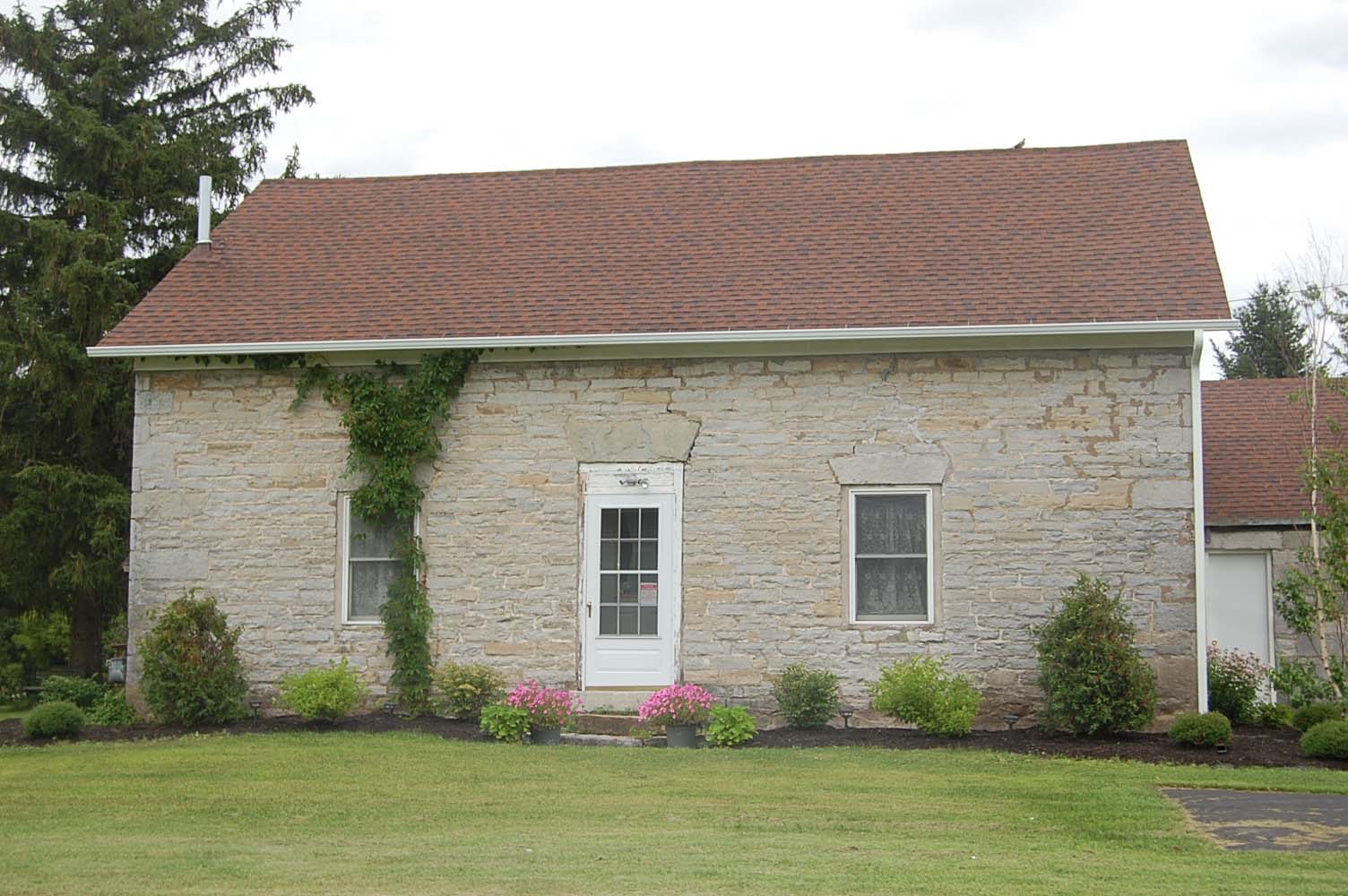
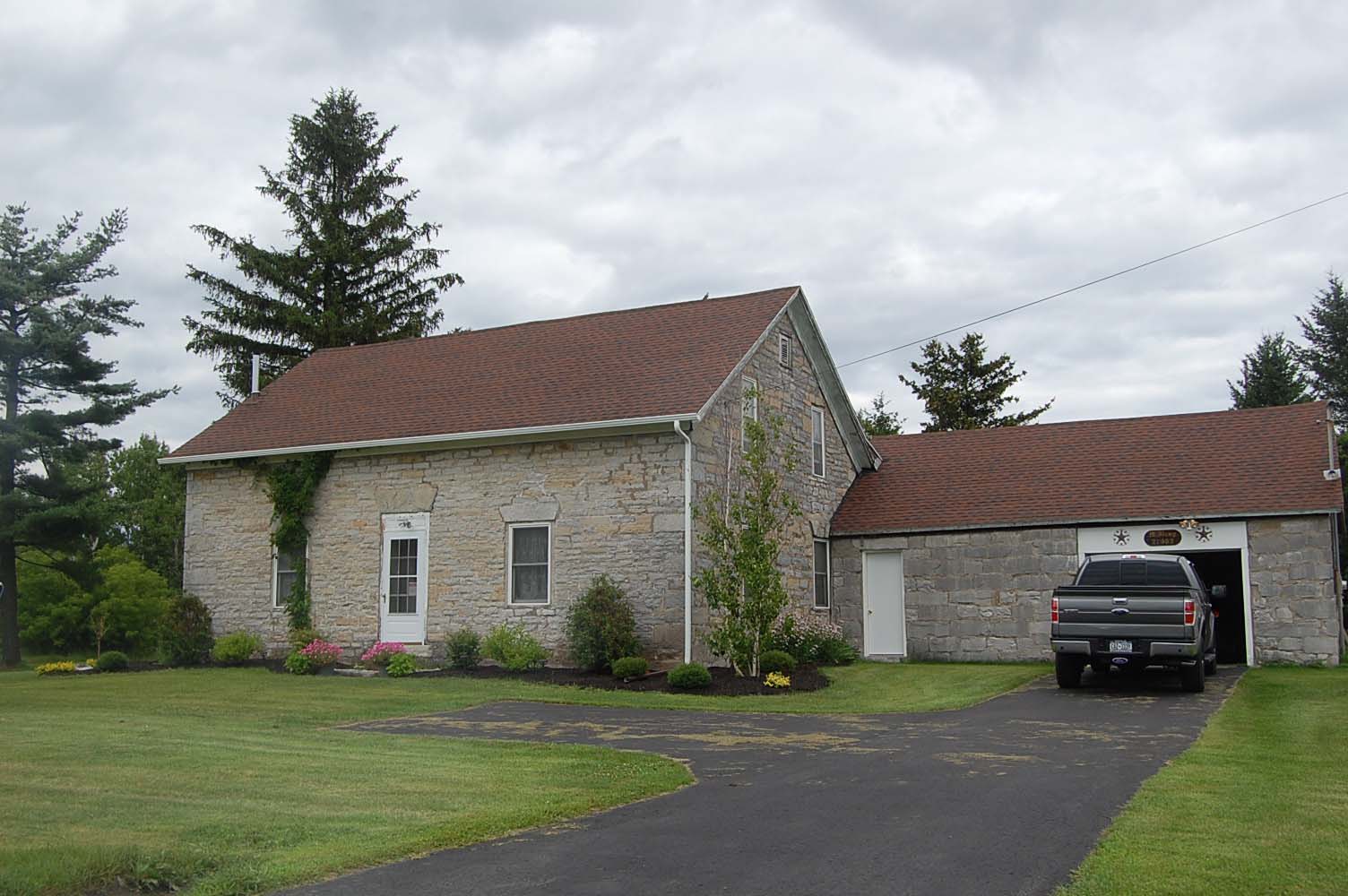
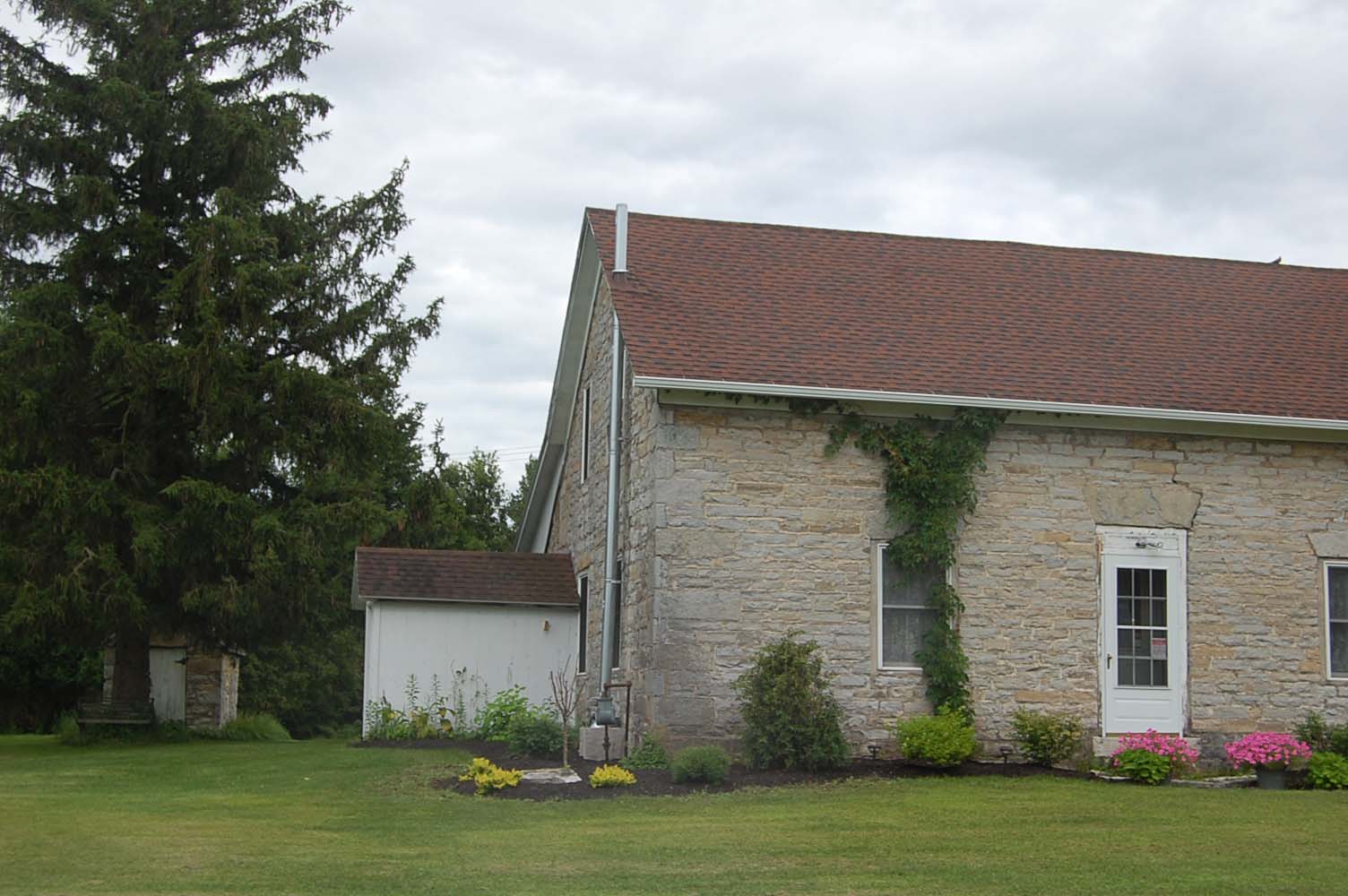
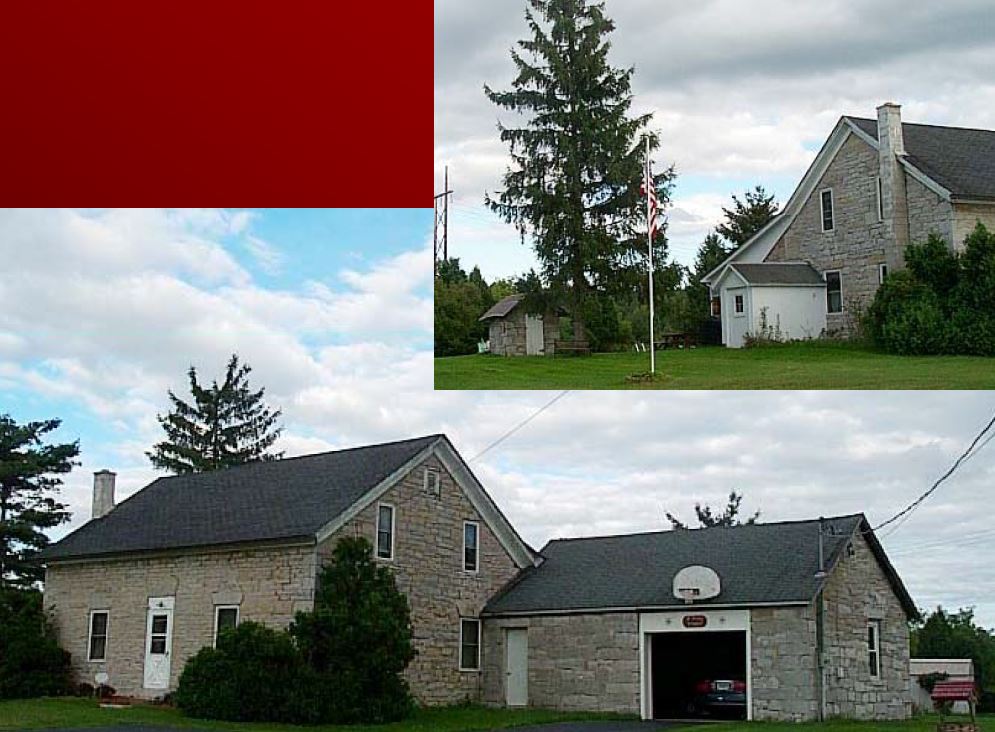
There is a New England touch to the little old limestone farmhouse of Mr and Mrs Elbert E Merry situated on the south side of the Watertown-Evans Mills state highway about a mile and a half towards Watertown from Evans Mills. In this respect the plainly architectural house is like the many to be found with garages or barns attached in the smaller New England communities. This is perhaps explained by the fact that Paul Anthony Jr, who is believed to have constructed and originally owned it, was a stonemason, who was born in Rhode Island in 1782 and at the age of 21 came first to Boonville, where he erected a log hut. From there he removed to the location on the old plank road about a mile and a half west of Evans Mills and remained until about 1837 when be again transferred to the town of Pamelia
Mr Anthony was the great grandfather of Mrs James A (Mina Anthony) Common of this city and his wife was the former Hannah Eddy of Rutland, Vermont He died at the home of his son, Thomas H Anthony in the town of Pamelia February 3 1873 in his 91st year. Paul Anthony Jr, and his wife were Quakers and during his long Jefferson County residence he built many stone houses as well as commercial and industrial buildings. He erected the old glass works at Redwood and the old stone hotel in Brownville as well as many other buildings.
County records show that he owned various properties at different times. His first purchase was made jointly with James Anthony October 31 1809 when they acquired 90 acres in the immediate vicinity of the present Merry place. In the same vicinity Paul Anthony Jr bought 88 acres from Cornelia Juhel January 24 1828 and July 1 1828 James purchased 77.73 acres from Cornelia Juhel. The two properties abutted and March 13 1835 finds James Anthony and his wife, Ruth, selling the Merry location to Paul for the nominal sum of $1. Whether the house was built then or before is not known. At any rate there must have been one on it March 1 1854 when Paul and Hannah Anthony sold this same property to Nelson Clark for $2,460. Charles P Clark got it from Nelson November 20 1862 and Thomas B Clark acquired it from Charles February 16 1865. Then on February 21 1866 Thomas sold it to Benjamin VanBrocklin, who died, leaving it to his family August 11 1874. Out of the VanBrocklin family it eventually passed after many years to J Philip Steinhilber who died May 18 1924 and on September 17 of that year, Attorney John H O'Brien as administrator, sold it to Mr and Mrs Merry.
Not far from the Merry house towards Watertown is another stone house of identical design owned by George B VanBrocklin. It doubtless was also built by Paul Anthony Jr.
24082 County Rt 47 Carthage NY
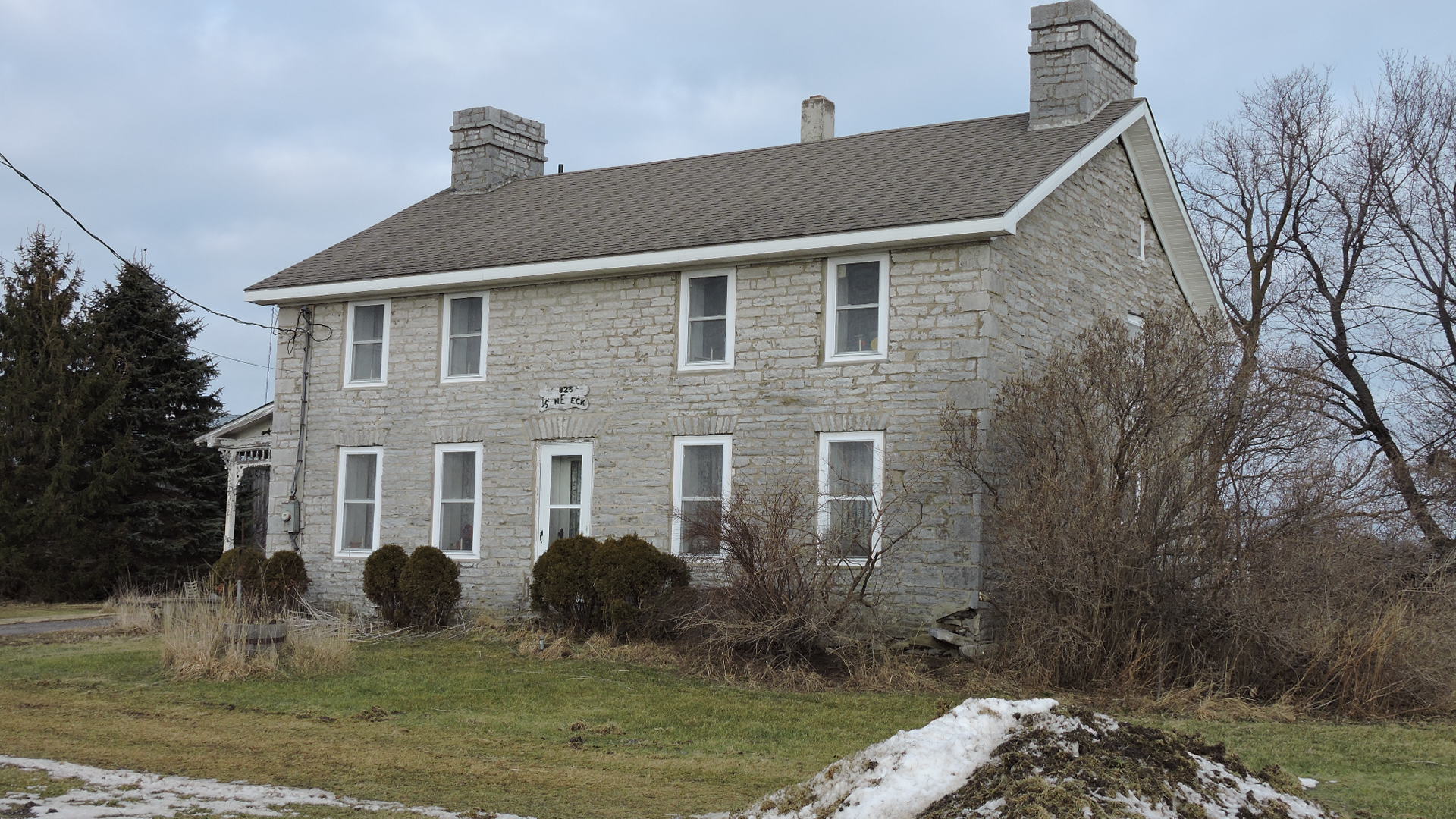
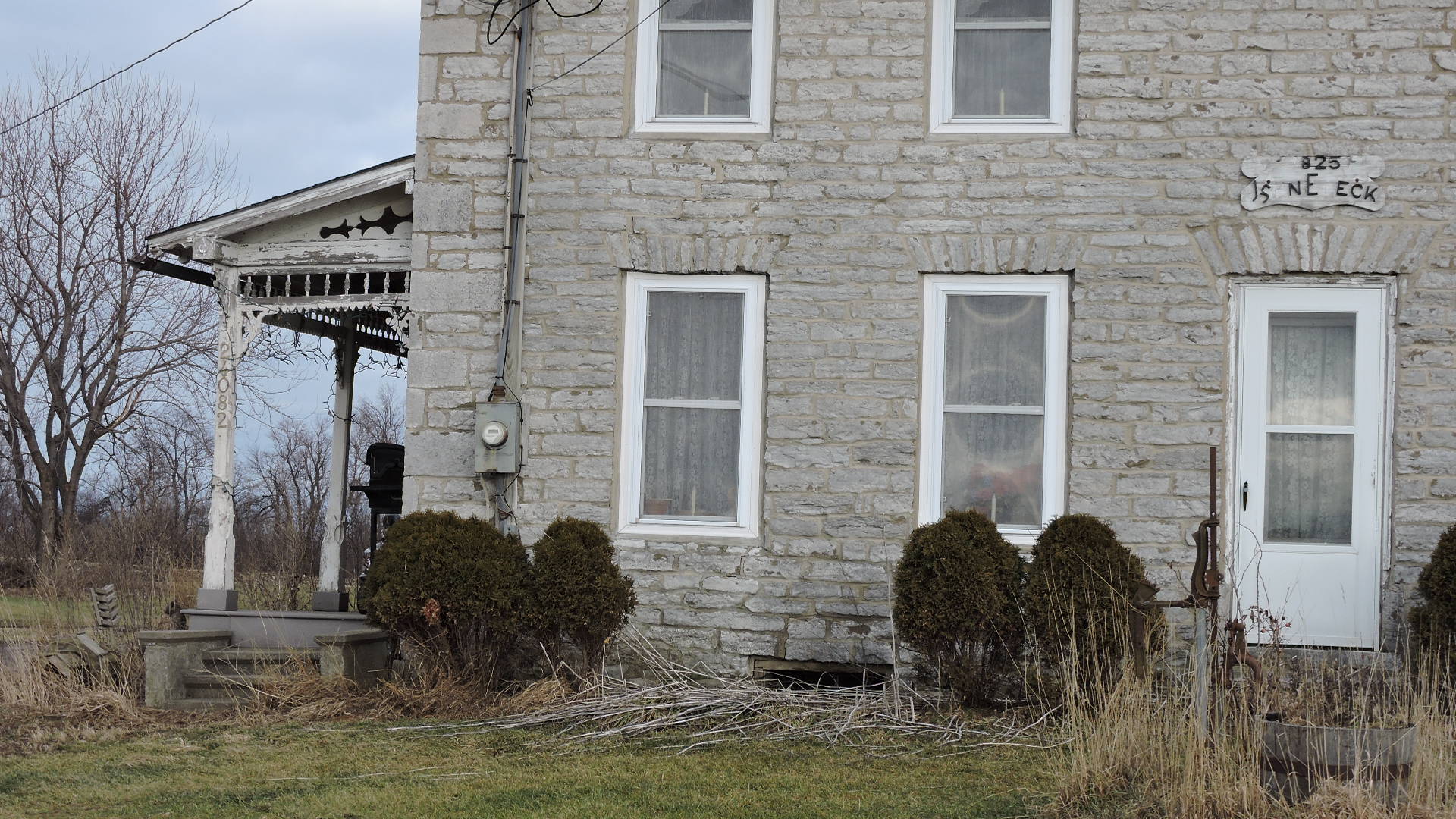
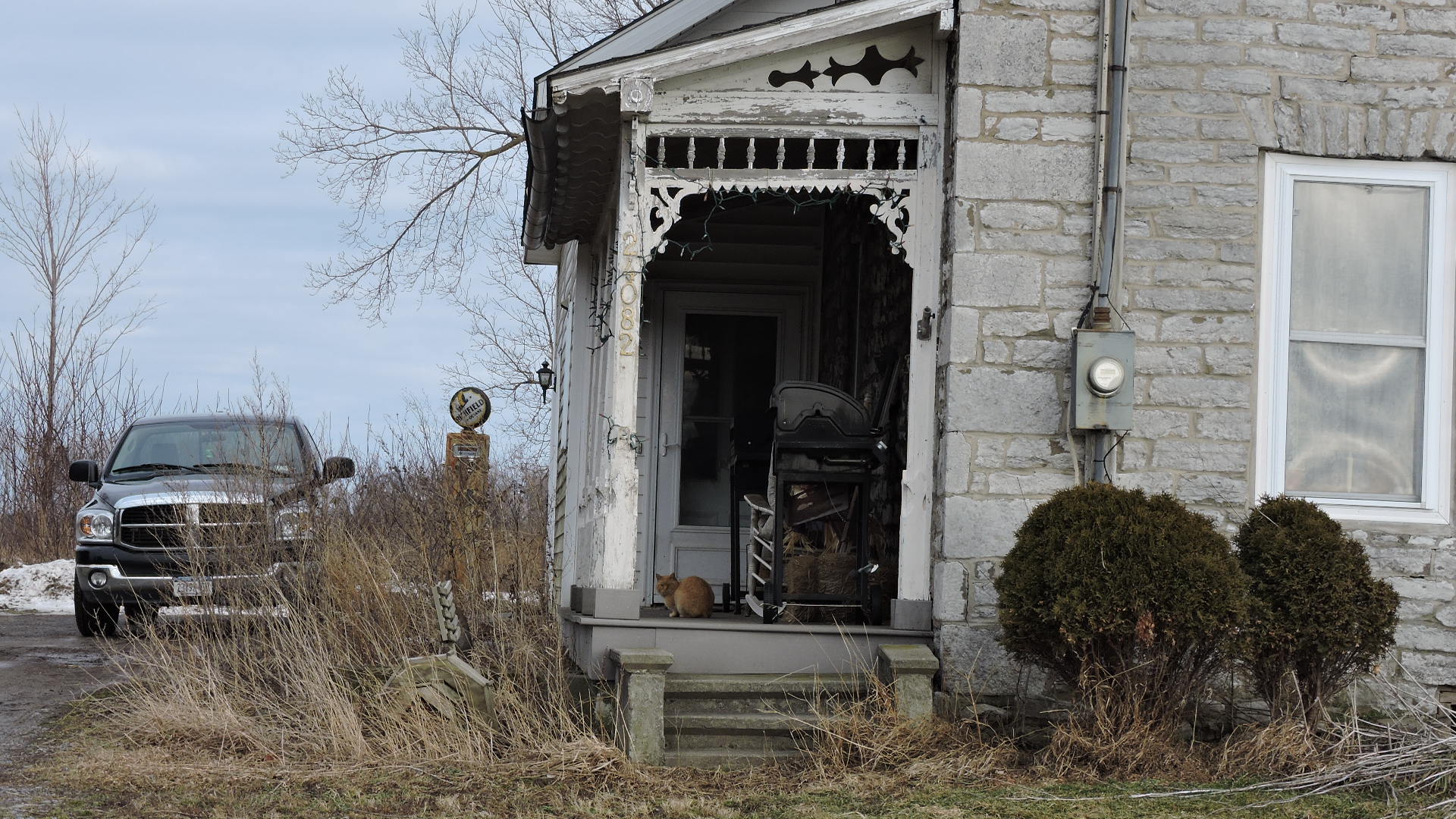
Pennock Mansion Near Great Bend
With his own hands Reverend Wilson Pennock built the fine old limestone mansion located about a mile from Great Bend on the east of the road that runs to Champion. The time of construction is said to have been about 1825 and the property, owned since April 6 1918 by Mr and Mrs Edward E Kohler, is next to the old Henry Peck farm, which also has a fine old native limestone house.
Rev Wilson Pennock, familiarly known as Father Pennock in his era, was one of the most dynamic ambassadors for good among the people of this part of the state 100 to 135 years ago. He was born at Hadley, Massachusetts, September 16,1789 and at 18 came to the town of Champion in 1807. The next year he married Sarah, daughter of Captain John Pardee, one of the earliest Champion settlers. Much devoted to religion young Pennock first became an exhorter in the Methodist church and later was ordained an elder. He knew intimately every settler in the region and his many kindly acts among them was responsible for the appellation, "Father" Pennock. Often he was called upon to travel 50 miles or more to officiate at the funerals of followers and many times he rode horseback for six weeks over wilderness roads stopping at many places to preach.
After clearing his land he became a large cattle dealer for 14 autumns drove herds for himself and others to Albany and sometimes to New York. During those trips he would send word ahead to the next community, and upon arrival preach to the people. He died on his farm June 16 1867 but on February 16 1865 had deeded it to his son, Emory J, making reservations that he and his wife should have the use of such portion of the house and farm as needed, be furnished with fuel, wood, lights, wholesome food, medicines, medical care, conveyance to go visiting and care of rooms. Wilson Pennock bought his farm of 100 acres from General Henry Champion of Gloucester, CT, June 14 1821 for $695.
His son, Emory J Pennock was born there February 28 1832 and in 1852 married Cordelia M, daughter of Abel P Lewis. Among Emory's seven children were William E Pennock, who married Emily A, daughter of John F Peck, and died December 23 1917; and Reverend Arthur F Pennock, DD, who died in 1931. After the death of Emory J Pennock his son, William E, continued to operate and eventually acquired the interest of the other heirs in the farm. His widow, Emila A, and their daughters, Mrs Lulu P Rockwood and Mrs Vera P Kohler transferred it to Edward E Kohler and Mrs Vera P Kohler April 6 1918 so that it may be said to have always remained in the Pennock family inasmuch as Mrs Kohler was a Pennock.
Edwin Coffeen White Mansion On White Road in Glen Park/Brownville
Off the beaten trail and almost within a stone's throw of this city is the attractive old limestone mansion of Edwin Coffeen White. With its approximately 200 acres it has been in the White family 79 years and before that it was owned by Samuel W Burke and Horatio N Norton, at different times while portions of it belonged to members of the Dillen family more than a century ago, they having acquired it from Vincent LeRay. There is no more quiet, peaceful and sequestered location in the county. The house, constructed of native stone, is said to have been built about the middle 1820s. It is on the easterly side of a narrow town road that starts at the county highway department's shops near Glen Park and runs diagonally northwesterly connecting with the old military road from Brownville, to Scovil's on the Watertown-Clayton state highway.
Not far away on the old military road in the old Henry Brown stone mansion, built at about the same time, and until recently owned for several years by Charles L Geyh. Although Mr White, present owner of the house shown above, has never gone into the genealogy of his family he believes that it ties into that of Henry Coffeen, one of Watertown's three first settlers. The property came to him from his father, George H White, who received in turn from his father, Edwin C White, who paid Samuel W and Huldah Burke $10,000 for it on March 8 1865. That Edwin C White resided on the property until his death suddenly in his 72nd year on January 23 1888.
For some time up to July 11 1855 when Mr Burke purchased this farm, it had been owned by Horatio N and Minerva Norton, who paid $5,910.60 for it. Old records show that the section was early surveyed by Musgrove Evans in the Beaverland district of the towns of Pamelia and Brownville. The boundary line between the two towns is near this farm. The farm, however, is in Pamelia
The farm itself as acquired by the late Edwin C White in 1865 was built up of two small tracts some of them having been contracted to Norton early in 1831 while others of them were contracted in 1831, 1832 and 1833 by Vincent LeRay variously to William Dillen, Samuel L Dillen and Matilda Dillen, early settlers of the town of Brownville. These records indicate that in all probability the stone house was built for Mr Norton, member of an old New England family, which was of early prominence in the County
Alva Grow Mansion Near Smithville
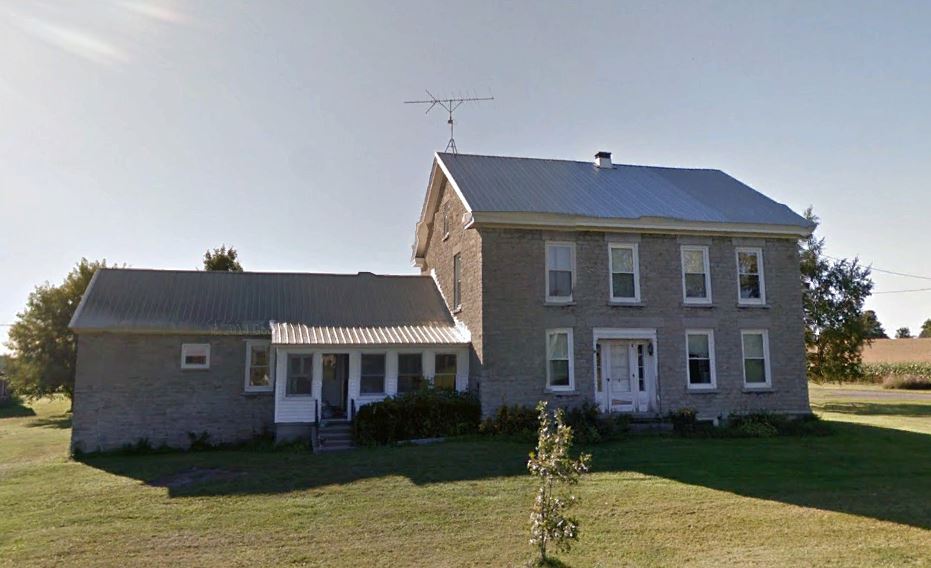
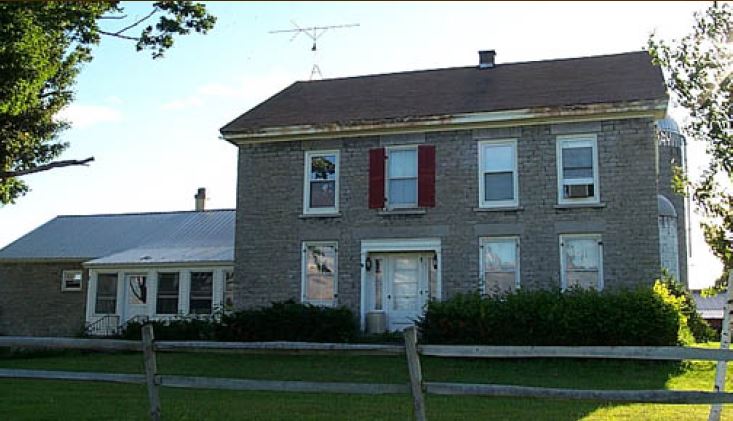
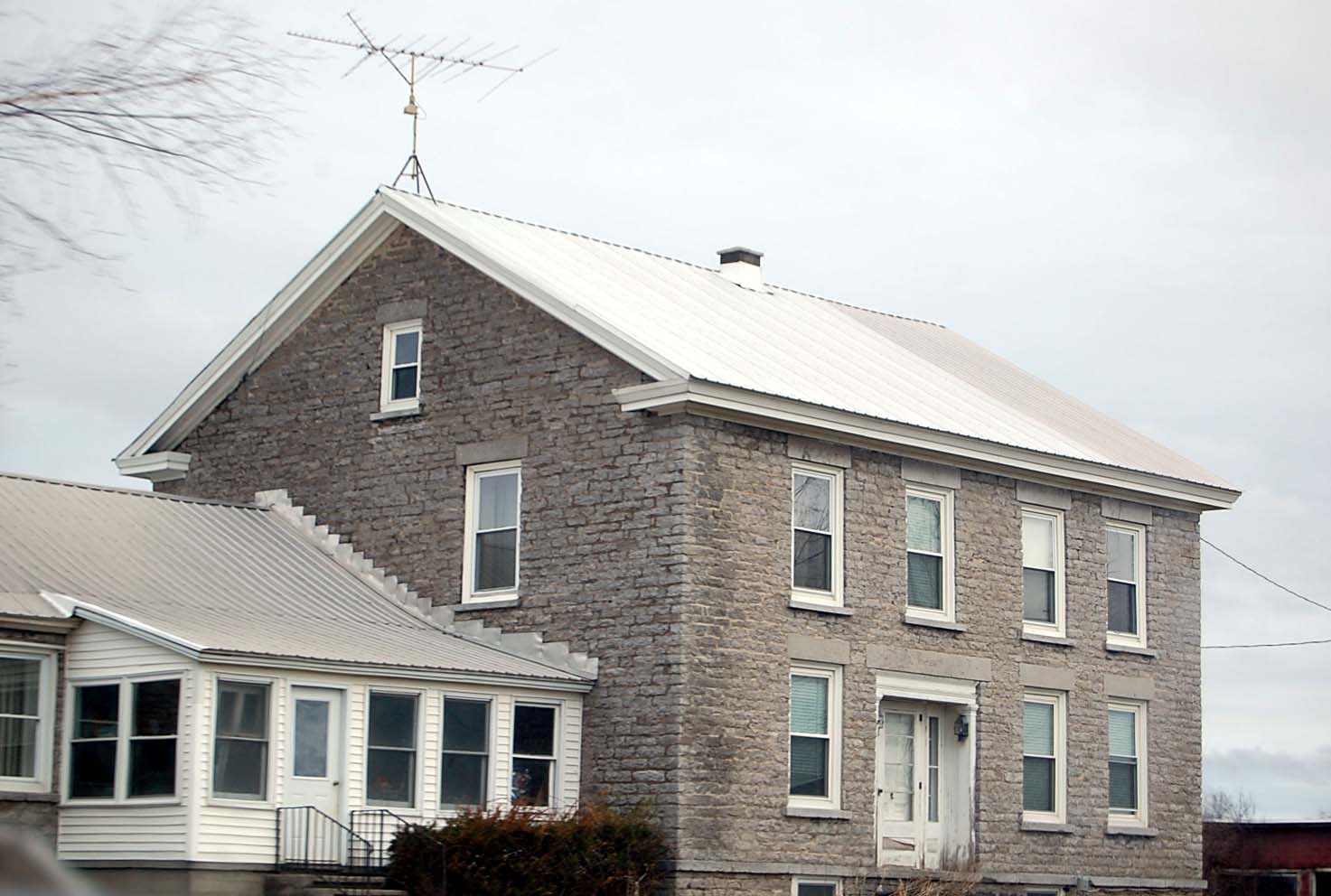
The beautiful old Alva Grow mansion, built of native limestone according to the Georgian manner, is located a short distance from Smithville on the road to Roberts Corners at a point where the Green Settlement-Henderson Harbor road intersects. It is said to have been constructed by E Lyons in 1839 and since May 15 1893 has been owned and occupied by Miss Jane C Church, who has a tenant work her 270 acres.
Alva Grow, the original owner of the house, came to this county from Vermont in 1806 and was one of the early town of Henderson settlers. On September 13 1823 he purchased 125.65 acres of the farm from Isaac and Anne Bronson of Fairfield, CT, for $800 and later caused his spacious mansion to be built. The stone came from a quarry a little way to the eastward and E Lyons and brother, of the family for whom the nearby Lyons Corners was named, were the builders. Many of the fine old stone houses in that section of the county were constructed by them, including that of Miss Amy Griffith a few miles away.
Under the will of Alva Grow, who died in 1856 the house and two parcels
of farm lands were given to his son, John B Grow, whose wife was Adelaide
Church, aunt of the present owner. However, Alva Grow provided in his
will that his daughter, Orissa, should have the two chambers, one ten
feet square and one 14 feet square, which she had occupied in the house,
to use the rest of her life or until she married. She ultimately married
a man named Webb and resided in this city.
An interesting feature of the provision made for her in the will of Alva
Grow was that she was to have the right to use one-eighth of the woodshed
to store fuel to heat her rooms, was to have right of ingress and egress
through the house to the rooms, have two bedsteads with feather and underbeds
and complete summer and winter bedding, one bureau, one looking-glass,
one light stand, one wash stand, six chairs and furniture plus $1,500
in cash to be paid within a year.
John B Grow occupied the house and operated the farm for about 40 years and died in January 1895. There was a short interim in 1877 or 1878 when he sold the property to Harrison York, but took it back again about 1880. His wife, the former Adelaide Church was for nine years governess in the family of William C Pierrepont, prominent North Country land agent and early railroad magnate of Pierrepont Manor. She died in May 1895 having survived her husband about three months. It was about two years before they died that they deeded the property to Miss Church, with whom they continued to reside until they passed away. Miss Church still possesses many of the beautiful pieces of antique furniture which the Grows had accumulated, some of it going back to 1839 when the stone mansion replaced the log cabin Alva Grow had erected when he cleared the land for his farm.
James Horton House on Point Salubrious
"Greystone" has proven a popular name for old limestone houses of Jefferson County. It has been applied to at least three of them including the old James Horton homestead, at Horton's cove, Point Salubrious, owned and occupied by Frank J Winslow since August 18 1925 James Horton was the first actual settler on the Point, having come there from Long Island in 1802. He purchased a tract of land from LeRay, cleared it and established a farm. That purchase was in the spring of 1807 and by April 1 he had a log cabin completed. In this he began the upbringing of a large family, and by 1819 he had become prosperous enough to build a fine stone house, which he finished that year and moved into. The limestone was quarried on the farm and neighbors helped Pioneer Horton with the construction.
For more than 20 years, from November 2 1903 to May 16 1924 this property was the summer home of Mrs Carrie Bagley Lansing, city, and her husband the late Stuart D Lansing, former president of the Bagley & Sewell company. In fact it was Mrs Lansing, who named the place "Greystone," after they had acquired and improved it, adding docks, a sea wall, boathouse, garage. In an interesting log, which he kept of "Greystone" Mr Lansing related that an old member of the Horton family had told him that the original woodwork and fireplace mantels were of exquisite beauty, wrought by an ex-British soldier who fought at the battle of Sackets Harbor in the War of 1812 deserted and remained on this side of the border.
By 1880 the house had become a deserted ruin, the roof had fallen in and the floors had become decayed, the Lansing log states, adding that the place had been called "the haunted house," and "the rookery." At some time during the middle history of the property it was acquired by the late Hiram Copley, who sold it to the late Hector Adams of Chaumont March 17 1894. Mr Adams employed Orrin Pomeroy to repair the house and it was then that the fine old woodwork and fireplace mantels were torn out and more modern installations made. It is possible that the third story of wooden construction was then added. Mr Lansing, in his log, deplored the doing of all this, it being out of harmony with the fine old colonial architecture; and when he and Mrs Lansing purchased it they restored the interior so far as possible, opening up fireplaces and providing suitable furnishings. But they were unable to duplicate the original woodwork, which Orrin Pomeroy had told Mr Lansing was the finest he ever saw.
The Lansings bought this property from Mrs William D (Grace Eleanor) Barron who had purchased it September 1 1900 as a summer home from Hector Adams. Mrs Barron then named the place "The Maples." The late Eli B Johnson remembered that when he was a child in the early 1860s the lower part of the house was occupied by the large family of William Henry Horton and the upper part by the large family of VanRensselaer Horton. In the first years of "Greystone," James Horton often entertained on Sundays the Dominee of the church, for which he had given the land and practically erected not far away.
The Hugunin House in Clayton
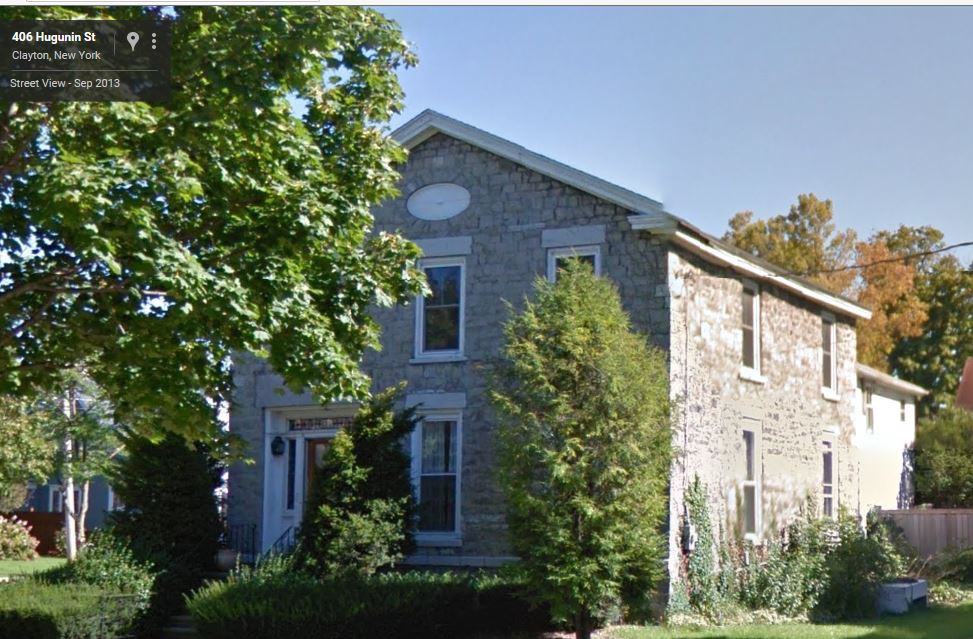
After the War of 1812 there set in the development of Great Lakes shipping
as the tide of population moved steadily westward. In 1816 the Canadians
launched the Frontenac, first steamship on Lake Ontario, and a few months
later the Americans commissioned the Ontario at Sackets Harbor, but the
building of sailing vessels did not cease. Sackets Harbor, Chaumont, Three
Mile Bay, Point Peninsula, Cape Vincent, Clayton and other places became
great shipbuilding centers. Clayton was one of the most important of these.
Shipbuilding began there in 1832 when Smith & Merick opened an extensive
lumber yard. Jesse Smith, founder of Smithville and Elbridge G Merick,
organized four years before as a lumber-rafting partnership, comprised
this firm and at times employed 100 men and produced as many as four ships
a year.
In 1841 John Oades came to Clayton as master shipbuilder for Smith & Merick and later for Fowler & Esselstyn. Oades was one of the best in the business. He constructed the largest and most costly ships on the Lakes and St. Lawrence in his time and after the Civil war moved to Detroit as did Fowler & Esselstyn. Smith had left Clayton in 1836 for Newark, OH. Prominent in the development of Great Lakes ships lines after the War of 1812 was the Hugunin family and for long years Clayton village has had its Hugunin Street.
Upon the southwest corner of Hugunin and Merick Streets there stands today a fine old stone house. It was standing on April 4,1836 when it was designated as Mrs Hugunin's stone house in a deed running from Jesse Smith to Eleanor Hugunin for the lot upon which it stood. That deed still referred to Clayton under its original name, Cornelia, and explained the location of the house at the corner of the street running southwest from the shipyard and a cross street running southwest and northeast. The latter eventually became Hugunin Street and the former Merick Street.
Whether Jesse Smith or the Hugunins built the house is not apparent from records thus far at hand. On November 6 1845 it was bought from Robert and Eleanor Hugunin for $1,000 by John Oades, the shipbuilder, who had come to Clayton four years previously. September 22 1869 Jane C Oades, wife of John, sold the property to Schuyler H Soper, who disposed of it October 3,1879 to John Swart. Other ownerships followed until Olin L Winslow acquired it about 30 years ago. He retained possession until October 3 1940 when he sold it to Louis G Phelps, Clayton, the present owner.
Hungerford Home at Rural Hill
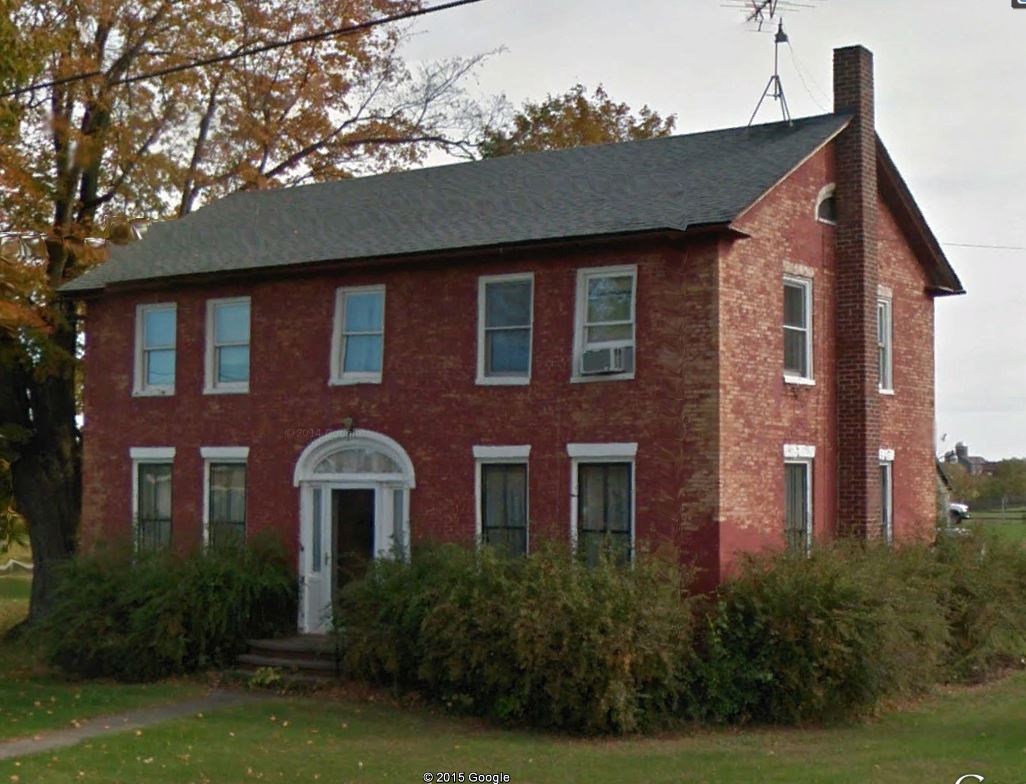
One of the most attractive of Jefferson County's old homes is the one
of red brick said to have been built in 1825 by Jedediah Hill at the four
corners which is the hamlet of Rural Hill in the town of Ellisburg. The
Belleville-Lake front road crosses the Woodville-Henderson road to make
the four corners and there Jedediah Hill was the first settler about 1815.
It is said that he was a Mormon a few years later, one of several that
embraced that belief in the 1830s. According to tradition his brick house
was built for a tavern with six rooms on the first floor, fireplace, bake-oven,
etc., and upstairs there was a ballroom with spring floor.
Jedediah Hill eventually transferred the mansion along with the farm, upon which it stood, to his son, Eben, and after a time Eben conveyed it to his brother, John. April 4 1836 John and Esther Hill sold the property, amounting to 66 acres, to Amasa Hungerford, one of the best known early residents of Ellisburg. When Amasa Hungerford, died June 10 1848 the mansion and farm went to his son Philo in the resulting distribution of the estate
But before that there were born in the house twin boys May 25 1844 Amasa and Anson A Hungerford, sons of Mr and Mrs Philo Hungerford. Both lived to a ripe old age, being substantial and well known residents of this county. Anson died June 28 1927 aged 83 and Amasa passed away November 14 1936 in his 93rd year. Philo Hungerford owned and occupied the property until his death early in 1882 and provided in his will that the homestead should go to his son, Amasa.
There was a condition imposed in the will that Amasa should permit his sister Laura to reside there, at least until she married, and give her half the produce. Amasa never married, but Anson did, fought in the Civil war and resided several years in the south, but on August 18 1910 purchased the property with its 66 acres from Amasa. On December 25 1923 Anson Hungerford disposed of the place to George A Bull, who retained it until March 30 1929 when he sold it to G Bruce and Ella L Wilson, the present owners.
Because of the long Hungerford ownership it has always been known during the past 100 years as the Hungerford home. The first of the line to settle in Jefferson County was Amasa, who located in Henderson in 1810. The wife of his son, Philo, was Caroline Davis, aunt of Cushman Kellogg Davis, noted Minnesota Republican statesman, who was born in Henderson June 16 1838 became governor of Minnesota in 1873 and United States senator in 1887. It was in 1898 during the end of his senatorial service that he sponsored the resolutions amounting to a war declaration against Spain. He died November 27 1900 descendant of Robert Cushman, financial agent who fitted out the Mayflower and Speedwell, Puritan ships of 1620 fame.
Miss Hazel Hungerford, prominent Belleville teacher, resided in the old Rural Hill mansion during the several years ownership of her father, Anson Hungerford. Her aunt, Laura, became Mrs Calvin Littlefield, long a resident of The Maples on the Rural Hill-Belleville road.
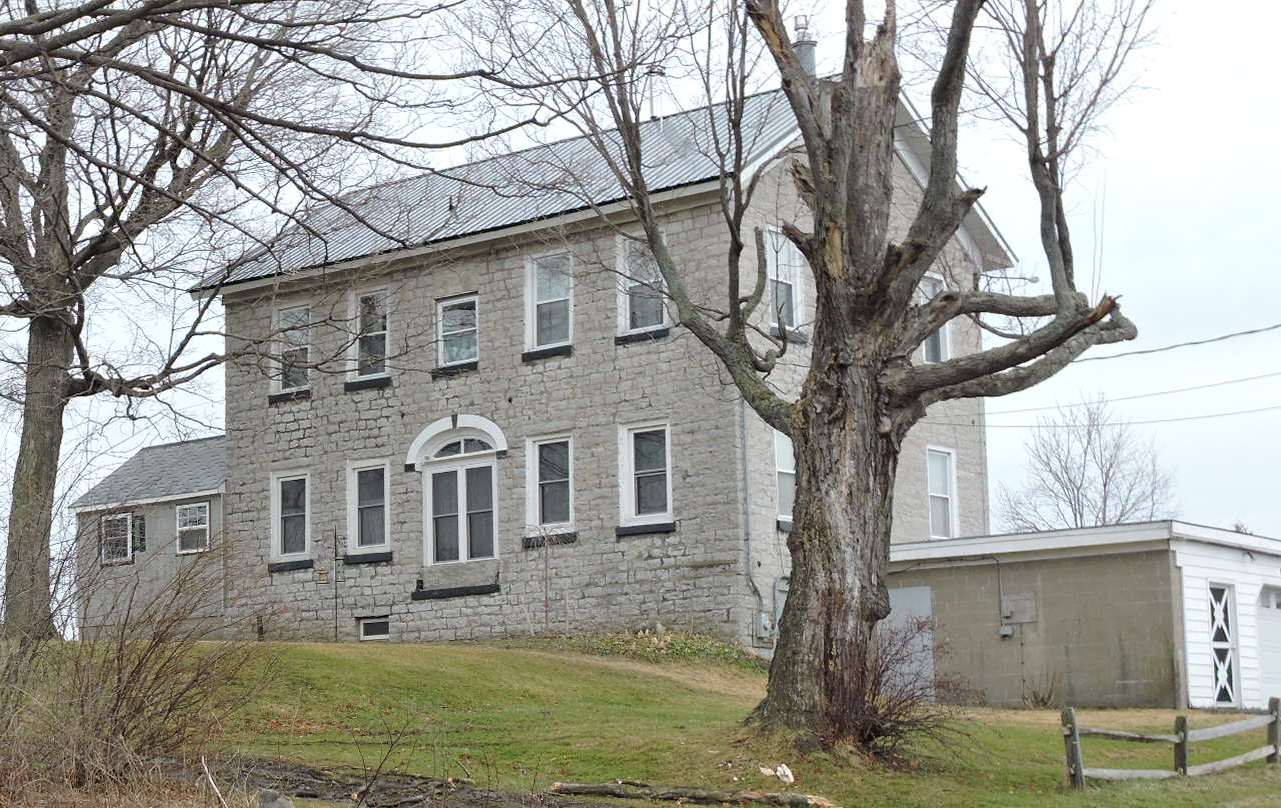
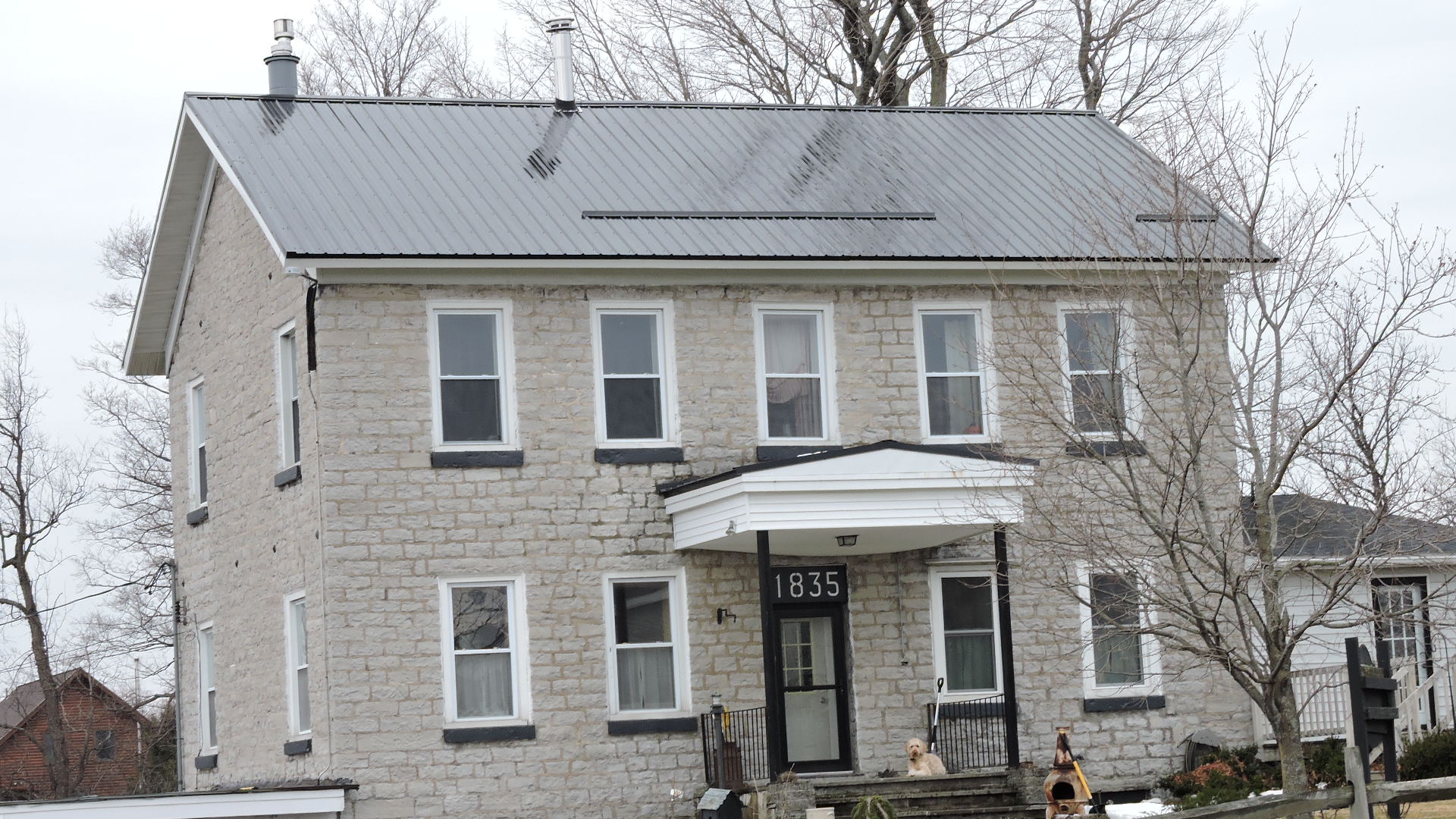
Old Gates Home on Perch Lake Road
A native limestone house on Georgian colonial architecture, owned and occupied since March 1 1937 by Mr and Mrs Lloyd H Niles, possesses the unusual feature of two front entrances exactly alike, one on either side of the house and connected by a central hall that runs straight through. The house is believed to be approximately 120 years old and possibly is older. It is located in the town of Pamelia on the Perch Lake road at the intersection of a town road that heads toward Depauville. Originally the latter road passed the house on the side opposite from which it now does to connect with the Perch Lake road. This shifting of locations of the road is responsible for the two front entrances to the house.
The house is said to have been built by Roswell Gates in 1834 or 1835 but on July 19 1825 Roswell Gates purchased 110 acres of the site from Vincent LeRay for $1,500. This price might be reasonable ground for assumption that there was at the time a house standing upon the land. June 20 1826 Mr Gates paid the Mechanics Fire Insurance company, of New York, Vincent LeRay, attorney, $360 for an adjoining 60 acres and later 33.26 more acres were added. The Gates ownership continued until April 3 1854 when Bernard Bagley, Watertown, one of Jefferson County's famous early lawyers, who had been supervisor of Pamelia in 1848-9 purchased the entire 203.26 acres and buildings for $6,500. Mr Bagley was the father of the late George A Bagley, one of the founders of the Bagley & Sewall company, and was grandfather of Mrs Virgil K Kellogg, Mrs Stuart D Lansing and Miss Madeleine Bagley. Mr Bagley and his wife, Zurviah, disposed of the place March 28 1860 to Robert Fenner of LeRay for $6,000. At the end of nine years Mr Fenner sold it to James Osborn of Brownville for $8,000 and on December 15 1877 the Osborns sold to Ichabod E Thompson of this city for $9,146.70.
But not long afterwards Mr Thompson became insolvent, went into bankruptcy, a mortgage on this property held by Gilderoy Lord of this city was foreclosed, Judge John C McCartin acting as referee and at the mortgage foreclosure sale. Mr Lord bid the property in for $6,805.49. Mr Lord, prominent Watertown industrialist, who operated a foundry and machine shop on Beebee's island, died intestate May 2 1891 leaving as heirs his widow, Lucina H, and daughters, Alice L Wheeler and Frances L Bennett. Mrs Wheeler died in April 1896 and Mrs Lord the following year. On August 23 1912 the remaining heirs sold this place to Walter B and William H Mills. On January 20 1936 The Federal Land Bank of Springfield, Massachusetts acquired title and March 1 1937 sold the buildings and 89.62 acres to Mr and Mrs Niles. Occupying a high site among the trees the mansion and location are most attractive.
103 Washington
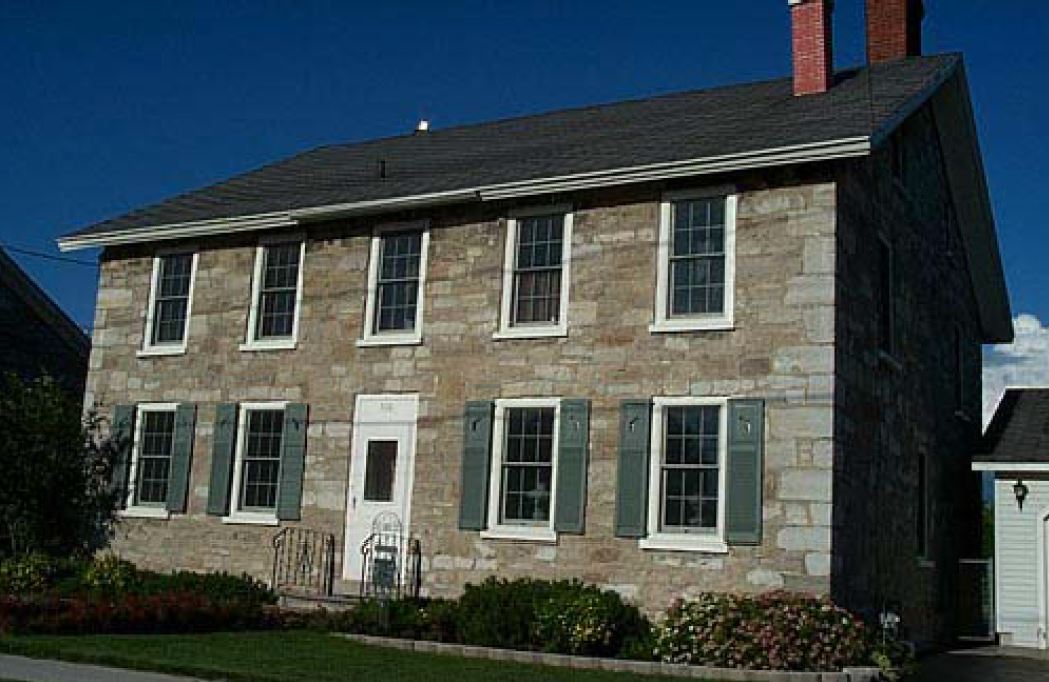
The Barrett Home in Brownville
Mark Twain Barrett, who is connected with the force of the Brownville
Paper company, owns and occupies this attractive old limestone house on
the east side of Church (formerly Washington) Street, Brownville. Mr Barrett
purchased the property October 22 1920 from Mrs Nellie Massey, Senickley,
Pennsylvania, sole devisee of Dr Frank W H Massey, who acquired it from his father,
Dr William Penn Massey. Dr William Penn Massey bought it from the Sarah
Parmenter estate August 27 1879, it having been transferred to the Parmenter
family March 18 1867 by the heirs of Western W Wager, prominent early
Brownville industrialist and business man. On March 29 1839 Mr Wager had
paid Charles Knap of New Berlin, Chenango county, New York, $1,000 for
it. Some years before that Knap had purchased this house and lot from
Luther Gilson, Joel Blood and Thomas Loomis Jr. Prior to that time for
a score or more of years most of the land in that locality from Basin
Street, which is the main street in Brownville, northerly along Philomel
creek, had been owned by Judge John Brown, brother of General Jacob Brown,
founder of Brownville.
Seen first by Jacob Brown in the spring freshet period of 1799 Philomel creek had determined the location of what is now the village of Brownville, for it was believed it would be valuable on account of its water power. And there where the creek crosses the present Basin Street to discharge into Black River the Browns and their associates established saw and grist mills and tanneries. The 1820s had been important in the development of Brownville. The Knaps had come in from New Berlin, General Thomas Loomis Jr had arrived from Otsego county John A Cathcart reached there from Rochester and all, along with Joel Blood and others were vitally interested in the prime industries. Tracy Knap operated a tannery, grist mill, oil mill and white lead factory for the production of lithic paint, but became an invalid and his brother Thomas K Knap came on in 1829 to assume management of these projects. He remained, however, only until 1851 when he went to Pittsburgh, Pennsylvania, to join his brother Charles in the Fort Pitt Iron Works. John A Cathcart came in 1828 having invested $10,000 in a cotton factory, but lost the money and engaged in the mercantile business. Loomis operated a tannery, shoe shop and distillery and later manufactured saleratus. When the village of Brownville was incorporated April 5 1828 he became the first president and Tracy Knap one of the first trustees. A few years afterward Blood and Thomas Knap were presidents. The Knaps, Cathcarts and Bloods resided in the same neighborhood where Mr Barrett's house now is and not far away was the General Jacob Brown mansion.
Mr Barrett has kept his house near to the attractive original state. The interior consists of nine large rooms with fine old woodwork and formerly there were fireplaces. Running along the stairway in the front hall are long narrow cupboards for gun storage, a unique provision. Above the second story is a spacious attic the full size of the main part of the house.
The Maynard Home on Tibbets Point Road near the Lighthouse
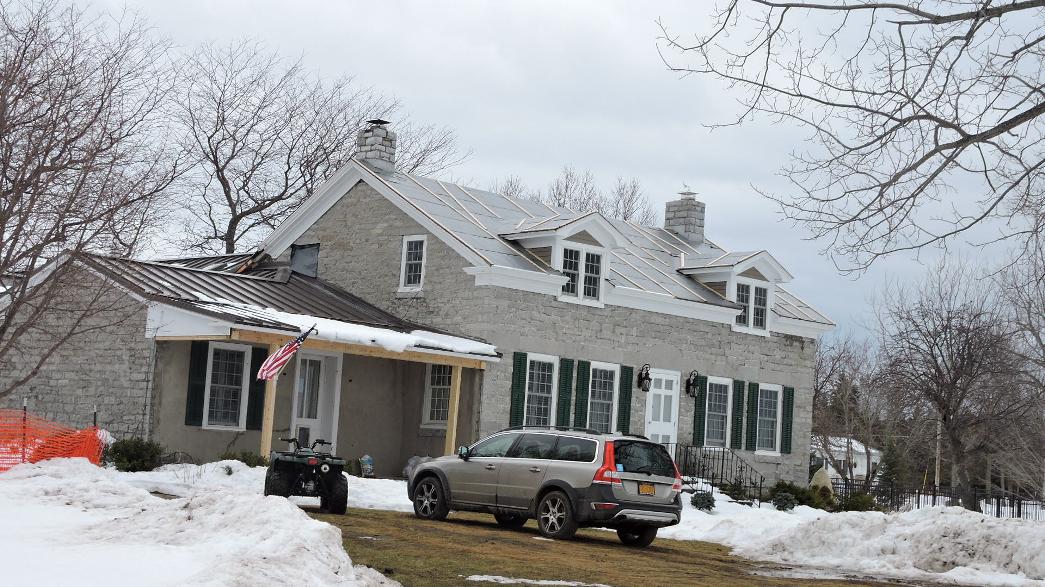
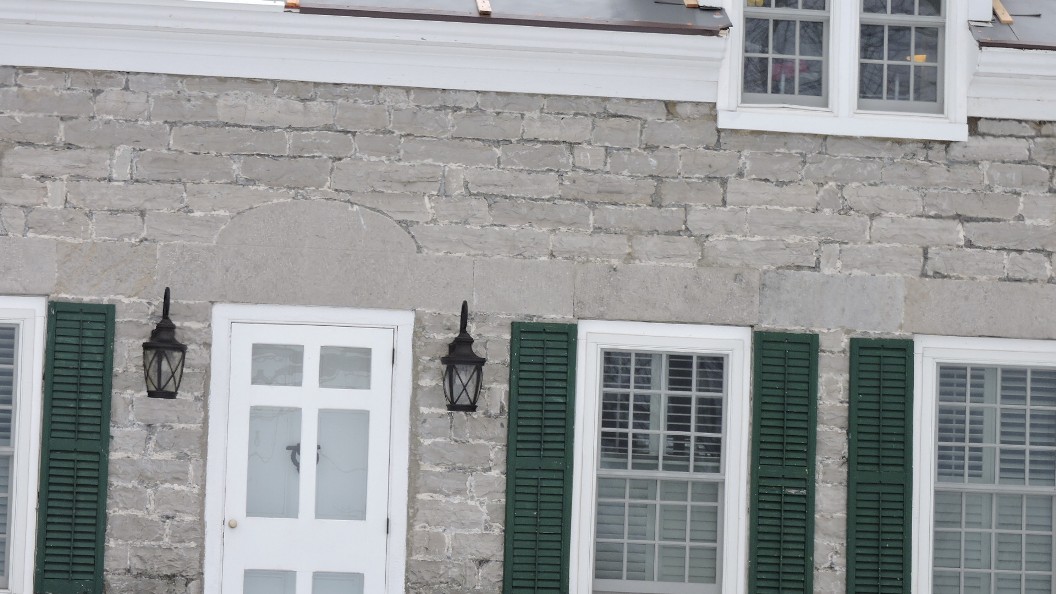
Like a beautiful painting on the backdrop of a theatrical stage is this pastoral setting on the Tibbets Point road up the lake shore from Cape Vincent village. Well-kept grounds with old-fashioned flowers bordering the stone walk that leads from the highway to the front door of the quaint old stone house instantly attract the attention of the passerby. The house, simple, homelike, built of native limestone in the Georgian manner is of the cottage type.
It, and everything about it including the well-groomed trees in their natural locations, has the atmosphere of the well-kept. For 52 years it has been the home of Mr and Mrs John Maynard, nonagenarians who continue their residence there although they sold the property to J Reginald Newton, wealthy New Yorker, December 30 1939. There is something about the exterior of the house and immediate grounds, which is reminiscent of Mr Newton's Deer Lick Farm about two miles away near the Pleasant Valley road.
Situated only a short distance toward the village of Cape Vincent from the Tibbets Point lighthouse this farm of 171 acres, which borders the lake shore and faces towards Wolfe island, was purchased by Mr Maynard from Captain Coleman Hinckley Jr, on June 3 1892 captain Hinckley, who came from a well known line of lake men, bought the property from Charles Wilson on April 8 1880 the latter having owned it for a dozen and a half years.
The Wilson family was one of the earliest to settle along the lake front of Cape Vincent township and named for the family is Wilson's Bay just around to the other side of Tibbets Point. One of the parcels of land that go to make up the Maynard farm was acquired by Charles Wilson July 1 1862 from Sally Fuller, Phila Adelia Folger, Maria L Fuller, Theresa Natilla Hitchcock and Hiram O Hitchcock for $2,000. Two other parcels totaling 91.61 acres were purchased by him July 14 1862 from James G Wilson. There had been other ownerships before that including Calvin Keith Pool, member of one of the first families to settle Cape Vincent.
At least one of the parcels now included in the Maynard farm was owned by Benjamin Tibbets more than a century ago and on June 20 1835 was sold by him to Sylvia M Williams. There was a period also when Buel Fuller, one of Cape Vincent's first innkeepers, had owned a large part of this farm. Fuller had been a tavern-proprietor as early as 1822 and in addition he had taken a prominent part in the affairs of the town having been one of a commission that laid out a road from the old French church to the St. Lawrence river, and later having been named commissioner of highways when the town was set off from Lyme April 10 1849.
Old Hoover Tavern at Evans Mills
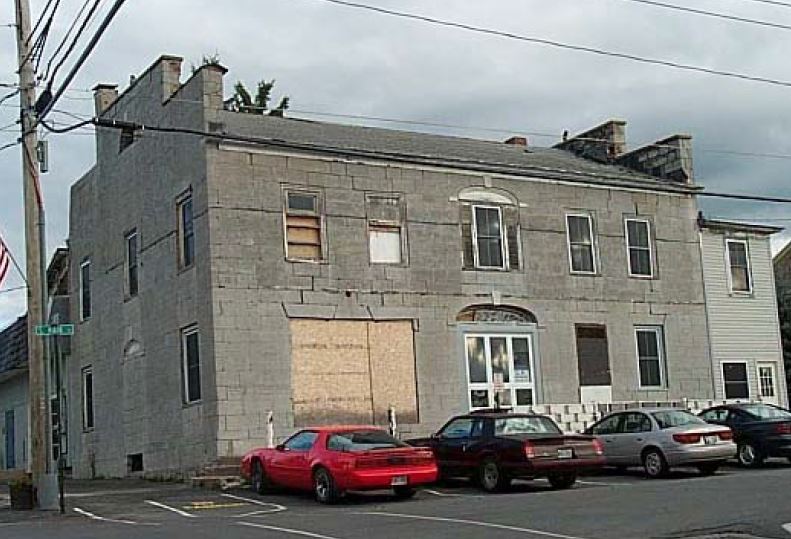
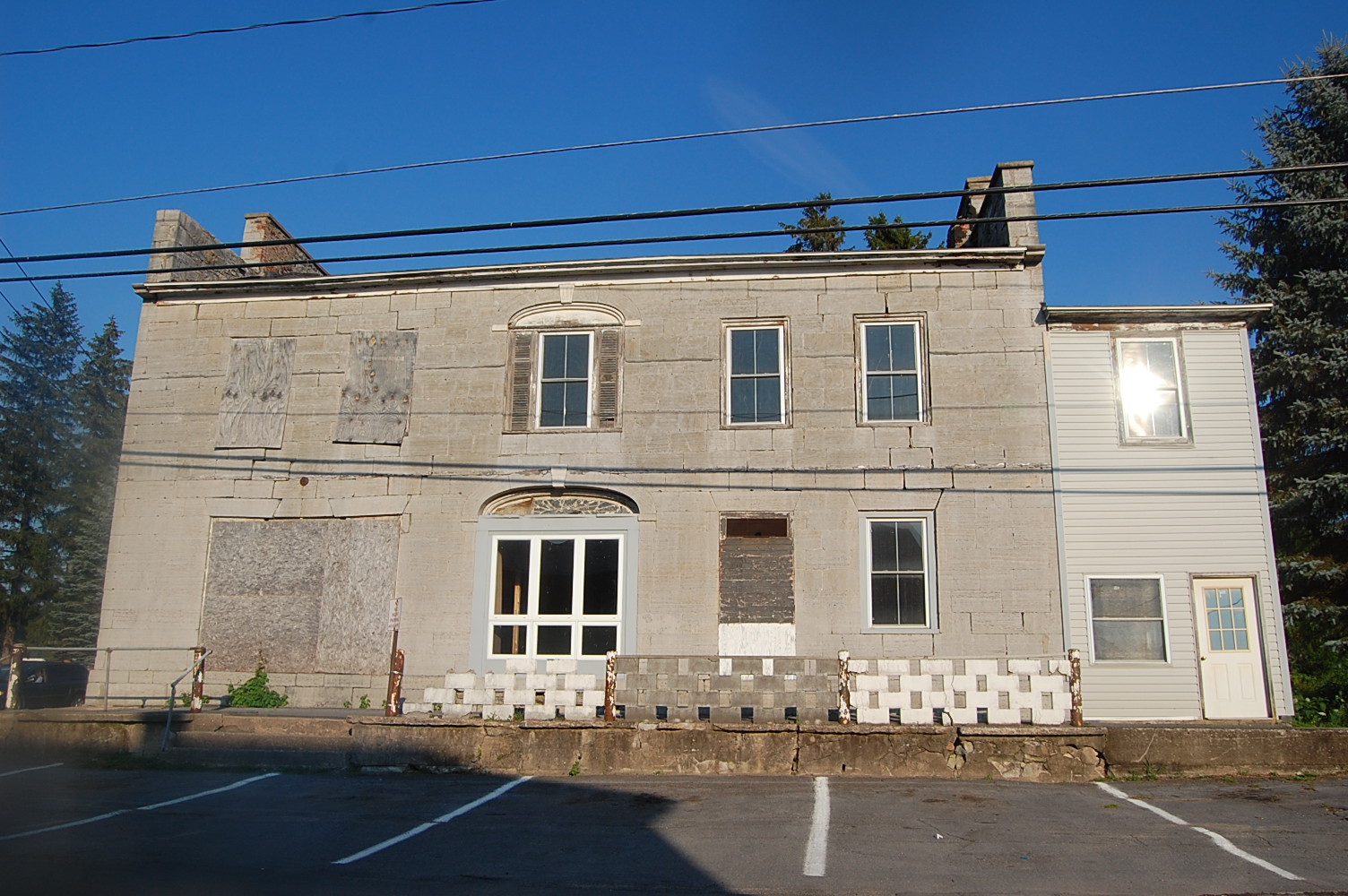
There is also another Brick Tavern established
1827 in Evans Mills called the John Hoover Inn. (See below)
This one made the news because it received an Historic Marker:
One of the most famous old taverns in Jefferson County was the beautiful one built by Captain John Hoover at Evans Mills in 1821. Georgian colonial in type, prominent architects have declared it an unusually fine specimen and the construction both for quality of masonry, quality of limestone and fine craftsmanship in its cutting is unsurpassed in the entire North Country. It stands on the main street en route into Evans Mills from Watertown and is on the southeast corner where the street to LeRaysville intersects.
Directly across this main street and facing the old stone tavern is the old brick tavern built by Captain Hoover in 1827. (see photo above)
Captain Hoover was a noted upstate landlord in his day and there used to be a saying: "Heavens Mills where Jehovah Kept Tavern," being a play upon his name and the name of the village. The latter place was named for Ethni Evans, the New Hampshire millwright brought to this county by General Jacob Brown to get industries and communities started. After a time Evans Mills was changed to Evansville, but later was changed back to Evans Mills, a name which has been applied because Evans constructed a dam there and in 1806 erected some mills. Most of the stone for the old tavern was quarried on the former H N Eddy farm in the northern part of LeRay.
Josiah Fuller was the stone mason, who laid up the walls and the carpentry work was performed by William Delaware. Landlords who followed Captain Hoover were Daniel Thomas, George Oaks, Parker Rulison, Elisha Root, Alexander Lapon, Nelson Clarke and Benjamin Jackman. After Jackman disposed of it, it was discontinued as a tavern and operated by William H Childs as a distillery for a time. On August 18 1865 it was purchased from the Childs estate by Fred Waddingham for $1,400 and operated as a harness shop and saddlery by him until June 13 1884 when he sold it to Wesley Rulison. On August 3 1913 Anna Rulison sold it to the late Supervisor Floyd A Waggoner and January 27 1939 Mr Waggoner conveyed it to his son, E Sterling Waggoner, the present owner.
The first story is occupied by the owner's meat market and by O M Dougall's grocery, but the second floor has been converted into an apartment, which Mr Waggoner and his family occupies. With its excellently laid limestone walls the old building is as strong and square as the day it was completed and up to a century ago it was for more than 20 years the setting for some romantic North Country drama of those stagecoach days when the LeRays, the Parishes, Joseph Bonaparte and the LaFarges frequented this region.
The Kellow Residence in This City
John Avery Sherman, president of the Jefferson County Agricultural society in 1852 president of the Agricultural Insurance company from 1877 until his death March 25,1882 at the age of 73 outstanding benefactor of Watertown youth, owned and occupied this mansion for nearly 14 years.
It is located at the southeast corner of Stone and South Massey Streets and is designated 251 Stone Street. Prior to the present numbering system it was No. 43. The site was originally part of the holdings of Hart Massey, one of Watertown's first three settlers. September 1 1841 Hart and Lucy Massey, his wife, sold it to Thomas Baker, merchant, railroad contractor and agent for the Watertown cotton and woolen factory for $625. Baker is believed to have built the house at that time and on December 31 1846 joined with his wife, Laura, in selling it to Hiram Holcomb for $2,750. The textile industry, one of Watertown's most important early ones, began with the organization of the Black River Cotton & Woolen Manufacturing company, December 28 1813. A successor was the Watertown Cotton Mills company formed January 10 1834 with Hiram Holcomb one of its chief figures. Holcomb, a principal in other local textile companies of that period, sold the house for $3,000 May 1 1848 to Lawrence Hayes of New York City. Hayes became a grocer and produce dealer here and October 1 1868 disposed of the mansion to John A Sherman, native of Rutland, where he had been a prosperous farmer for some years prior to coming to Watertown.
Mr Sherman became the owner of Washington hall, which stood where the YMCA building now is and served not only as a business block and office building but Watertown's theatrical auditorium prior to the City Opera house in 1858. When he died, Mr Sherman willed Washington hall to the YMCA which had been organized January 18 1870 providing his widow a life annuity of $2,500. Eventually his residence, a frame structure of colonial design with two-storied portico having tall, graceful Doric pillars supporting an entablature highly ornamented with dentils and with conventional friezes in the cornices and architrave, became the property of the House of the Good Samaritan. That institution sold it to Thomas Bigham, local contractor and realtor in April 1903 and October 30 of that year Mr Bigham sold it to Dr William J Kellow.
Since Dr Kellow's death November 23 1936 it has been owned and occupied by Mrs Kellow. The facade of the mansion has long made it one of the most outstanding in the city.
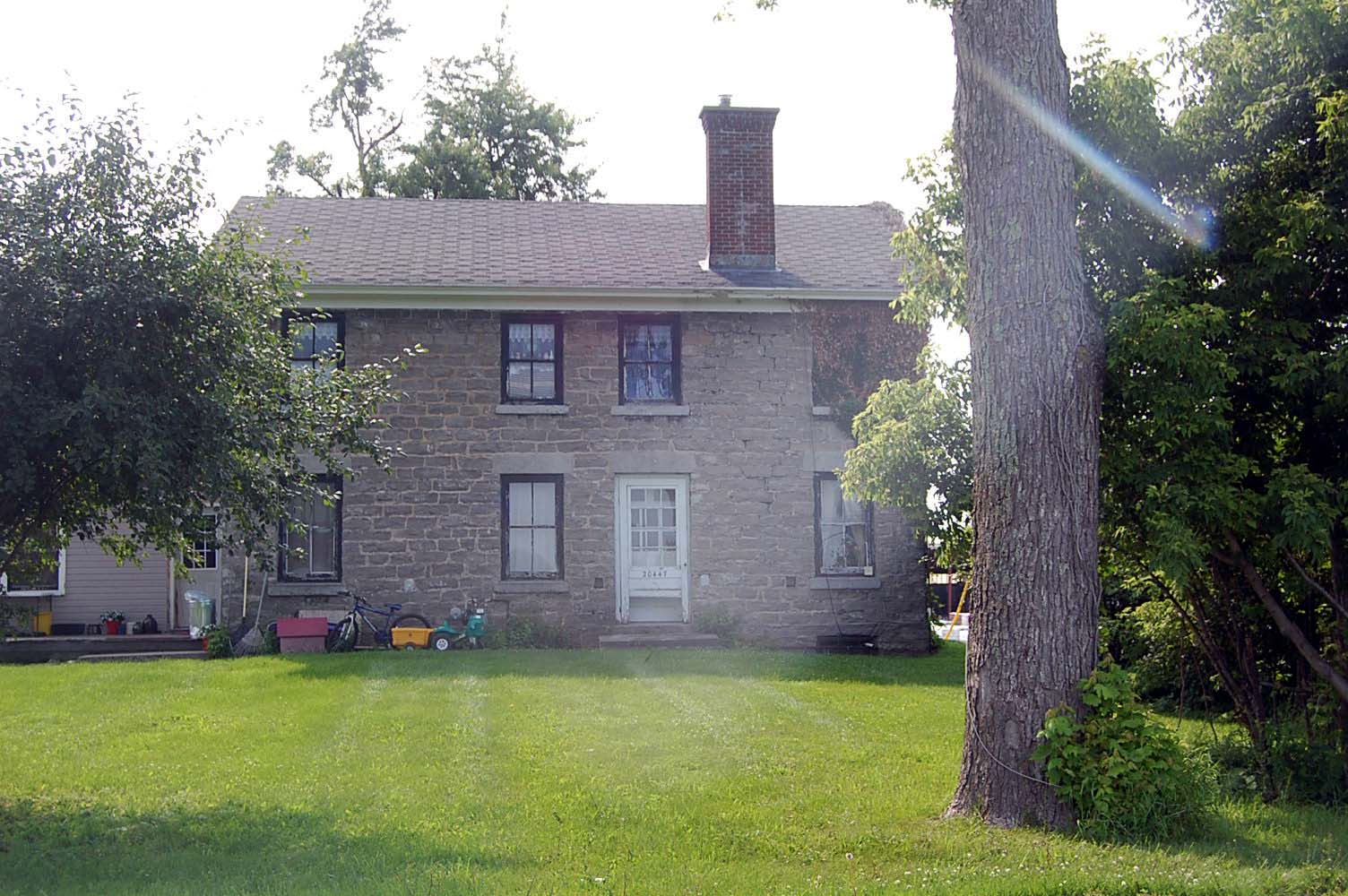
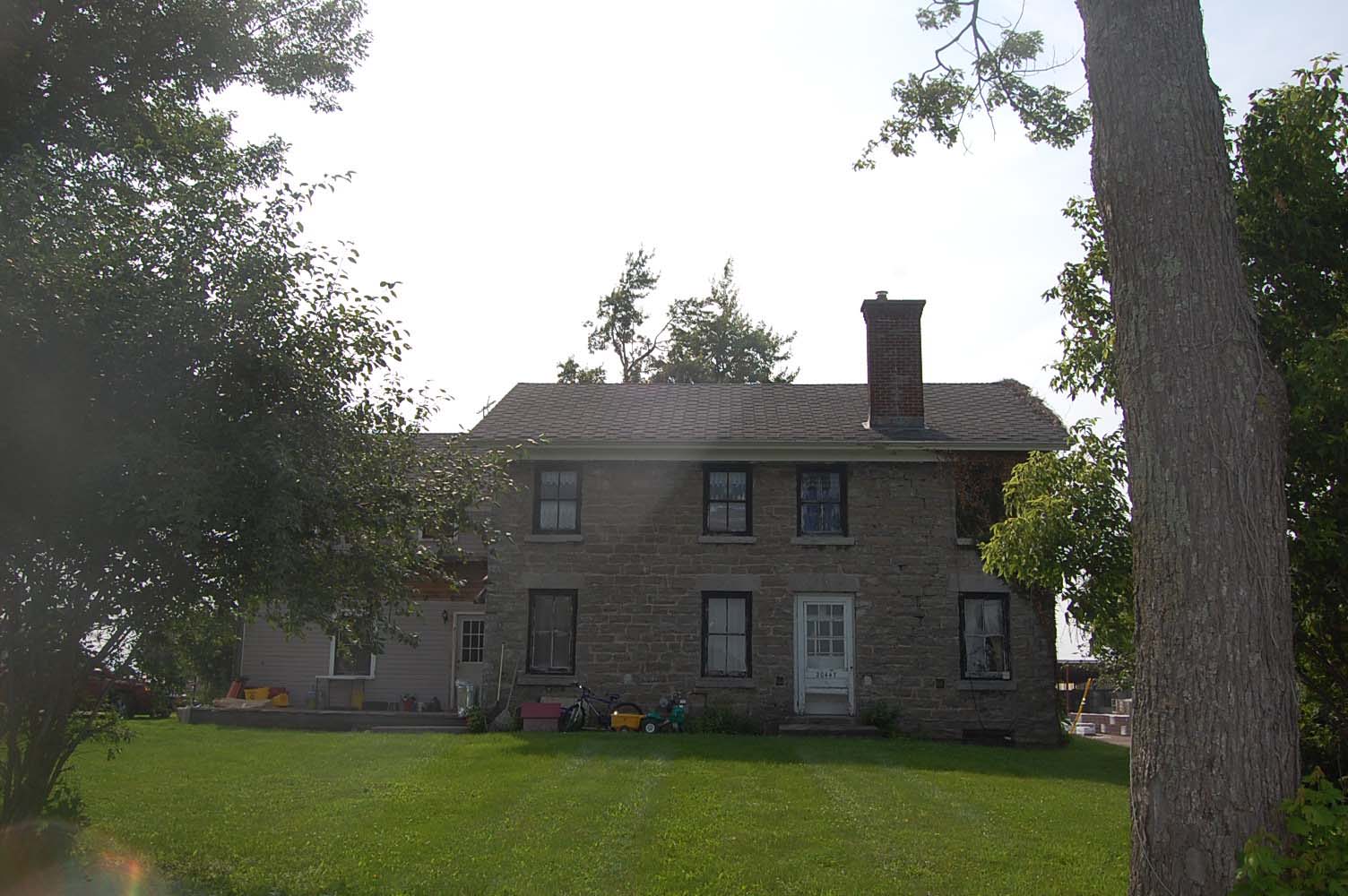
The Old Grow Home in Hounsfield
In the district of Hounsfield marked by the East Hounsfield Free Library a colony of sturdy Vermonters settled along the Watertown-Sackets Harbor road and the intersecting Rome state road about 135 years ago. Among them were the Allen, the Field, the Ayers and the Mattison families, not a few of whom came from Woodstock, Vermont, section.
Oliver Grow, another Vermonter, was a member of this colony. On March 23 1812 he paid William M Lord of Brownville $400 for 62 acres of land a short distance south of the present East Hounsfield library on the Rome state road. The stone house that now stands there as the residence of Mrs R Maude Brimmer Taylor, widow of Frank B Taylor, is reputed to have been built by Oliver Grow in 1813.
Later he added to his acreage. A direct descendant of Oliver Grow was Alonzo B Grow, former Adams supervisor, who died recently at Miami, FL.
During his residence there Oliver Grow became one of the influential men of Hounsfield and when the Watertown and Hounsfield Library was formed January 11 1831 made one of its first trustees. Mr Grow died in 1859 and his stone house and farm passed to his son, Oliver W Grow, who held it until December 30 1862 when he sold it to Martin Farrell of Hounsfield for $4,223.56. There was then 72.82 acres and Mr Farrell took possession March 1 1863. He retained it until March 3 1866 when he disposed it to George Phippen of Ellisburg for $5,800. From Mr Phippen the property eventually went to his son, the late John W Phippen, for several years Watertown water department superintendent during the municipal power development formulation.
After 19 years in the Phippen family this property was sold February 28 1885 to the late Marcus Taylor, father of the late Frank B Taylor and the late Mary E Taylor, who became the wife of the late Dr Orlando C Eastman of this city. The Eastman interest in the property was transferred to Frank B Taylor March 23 1905. Frank B Taylor worked the farm and for several years was agent for roadmaking machinery. He was born in March 1872 son of Marcus and Eliza Greenfield Taylor. Later he formed the Taylor Concrete Products, Inc with plant on the farm.
His son, Leland F Taylor, 191 Thompson Boulevard, city, manager, succeeded him as head of the company. Frank B Taylor, who had resided many years in this old stone house, from the days of his boyhood, became one of Hounsfield's leading residents. For several years he was president of the East Hounsfield Free Library and one of the principal figures in the Christian church at East Hounsfield. In 1932 he was appointed United States district court commissioner of jurors for the term of federal court that was held here that year. Mr Taylor died November 10 1942.
The frame wing on the house is decidedly modern in type. The stone portion or body of the house is Georgian. It has also been modernized to some extent
The Knowlton Home in This City
Built for Wooster Sherman, one of Watertown's early bankers, this mansion, now the residence of Theodore E Knowlton, president of Knowlton Brothers, Inc., has been owned by the Knowlton family for 62 years of its total 90. Designated as 167 Clinton Street, its sequestered location among tall, ancient sugar maples, far back from the road in the heart of a 3 1/4-acre lot, makes it a place of outstanding beauty. In fact it is the last of Watertown's large estates and occupies the southeast corner of Clinton and Sherman Streets. There, amid the complacent beauty and peaceful quiet, three generations have lived within three blocks of the city's heart.
Neither its architect nor its master builder are known to the present owners, but the builders may well have been the brothers Walter and Gilbert Woodruff, who constructed Washington hall about the same time.
Rising upon a high foundation of faced limestone blocks, the thick brick walls two and a half stories high are capped by a square roof, whose broad overhang is supported by heavy wooden brackets and whose top is surmounted by a large observation cupola. Designed for extensive entertaining the dining-room and kitchens were originally in the high basement, but after buying it for $15,000 from Receiver William H Kimball of the old Merchants Bank April 12 1882 George W Knowlton Jr, father of the present occupant, had them moved lo the main floor, with its beautifully wrought white woodwork and ceilings 14 feet high.
Artistic mantels of white Italian marble grace the fireplaces of the four large rooms on the main floor and the large bedrooms on the second floor. Above the latter are the rooms intended as servants' quarters. Through the middle of the main floor runs the broad hallway with its beautiful staircase winding up. From every side of the house the high, small-paned windows look out onto a beautiful scene. Originally the lot occupied all of the space on the east side of Sherman between Clinton and Mullin Streets, but George W Knowlton Jr, sold off a small site at Mullin and Sherman for the residence of the late Richard S Hungerford.
Wooster Sherman was born at Newport, NY April 28 1809. His father, Phineas came to Watertown in 1810 to take over the Gurdon Caswell paper mill, which he ran until his death in 1813. In 1839 Wooster was made cashier of Loveland Paddock's Bank of Watertown. Two years later he started Wooster Sherman's bank, the first private bank to circulate its own notes. Out of this bank developed the Merchants Bank, which failed in 1881. Sherman, who built a building and had his bank where the Watertown National Bank was until a few months ago, went bankrupt in 1876. In the fall of 1893 he founded and became treasurer of the Watertown Savings Bank, resigning in 1896 on May 15 of which year he died at 87 in his boarding house al 2 Hamlin Street.
George W Knowlton Jr born here in 1841 died March 17 1931 with a remarkable record as a banker industrialist North Country leader. With his brother John C, he formed Knowlton Brothers, fine paper manufacturers, in 1861 and headed it till his death. For many years he was president of the Watertown National Bank. He was president of the Ontario and St. Regis Paper companies and was president of the American Paper & Pulp association. His father, George Willard Knowlton, with Clark Rice took over the Gurdon Caswell mill in 1821. For 120 years the Knowltons have led in the New York state paper industry.
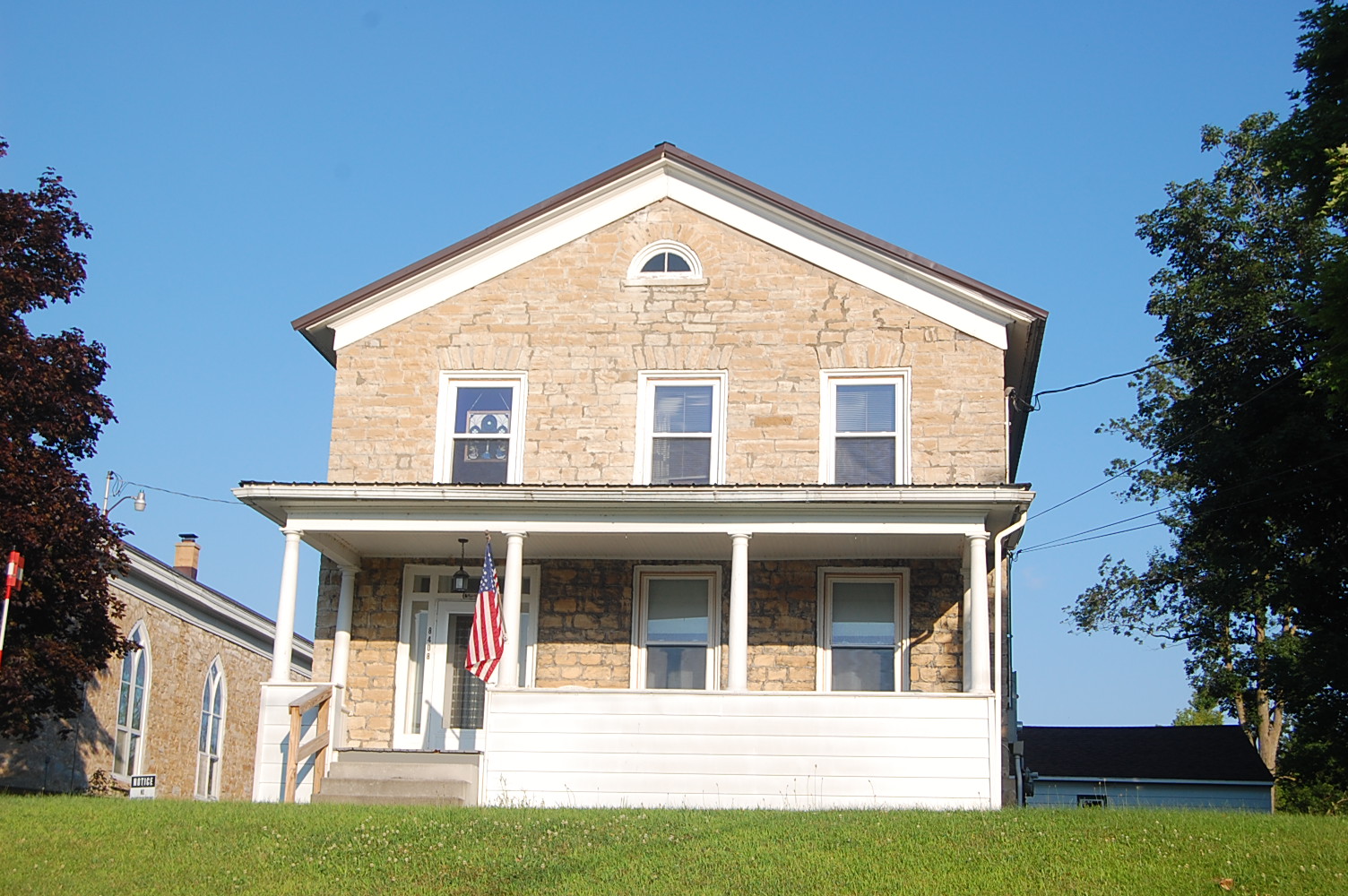
The Rectory at Evans Mills
St. Mary's Roman Catholic church in the village of Evans Mills is an attractive stone structure with an attractive Gothic-arched entrance and stands on the east side of Main Street perhaps a block and a half towards Watertown from the fine old stone tavern of Captain John Hoover. Upon a high-terraced lot adjoining the church is the rectory, occupied by Reverend Karlton J Dewey, pastor of St. Mary's. Both the church edifice and the rectory are constructed of native limestone, the church having been erected in 1847. However, the rectory, which may have been constructed about the same time or possibly before, was not built as a rectory for this church, having been acquired for that purpose about 25 years ago.
Designed in the Georgian colonial manner this house has been considerably modernized by the installation of new doors and windows and the addition of a verandah that extends across the front. In Civil War days the rectory of St. Mary's was the residence of Thomas Ingerson, member of a prominent Evans Mills family, for which the little hamlet of Ingerson's Corners about two miles away from that village had been named. Later the property passed out of the ownership of the Ingersons and on March 7 1874 it was purchased by Mrs Sarah R Priest, wife of the late "Major" Brayton G Priest, a veteran of the Civil War, who was long a popular figure not only in Evans Mills but in the Republican politics of Jefferson County.
Brayton G Priest's affiliations with the Republican party were of a strength, which caused them to be recognized by clerical appointments at Albany. These he held for a number of years. Then in his late years he is said to have served as a guide about the capitol. However, Mr Priest and his wife died several years ago and the property passed into other hands, St. Mary's church acquiring it about 1920. Dates of the construction and various ownerships are elusive so far as the public record is concerned. Neither does there appear to be definite data available in this record regarding the Ingerson and Priest owners of this house, which doubtless played an interesting role in the life of Evans Mills 75 to 100 years ago. At one time it was used as an academy.
The Eckert House at LaFargeville
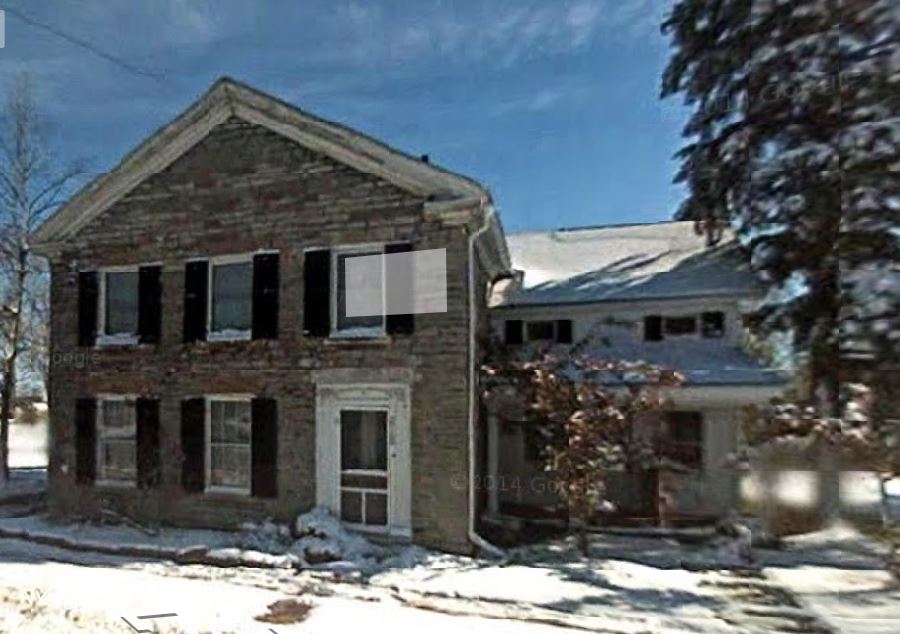
An atmosphere of serenity gently envelops the old stone house of Mrs Lena Rebscher Eckert at LaFargeville. Probably over a century old, it is Georgian colonial somewhat altered and modernized, has a high basement hewed out of the solid rock and its walls are wrought of native limestone. It is located on the east side of Main Street next to LaFargeville's business district and its back lawn and garden sweeps down to Catfish creek. This house is next door to the old Russell B Biddlecom mansion now owned by Dr Thurston Haller, in fact it was also at one time owned by Mr Biddlecom, former assemblyman, county clerk, attorney and business man. The old house is best known for its Budlong ownership. Gideon Budlong a wealthy and prominent town of Orleans farmer and landowner having purchased it June 30 1875 from Russell B and Martha Ann Biddlecom.
Gideon Budlong was the grandfather of Dr L S Budlong and Mrs J R (Marion) VanAmber of this city, and was the father of the late Gideon M Budlong, a leading Watertown photographer half a century ago who later moved to Bridgeport, CT, and died there February 21 1920. Gideon Budlong Sr who died at LaFargeville May 17 1882 came from a fine old Dutch family. A life-use of his house went to his widow and after her death it was inherited by their daughters, Lucy and Salome, the latter of whom was married to H C V Waldemar Hansen, a Dane.
Although 125 years old LaFargeville, originally known as Log Mills, was not settled as early as some Jefferson County communities. The first frame house was not erected there until 1823 and in 1828 was built on the west side of Main Street the stone building, which became land office and residence of John LaFarge for a time until his large mansion was constructed. The site of the Budlong house, across Main Street from the land office, which for many years has been a hotel conducted under the name of The Orleans House, was part of LaFarge's extensive landholdings.
There is the possibility that the house may have been built for him for the use of some of his retainers. At any rate it was part of property sold by LaFarge to Jacob S Irwin February 24 1855 and later it was acquired by Cornelius and Mary Bort, who are said to have sold it to the Biddlecoms towards the close of Civil war days.
Frank Gurnee as administrator of the Budlong sisters' estate sold the property to L Marie Strough May 28 1929 and on January 2 1930 she disposed of it to Mrs Eckert and her late husband, E Harold Eckert. At the time of the Budlong sisters' estate was settled in July 1927 a sale of the Budlong antiques, which furnished the house, was held. There were a number of fine pieces including some fine carvings by H C V Waldemar Hansen, the husband of Salome Budlong.
NOTE: Right next door to this stone house sits another one, not mentioned in these articles: